

Writing Dialogue [20 Best Examples + Formatting Guide]
Have you ever found yourself cringing at clunky dialogue while reading a book or watching a movie? I know I have.
It’s like nails on a chalkboard, completely ruining the experience. But on the flip side, well-written dialogue can transform a story. It’s the magic that makes characters leap off the page, immersing us in their world.
As a writer, I’m fascinated by the mechanics of great dialogue.
So here are 20 of the best examples of writing dialogue that brings your story to life.
Example 1: Dialogue that Reveals Character

Table of Contents
One of the most powerful functions of dialogue is to shed light on your characters’ personalities.
The way they speak – their word choice, tone, even their hesitations – can tell us so much about who they are. Check out this example:
“Look, I ain’t gonna sugarcoat this,” the detective growled, his knuckles whitening as he gripped the chair. “You were spotted leaving the scene, and the murder weapon’s got your prints all over it.”
Without any lengthy description, we get a sense of this detective as a no-nonsense, direct type of guy.
Example 2: Dialogue that Builds Tension
Dialogue can become this amazing tool to ratchet up the tension in a scene.
Short, clipped exchanges and carefully placed silences can leave the reader on the edge of their seat.
Here’s how it might play out:
“Do you hear that?” Sarah whispered. “Hear what?” A scratching noise echoed from the attic. Sarah’s eyes widened. “It’s coming back.”
The suspense is killing me just writing that!
Example 3: Dialogue that Drives the Plot
Conversations aren’t just about characters sitting around and chatting.
Great dialogue should actively push the story forward. It can set up a conflict, reveal key information, or change the course of events.
Take a look at this:
“I’ve made my decision,” the king declared, the crown heavy on his brow. “We go to war.”
A single line, and the whole trajectory of the story shifts.
Formatting Tips: The Basics
Now, before we get carried away, let’s cover some essential dialogue formatting rules.
Think of these as the grammar of a good conversation.
- Quotation Marks: Yep, those little squiggles are your best friend. They signal to the reader: “Hey! Someone’s talking!”
- New Speaker, New Paragraph: Whenever a different character starts talking, give them a new paragraph. It’s all about keeping things easy to follow.
- Dialogue Tags: These are the little phrases like “he said” or “she replied.” Use them, but try not to overuse them. A well-placed action beat can often do a better job of showing who’s speaking.
Example 4: Dialogue that Creates Humor
Dialogue can be ridiculously funny when done well.
The key? Snappy exchanges, playful misunderstandings, and just a dash of absurdity. Consider this:
“I saw the weirdest thing at the grocery store today,” Tom said, “A woman arguing with a head of lettuce.” “Was she winning?” Lily asked, a grin playing on her lips.
You can almost hear the deadpan delivery, can’t you?
Example 5: Dialogue that Shows Relationships
The way characters speak to each other says a ton about the dynamics between them.
Is there warmth, hostility, an underlying power struggle? Dialogue can paint a crystal-clear picture. Imagine this exchange:
“You didn’t do the dishes again?” Sarah sighed, hands planted on her hips. “Aw, c’mon babe. I was busy,” Mike whined, avoiding her gaze.
We instantly sense the long-suffering tone from Sarah and the playful guilt from Mike.
Example 6: Dialogue with Subtext
The most interesting dialogue often has layers. What the characters say might not be exactly what they mean.
This is where subtext comes in – the unspoken thoughts and feelings bubbling beneath the surface.
Take this snippet:
“It’s a nice ring,” Emily said, her voice flat. “You don’t like it?” Mark’s brow furrowed. Emily shrugged. “It’s fine.”
Is Emily truly indifferent? Or is she masking disappointment, perhaps a sense of something not being quite right? Subtext makes us read between the lines.
Formatting Tips: Getting Fancy
Now, let’s spice things up with a few more advanced formatting tricks:
- Ellipses (…): These little dots are perfect for showing a character trailing off, hesitating, or searching for words. Example: “I…I don’t know what to say.”
- Em Dashes (—): These guys can interrupt a thought or indicate a sudden change in direction. Example: “I was going to apologize, but then — well, you’re still being a jerk.”
- Internal Dialogue: Instead of quotation marks, sometimes you’ll want to italicize a character’s inner thoughts. Example: Why did I say that? I’m such an idiot.
Cautionary Note
It’s important to remember: dialogue shouldn’t feel like an interrogation. Avoid rigid “question-answer, question-answer” patterns. Real conversations flow and meander naturally.
Example 7: Dialogue with Dialects and Accents
Regional dialects and accents can bring so much flavor to your characters, but it’s a delicate balance.
You want to add authenticity without it becoming a caricature or making it hard to understand.
Here’s a subtle example:
“Well, I’ll be darned,” drawled the farmer, squinting at the sky. “Looks like a storm’s brewin’.”
Notice how just a few word choices and a slight change in pronunciation hint at the speaker’s background.
Example 8: Dialogue in Groups
Writing conversations with more than two people can get chaotic fast. The key is clarity.
Here are a few tips:
- Strong Dialogue Tags: Sometimes, you need to be more specific than just “he said” or “she said”. Example: “Don’t be ridiculous,” scoffed Sarah.
- Action Beats: Break up chunks of dialogue with actions that show who’s speaking. Example: Tom slammed his fist on the table. “I won’t stand for this!”
Example 9: Dialogue Over the Phone (or Other Technology)
Conversations where characters aren’t physically together pose unique challenges.
You can’t rely on body language cues. Instead, focus on conveying tone and potential misunderstandings.
For instance:
“Hello?” Sarah’s voice crackled through the phone. A long pause. “Sarah, is that you?” “Mom? Why are you whispering?”
Instantly there’s a sense of distance and something not being quite right.
Example 10: Inner Monologue with a Twist
We often think of internal dialogue as a single character reflecting, but sometimes our inner voices can argue.
This can be a powerful way to showcase internal conflict.
Here’s how it might look:
You should just tell him how you feel, one voice chimed. Are you crazy? the other shrieked back. He’ll never feel the same way .
This creates a vivid picture of a character torn between opposing desires.
Example 11: Dialogue With a Manipulative Character
Manipulative characters often use language as a weapon.
They might use guilt trips, flattery, or veiled threats to get what they want.
Consider this:
“After everything I’ve done for you…” The old woman sighed, a flicker of disappointment in her eyes. “Well, I guess I shouldn’t expect gratitude.”
Notice how she doesn’t directly ask for anything, instead hinting at a debt, leaving the listener feeling uneasy and obligated.
Example 12: Dialogue Across Time Periods
If you’re writing historical fiction or anything with time travel elements, you’ll need to capture the distinct speech patterns of different eras.
Imagine this exchange:
“Gadzooks! What manner of contraption is this?” The Victorian gentleman exclaimed, staring in bewilderment at the smartphone. “It’s a phone,” the teenager replied, barely suppressing a laugh. “Let me show you.”
This little snippet highlights the potential for both humor and linguistic challenges when worlds collide.
Formatting Tip: Dialogue Without Tags
Sometimes, for a rapid-fire or dreamlike effect, you might want to ditch the “he said” or “she asked” altogether.
It’s a bold move, but it can be effective if done sparingly.
Check this out:
“Where are you going?” “Away.” “When will you be back?” “I don’t know.” “Please don’t leave me.”
This creates a sense of urgency, the raw exchange forcing us to focus solely on the words themselves.
Example 13: Dialogue that Shows Transformation
A great way to showcase how a character develops is through shifts in how they speak.
Maybe they become bolder, quieter, or their vocabulary changes.
Let’s see an example:
Scene 1: “I-I don’t know,” Emily whimpered, cowering in the corner. Scene 2 (Later in the story): “That’s it. I’m not taking this anymore!” Emily declared, her chin held high.
The dialogue itself reflects her transformation from victim to someone ready to stand up for herself.
Example 14: Dialogue that’s Just Plain Weird
It’s okay to get strange sometimes.
Absurdist humor or unsettling conversations can add a unique flavor to your story. Just be sure it fits the overall tone.
“Do you believe in cucumbers?” the man asked, his eyes wide and unblinking. “Excuse me?” “Cucumbers, my dear. Agents of the underground vegetable kingdom.”
This immediately creates a sense of oddness and perhaps a touch of unease. Is this guy crazy, or is there something more going on?
Example 15: Dialogue with a Purpose
Remember, good dialogue isn’t just about being entertaining.
It should move your story along. Here are some functions dialogue can serve:
- Providing Exposition: Sometimes, you need to inform the reader of backstory or world-building details. Trickle information through natural conversation rather than an information dump.
- Foreshadowing: Subtle hints within a conversation can foreshadow future events or create a sense of unease for the reader.
- Revealing a Twist: A single line of dialogue can completely flip the script and reframe everything that came before.
Example 16: Dialogue with Non-Verbal Elements
So much of communication happens beyond just words.
Sighs, laughs, and gestures can add richness to dialogue on the page.
“I’m fine,” she said, crossing her arms and looking away.
Notice how the body language contradicts her words, hinting at inner turmoil.
Example 17: Silence as Dialogue
Sometimes, what isn’t said is the most powerful thing of all.
A pregnant pause or a character refusing to speak can convey volumes.
Imagine this:
“So, will you help me or not?” Tom pleaded. Sarah stared at him, her lips a thin line. Finally, she turned and walked away.
The lack of a verbal response speaks louder than any words could.
Example 18: Dialogue With Humorous Effect
A well-timed O.S. voice can deliver a funny remark or punchline, undercutting the seriousness of a scene or taking a moment in an unexpected comedic direction.
INT. CLASSROOM – DAY The teacher drones on about the causes of the American Revolution, his voice as dull as the worn textbook in front of him. KEVIN tries to stifle his yawns, failing miserably. STUDENT (O.S.) Is he ever going to stop talking? My brain just turned to mush. Snickers ripple through the class. The teacher pauses, a look of annoyance flickering across his face. Kevin shoots a desperate look towards the source of the O.S. voice.
- Timing is everything. The best comedic O.S. lines act as a witty reaction to something else happening in a scene. The student’s comment comes right as Kevin’s boredom peaks.
- Subverting expectations is funny. The audience expects the scene to continue with a stern reprimand for speaking out of turn, but the script doesn’t give us that. This leaves room for further humor.
- Consider the tone of the voice – sarcastic, matter-of-fact, or outright whiny? This adds to the comedic effect.
Example 19: Dialogue With Unexpected Reveals
Think of this as a surprise twist using O.S. dialogue.
The audience (and maybe even some characters) are led to believe one thing, only for an O.S. voice to reveal something completely unexpected, shifting the scene’s dynamic.
INT. POLICE INTERROGATION ROOM – NIGHTDETECTIVE HARRIS paces in front of a nervous SUSPECT. Photos of the crime scene are scattered on the table. HARRIS Don’t lie to me! We’ve got witnesses who saw you at the scene. SUSPECT I – I swear, I had nothing to do with it! I was… I was with my girlfriend. Harris leans in, a triumphant glint in her eyes. She claps her hands sharply, startling the suspect. WOMAN (O.S.) That’s a lie! He was nowhere near me last night! The suspect whips around. His face pales as we hear the sound of the interrogation room door swinging open…
- The power lies in the build-up. The initial dialogue and the characters’ reactions should lead the audience to believe one outcome, making the O.S. interruption all the more impactful.
- Consider who speaks the O.S. line. Is it someone the audience recognizes, or a totally new character whose identity becomes a new mystery?
- Play with the proximity of the voice. Is it right outside the room, adding to the dramatic reveal as the door opens, or is it more distant – perhaps a voice over an intercom – for an even more unsettling effect?
Example 20: Dialogue With a “Haunted” Feeling
Explanation: O.S. can be used to create an eerie or unsettling atmosphere, particularly in horror or psychological thrillers. This could be unexplained voices, creepy whispers, or sounds that hint at a supernatural (or simply unnerving) presence.
INT. OLD MANSION – NIGHTSARAH explores the abandoned mansion, flashlight cutting through the thick dust. Cobwebs cling to every surface. A faint WHISPER drifts through the air, seeming to come from everywhere at once. Sarah freezes. VOICE (O.S.) Get out… leave this place… Sarah’s breath catches in her throat. She hesitantly follows the direction of the voice, her flashlight beam trembling.
- Less is more. The vaguer and more inexplicable the O.S. voice, the more chilling it becomes.
- Layer sounds for a full creepy effect. Combine whispers with unexpected bangs, creaks, or the faint sound of footsteps following behind Sarah.
- Play with audience expectations. If the script initially leads the audience to think the house is merely abandoned, the O.S. voices become that much more terrifying.
Here is a good video about writing dialogue:
Additional Dialogue Tips & Tricks
- Read Your Dialogue Aloud: This is the best way to catch awkward phrasing or unnatural rhythms. Our ears often pick up on what our eyes might miss.
- Less is More: Don’t feel the need to have every single interaction be profound. Sometimes a simple “Hey” or “Thanks” can do the job just fine.
- Eavesdrop: Paying attention to real-life conversations is fantastic research. Note the pauses, the filler words, the way people interrupt each other.
Final Thoughts: Writing Dialogue
Phew! We did it!
Does that feel like a solid collection of dialogue examples? We haven’t covered absolutely every scenario, but I hope these illustrate the vast potential within dialogue to bring your stories to life.
Read This Next:
- How To Use Action Tags in Dialogue: Ultimate Guide
- How Do Writers Fill a Natural Pause in Dialogue? [7 Crazy Effective Ways]
- Can You Start a Novel with Dialogue?
- How To Write A Southern Accent (17 Tips + Examples)
- How to Write a French Accent (13 Best Tips with Examples)
- Dialogue Writing
Dialogue Writing - Style, Format and Examples
Are you a good speaker or a great listener? If you are, you should have definitely come across multiple instances where something you said or you heard someone say stuck to your mind. This happens mainly because those words touched your heart or made you think. That is the effect of a good dialogue. Even a simple conversation with your family, friends or even an unknown group of people can give you ideas and thoughts to ponder on.
This article will introduce you to the art of dialogue writing and give you information about all that you need to know. Furthermore, go through the sample dialogues and analyse how they make an effect.
Table of Contents
What is dialogue writing, the purposes of writing a dialogue, inner dialogue, outer dialogue, basic format and structure of a dialogue, punctuation, what not to do when writing a dialogue – points to remember, dialogues from stories and plays, dialogues from movies and tv shows, frequently asked questions on dialogue writing in english.
The term ‘dialogue’ is something all of you would be familiar with. As social beings, people (irrespective of being young or old, male or female) communicate with each other. Such a communication where both parties involved in the conversation have something to say about the topic being discussed can be said to be dialogue. A dialogue can be on any topic – a very simple talk about a daily chore, a serious talk about a social or medical problem, a discussion about what has to be done for an event and so on. The only point that you should remember is that a dialogue isn’t just any conversation but a conversation between two people specifically.
The Collins Dictionary defines the term ‘dialogue’ as “a conversation between two people in a book, film, or play”. Transcribing a dialogue in writing or presenting a conversation in text is referred to as dialogue writing.
What do you think is the reason behind writing dialogues in a story, play or film? Is it mandatory to include dialogues in a story? There are stories where you have a third person narrator or one of the characters of the story presenting the story from their perspective. What difference does it make when there are dialogues instead of just someone narrating each and everything that is happening in the story?
Having dialogues along with stage directions instead of just narrations can be said to be a better writing technique as it gives the readers a clear picture of the characteristics of the various characters in the story, play or movie. It also gives your characters life, and above all, a voice of their own. Dialogues portray the emotional state, mindset, background information and attitude of the speakers. This will always be more effective as it would let the readers connect with the characters on a more personal level.
Dialogue writing is also one area where the writers get to be creative even to the extent of breaking some conventional grammatical rules. For instance, elongating a word or writing the whole word in capital letters or using multiple question marks or exclamation marks to stress on whatever is being said. For example: YESSSS!!
Another component of dialogue writing is adding stage directions. Stage directions are short phrases written in brackets that give the reader an idea of what the character is doing as they engage in the dialogue. For example: Dan (rubbing his eyes): I am still tired.
Types of Dialogues
Dialogues can be classified into two main types namely,
The term ‘inner dialogue’ refers to the individual character’s thoughts which are not spoken aloud; in other words, said to anyone else. They can be something a character is thinking as the other character is speaking and their thoughts about what is going on or what the other character is doing. These inner dialogues are not placed within quotation marks .
As the name suggests, ‘outer dialogues’ are thoughts that are spoken aloud. They refer to everything the two characters involved in the dialogue say to each other. Outer dialogues are usually placed with quotation marks.
Fundamental Rules to Be Followed When Writing a Dialogue
Dialogue writing can look and sound simple; however, when actually putting dialogue in writing, there are certain rules regarding the structure and format you need to follow. Go through each of these in detail in the sections given below.
Dialogues can be part of a story, a play or a movie. Each one has a different structure and format in which the dialogues have to be presented; however, there is a basic structure that can be followed. Go through the following points to learn the essential attributes a dialogue must have.
- The first thing you have to do before you write a dialogue is to decide who the characters are.
- You should also have a clear idea of the plot of the story, or in general, the context of the dialogue.
- Dialogues can be just a sentence, two or three lines or even a short paragraph. Whatever be the case, always remember that each character’s dialogue, no matter how short or long, has to be written on the next line. In other words, no two dialogues should appear on the same line. Also see to it that you indent each dialogue.
- If the dialogues are one-liners, you can write them one after the other. On the contrary, if each of your characters are speaking in chunks (short or long paragraphs), it is mandatory that you show the difference by using an optimum line spacing.
- Be very careful with the tense used in the dialogue.
- It is better to skip the small talk (including greetings) and start off with the point of discussion unless the small talk is crucial to setting the mood of the conversation.
In every form of writing, punctuation is an important factor that makes it sensible. In the same manner, dialogue writing also would not make any sense without proper punctuation. Learn how to punctuate dialogues by going through the following points.
- The first rule would be adding a colon after the name of the character to indicate that the particular character is the one speaking at the moment. Sometimes, a hyphen is used instead of a colon.
- The name of the character should always start with a capital letter as it is a proper noun. Sometimes, you will have characters such as villagers, student 1, student 2, etc. In these cases also, you will have to use a capital letter.
- Dialogues are to be placed within quotation marks.
- If you are including a character’s dialogue in another character’s dialogue, it has to be placed within single quotation marks. For example: “Don’t you think Rakesh saying ‘I will take the lead’ has some hidden agenda?”
- Also remember that any punctuation mark corresponding to the dialogue should always be placed within double quotation marks. For instance, if the dialogue is an interrogative sentence , the question mark has to come first marking the end of the sentence followed by the double quotation marks marking the end of the dialogue.
- When you insert the tag in the middle of the dialogue, make sure you close the quotation marks before the tag. The tag is preceded and followed by a comma . When you open quotation marks to continue the dialogue, see to it that you use a small letter to begin with if it is the continuation of the dialogue, and close the quotation marks once the dialogue is complete. For example: “Do you know”, he shouted to everyone, “who the new manager is?”
- If the dialogue tag is positioned in the beginning of the sentence, see to it that you start it with a capital letter as you are starting a new sentence. Place a comma after the dialogue tag followed by open quotation marks, the dialogue starting with a capital letter followed by the punctuation mark of the quote and close quotation marks. For example: Josh mumbled, “Nobody understands the main problem here.”
- A dialogue can also appear at the end of the sentence. In this case, the quotation comes first. Once you punctuate the quote and close the quotation marks, place the dialogue tag. Note that the dialogue tag is not capitalised. For example: “Are you coming with us?” Sarah asked.
- If a character’s dialogue is being interrupted by another character, use a dash to indicate the interference. For example: “I was wondering –”
“Are you ready to go?”
- Actions and body language of characters can be described in sentences and they can appear in between dialogues. For example: “I am not interested.” She shrugged her shoulders. “But, I will do it just for you.”
Now that you know how to write a dialogue, let us also look at what all you are not supposed to do when writing a dialogue.
- Using dialogue tags does give some clarity about the action and body language of the characters, but see to it that you do not use dialogue tags with every single dialogue. Also, make sure you don’t use too little.
- Using colloquial language is allowed in dialogue writing, but use them only if it matches the context.
- Dialogues need not be grammatically correct all the time. That does not mean you can write structureless sentences. You can have individual words or phrases as a dialogue. For example: “What?”, “Of course!”, “She started the fight?”
Examples of Dialogue Writing
To help you understand and learn the art of dialogue writing, here are a few examples from some famous stories, plays, movies and TV shows.
A few examples from ‘The Crocodile and the Monkey’ are given below. Go through them and try to analyse how the description and dialogues are written.
- The crocodile’s wife thought to herself, “If the monkey eats only these sweet rose-apples, his flesh must be sweet too. He would be a delicious dinner.”
- When they reached, the monkey climbed up the tree to safety. He looked at the crocodile and said, “Now you can go back to your wicked wife and tell her that her husband is the biggest fool in this world. Your foolishness has no parallel. You were ready to take my life because of an unjust demand from your wife. Then you were stupid enough to believe me and brought me back to the tree.”
Here are a few examples from the short story, ‘The Gift of the Magi’ by O. Henry. Check them out.
- “Twenty dollars,” said Mrs. Sofronie, lifting the hair to feel its weight.
“Give it to me quick,” said Della.
- “Jim, dear,” she cried, “don’t look at me like that. I had my hair cut off and sold it. I couldn’t live through Christmas without giving you a gift. My hair will grow again. You won’t care, will you? My hair grows very fast. It’s Christmas, Jim. Let’s be happy. You don’t know what a nice—what a beautiful, nice gift I got for you.”
Here are a few quotes from the play, ‘The Merchant of Venice’ by William Shakespeare.
- Shylock: Three thousand ducats; well.
Bassanio: Ay, sir, for three months.
Shylock: For three months; well.
Bassanio: For which, as I told you, Antonio shall be bound.
Shylock: Antonio shall become bound; well.
Bassanio: May you stead me? Will you pleasure me? shall I know your answer?
Shylock: Three thousand ducats for three months and Antonio bound.
- Bassanio: And do you, Gratiano, mean good faith?
Gratiano: Yes, faith, my lord.
Bassanio: Our feast shall be much honour’d in your marriage.
Gratiano: We’ll play with them the first boy for a thousand ducats.
Check out the following section to learn how dialogues from movies and TV shows are written. Furthermore, analyse the style and language used.
The following sample conversation is from the Disney movie ‘Moana’. Check it out.
Maui: Boat! A boat! The Gods have given me a (screams)
Moana: Maui, shapeshifter, demigod of the wind and sea. I am Moana…
Maui: Hero of Man.
Moana: Wh..What?
Maui: It’s actually Maui, shapeshifter, demigod of the wind and sea, hero of man. I
interrupted, from the top, hero of man. Go.
Moana: I am Mo…
Maui: Sorry, Sorry, sorry, sorry. And women. Men and women. Both. All. Not a guy-girl
thing. Ah, you know, Maui is a hero to all. You’re doing great.
Moana: What? No, I came here to…
Maui: Oh, of course, of course. Yes, yes, yes, yes. Maui always has time for his fans.
When you use a bird to write with, it’s called tweeting. (laughs) I know, not every day you
get a chance to meet your hero.
Moana: You are not my hero. And I’m not here so you can sign my oar. I’m here because
you stole the heart of Te Fiti and you will board my boat, sail across the sea, and put it
The following example is taken from the series ‘Anne with an E’.
- Diana: Anne!
Anne: Hello, Diana!
Diana: My, what have you done to your hat?
Anne: Well, I wanted to make a good first impression and it was so plain.
Diana: You’re making an impression all right.
Anne: I’m glad you found your way.
Diana: I expect we should be able to walk together soon.
Anne: We can’t?
Diana: I’m sure it won’t be long until my parents accept you, now that you’re a Cuthbert and all.
Also check out: Conversation between Teacher and Student │ Conversation between Doctor and Patient │ Conversation between Two Friends │ Conversation between Shopkeeper and Customer
What is dialogue writing?
A dialogue isn’t just any conversation but a conversation between two people specifically. Transcribing a dialogue in writing or presenting a conversation in text is referred to as dialogue writing.
What is the definition of a dialogue?
The Collins Dictionary defines the term ‘dialogue’ as “a conversation between two people in a book, film, or play”.
What is the format of dialogue writing?
The basic structure and format of a dialogue is as follows:
- Every speaker gets a new paragraph.
- The name of the character is followed by a colon and then the dialogue within quotes is written.
- If dialogue tags are used, use a comma after it if it comes in the beginning, a comma before and after if it comes in the middle and place it immediately after the quotation marks if it comes at the end.
- Share Share
Register with BYJU'S & Download Free PDFs
Register with byju's & watch live videos.
- Features for Creative Writers
- Features for Work
- Features for Higher Education
- Features for Teachers
- Features for Non-Native Speakers
- Learn Blog Grammar Guide Community Events FAQ
- Grammar Guide
How to Write Dialogue: 7 Great Tips for Writers (With Examples)

Hannah Yang

Great dialogue serves multiple purposes. It moves your plot forward. It develops your characters and it makes the story more engaging.
It’s not easy to do all these things at once, but when you master the art of writing dialogue, readers won’t be able to put your book down.
In this article, we will teach you the rules for writing dialogue and share our top dialogue tips that will make your story sing.
Dialogue Rules
How to format dialogue, 7 tips for writing dialogue in a story or book, dialogue examples.
Before we look at tips for writing powerful dialogue, let’s start with an overview of basic dialogue rules.
- Start a new paragraph each time there’s a new speaker. Whenever a new character begins to speak, you should give them their own paragraph. This rule makes it easier for the reader to follow the conversation.
- Keep all speech between quotation marks . Everything that a character says should go between quotation marks, including the final punctuation marks. For example, periods and commas should always come before the final quotation mark, not after.
- Don’t use end quotations for paragraphs within long speeches. If a single character speaks for such a long time that you break their speech up into multiple paragraphs, you should omit the quotation marks at the end of each paragraph until they stop talking. The final quotation mark indicates that their speech is over.
- Use single quotes when a character quotes someone else. Whenever you have a quote within a quote, you should use single quotation marks (e.g. She said, “He had me at ‘hello.’”)
- Dialogue tags are optional. A dialogue tag is anything that indicates which character is speaking and how, such as “she said,” “he whispered,” or “I shouted.” You can use dialogue tags if you want to give the reader more information about who’s speaking, but you can also choose to omit them if you want the dialogue to flow more naturally. We’ll be discussing more about this rule in our tips below.

Let’s walk through some examples of how to format dialogue .
The simplest formatting option is to write a line of speech without a dialogue tag. In this case, the entire line of speech goes within the quotation marks, including the period at the end.
- Example: “I think I need a nap.”
Another common formatting option is to write a single line of speech that ends with a dialogue tag.
Here, you should separate the speech from the dialogue tag with a comma, which should go inside the quotation marks.
- Example: “I think I need a nap,” Maria said.

You can also write a line of speech that starts with a dialogue tag. Again, you separate the dialogue tag with a comma, but this time, the comma goes outside the quotation marks.
- Example: Maria said, “I think I need a nap.”
As an alternative to a simple dialogue tag, you can write a line of speech accompanied by an action beat. In this case, you should use a period rather than a comma, because the action beat is a full sentence.
- Example: Maria sat down on the bed. “I think I need a nap.”
Finally, you can choose to include an action beat while the character is talking.
In this case, you would use em-dashes to separate the action from the dialogue, to indicate that the action happens without a pause in the speech.
- Example: “I think I need”—Maria sat down on the bed—“a nap.”
Now that we’ve covered the basics, we can move on to the more nuanced aspects of writing dialogue.
Here are our seven favorite tips for writing strong, powerful dialogue that will keep your readers engaged.
Tip #1: Create Character Voices
Dialogue is a great way to reveal your characters. What your characters say, and how they say it, can tell us so much about what kind of people they are.
Some characters are witty and gregarious. Others are timid and unobtrusive.
Speech patterns vary drastically from person to person.
To make someone stop talking to them, one character might say “I would rather not talk about this right now,” while another might say, “Shut your mouth before I shut it for you.”
When you’re writing dialogue, think about your character’s education level, personality, and interests.
- What kind of slang do they use?
- Do they prefer long or short sentences?
- Do they ask questions or make assertions?
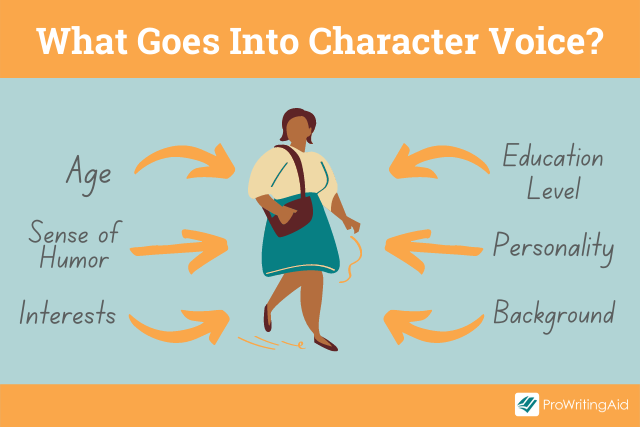
Each character should have their own voice.
Ideally, you want to write dialogue that lets your reader identify the person speaking at any point in your story just by looking at what’s between the quotation marks.
Tip #2: Write Realistic Dialogue
Good dialogue should sound natural. Listen to how people talk in real life and try to replicate it on the page when you write dialogue.
Don’t be afraid to break the rules of grammar, or to use an occasional exclamation point to punctuate dialogue.
It’s okay to use contractions , sentence fragments , and run-on sentences , even if you wouldn’t use them in other parts of the story.
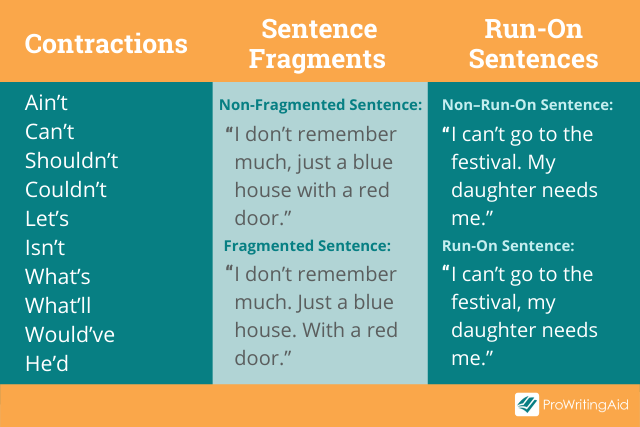
This doesn’t mean that realistic dialogue should sound exactly like the way people speak in the real world.
If you’ve ever read a court transcript, you know that real-life speech is riddled with “ums” and “ahs” and repeated words and phrases. A few paragraphs of this might put your readers to sleep.
Compelling dialogue should sound like a real conversation, while still being wittier, smoother, and better worded than real speech.
Tip #3: Simplify Your Dialogue Tags
A dialogue tag is anything that tells the reader which character is talking within that same paragraph, such as “she said” or “I asked.”
When you’re writing dialogue, remember that simple dialogue tags are the most effective .
Often, you can omit dialogue tags after the conversation has started flowing, especially if only two characters are participating.
The reader will be able to keep up with who’s speaking as long as you start a new paragraph each time the speaker changes.
When you do need to use a dialogue tag, a simple “he said” or “she said” will do the trick.
Our brains generally skip over the word “said” when we’re reading, while other dialogue tags are a distraction.
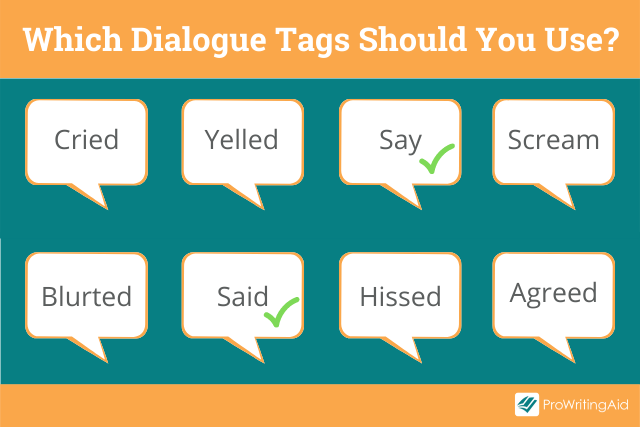
A common mistake beginner writers make is to avoid using the word “said.”
Characters in amateur novels tend to mutter, whisper, declare, or chuckle at every line of dialogue. This feels overblown and distracts from the actual story.
Another common mistake is to attach an adverb to the word “said.” Characters in amateur novels rarely just say things—they have to say things loudly, quietly, cheerfully, or angrily.
If you’re writing great dialogue, readers should be able to figure out whether your character is cheerful or angry from what’s within the quotation marks.
The only exception to this rule is if the dialogue tag contradicts the dialogue itself. For example, consider this sentence:
- “You’ve ruined my life,” she said angrily.
The word “angrily” is redundant here because the words inside the quotation marks already imply that the character is speaking angrily.
In contrast, consider this sentence:
- “You’ve ruined my life,” she said thoughtfully.
Here, the word “thoughtfully” is well-placed because it contrasts with what we might otherwise assume. It adds an additional nuance to the sentence inside the quotation marks.
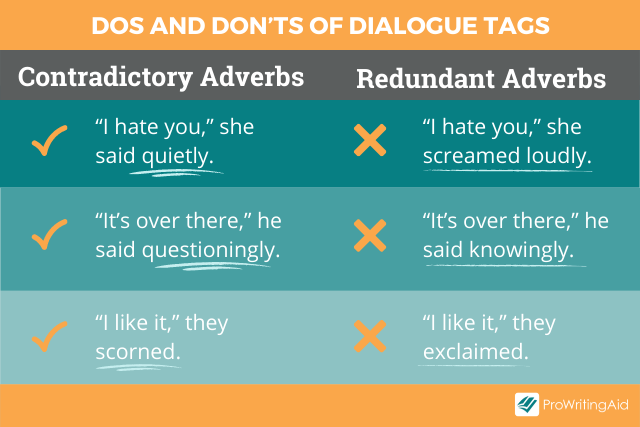
You can use the ProWritingAid dialogue check when you write dialogue to make sure your dialogue tags are pulling their weight and aren’t distracting readers from the main storyline.
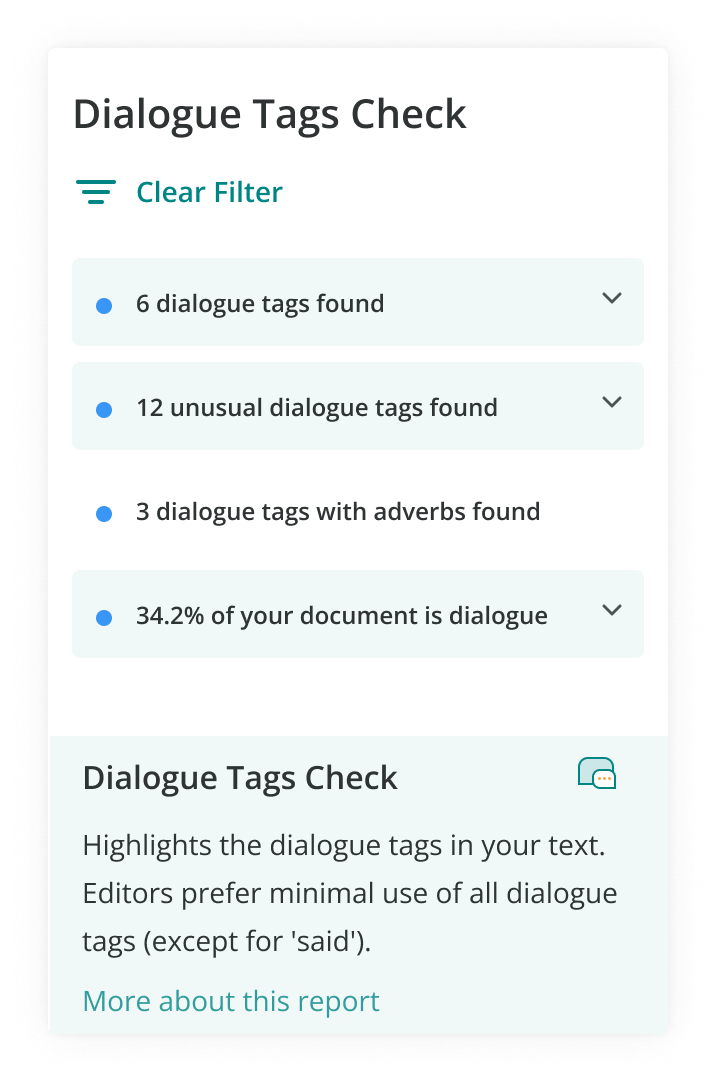
Sign up for your free ProWritingAid account to check your dialogue tags today.
Tip #4: Balance Speech with Action
When you’re writing dialogue, you can use action beats —descriptions of body language or physical action—to show what each character is doing throughout the conversation.
Learning how to write action beats is an important component of learning how to write dialogue.
Good dialogue becomes even more interesting when the characters are doing something active at the same time.
You can watch people in real life, or even characters in movies, to see what kinds of body language they have. Some pick at their fingernails. Some pace the room. Some tap their feet on the floor.
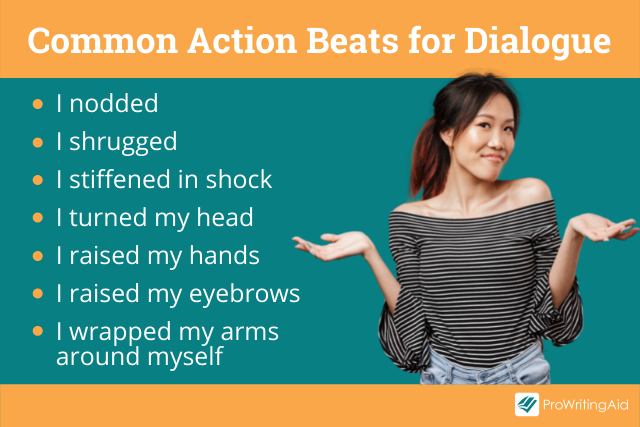
Including physical action when writing dialogue can have multiple benefits:
- It changes the pace of your dialogue and makes the rhythm more interesting
- It prevents “white room syndrome,” which is when a scene feels like it’s happening in a white room because it’s all dialogue and no description
- It shows the reader who’s speaking without using speaker tags
You can decide how often to include physical descriptions in each scene. All dialogue has an ebb and flow to it, and you can use beats to control the pace of your dialogue scenes.
If you want a lot of tension in your scene, you can use fewer action beats to let the dialogue ping-pong back and forth.
If you want a slower scene, you can write dialogue that includes long, detailed action beats to help the reader relax.
You should start a separate sentence, or even a new paragraph, for each of these longer beats.

Tip #5: Write Conversations with Subtext
Every conversation has subtext , because we rarely say exactly what we mean. The best dialogue should include both what is said and what is not said.
I once had a roommate who cared a lot about the tidiness of our apartment, but would never say it outright. We soon figured out that whenever she said something like “I might bring some friends over tonight,” what she meant was “Please wash your dishes, because there are no clean plates left for my friends to use.”
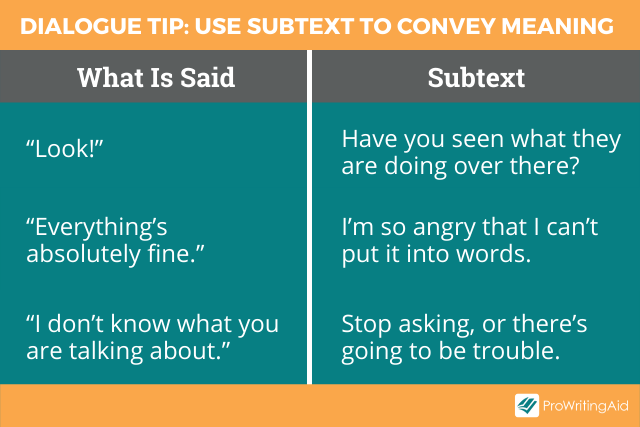
When you’re writing dialogue, it’s important to think about what’s not being said. Even pleasant conversations can hide a lot beneath the surface.
Is one character secretly mad at the other?
Is one secretly in love with the other?
Is one thinking about tomorrow’s math test and only pretending to pay attention to what the other person is saying?
Personally, I find it really hard to use subtext when I write dialogue from scratch.
In my first drafts I let my characters say what they really mean. Then, when I’m editing, I go back and figure out how to convey the same information through subtext instead.
Tip #6: Show, Don’t Tell
When I was in high school, I once wrote a story in which the protagonist’s mother tells her: “As you know, Susan, your dad left us when you were five.”
I’ve learned a lot about the writing craft since high school, but it doesn’t take a brilliant writer to figure out that this is not something any mother would say to her daughter in real life.

The reason I wrote that line of dialogue was because I wanted to tell the reader when Susan last saw her father, but I didn’t do it in a realistic way.
Don’t shoehorn information into your characters’ conversations if they’re not likely to say it to each other.
One useful trick is to have your characters get into an argument.
You can convey a lot of information about a topic through their conflicting opinions, without making it sound like either of the characters is saying things for the reader’s benefit.
Here’s one way my high school self could have conveyed the same information in a more realistic way in just a few lines:
Susan: “Why didn’t you tell me Dad was leaving? Why didn’t you let me say goodbye?”
Mom: “You were only five. I wanted to protect you.”
Tip #7: Keep Your Dialogue Concise
Dialogue tends to flow out easily when you’re drafting your story, so in the editing process, you’ll need to be ruthless. Cut anything that doesn’t move the story forward.
Try not to write dialogue that feels like small talk.
You can eliminate most hellos and goodbyes, or summarize them instead of showing them. Readers don’t want to waste their time reading dialogue that they hear every day.
In addition, try not to write dialogue with too many trigger phrases, which are questions that trigger the next line of dialogue, such as:
- “And then what?”
- “What do you mean?”
It’s tempting to slip these in when you’re writing dialogue because they keep the conversation flowing. I still catch myself doing this from time to time.
Remember that you don’t need three lines of dialogue when one line could accomplish the same thing.
Let’s look at some dialogue examples from successful novels that follow each of our seven tips.
Dialogue Example #1: How to Create Character Voice
Let’s start with an example of a character with a distinct voice from Harry Potter and the Chamber of Secrets by J.K. Rowling.
“What happened, Harry? What happened? Is he ill? But you can cure him, can’t you?” Colin had run down from his seat and was now dancing alongside them as they left the field. Ron gave a huge heave and more slugs dribbled down his front. “Oooh,” said Colin, fascinated and raising his camera. “Can you hold him still, Harry?”
Most readers could figure out that this was Colin Creevey speaking, even if his name hadn’t been mentioned in the passage.
This is because Colin Creevey is the only character who speaks with such extreme enthusiasm, even at a time when Ron is belching slugs.
This snippet of written dialogue does a great job of showing us Colin’s personality and how much he worships his hero Harry.
Dialogue Example #2: How to Write Realistic Dialogue
Here’s an example of how to write dialogue that feels realistic from A Thousand Splendid Suns by Khaled Hosseini.
“As much as I love this land, some days I think about leaving it,” Babi said. “Where to?” “Anyplace where it’s easy to forget. Pakistan first, I suppose. For a year, maybe two. Wait for our paperwork to get processed.” “And then?” “And then, well, it is a big world. Maybe America. Somewhere near the sea. Like California.”
Notice the punctuation and grammar that these two characters use when they speak.
There are many sentence fragments in this conversation like, “Anyplace where it’s easy to forget.” and “Somewhere near the sea.”
Babi often omits the verbs from his sentences, just like people do in real life. He speaks in short fragments instead of long, flowing paragraphs.
This dialogue shows who Babi is and feels similar to the way a real person would talk, while still remaining concise.
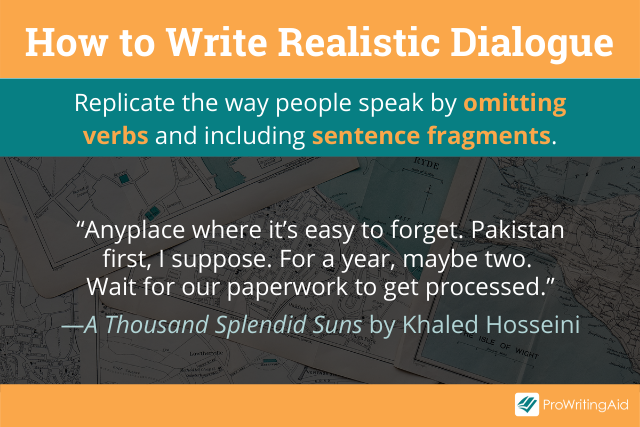
Dialogue Example #3: How to Simplify Your Dialogue Tags
Here’s an example of effective dialogue tags in Rebecca by Daphne du Maurier.
In this passage, the narrator’s been caught exploring the forbidden west wing of her new husband’s house, and she’s trying to make excuses for being there.
“I lost my way,” I said, “I was trying to find my room.” “You have come to the opposite side of the house,” she said; “this is the west wing.” “Yes, I know,” I said. “Did you go into any of the rooms?” she asked me. “No,” I said. “No, I just opened a door, I did not go in. Everything was dark, covered up in dust sheets. I’m sorry. I did not mean to disturb anything. I expect you like to keep all this shut up.” “If you wish to open up the rooms I will have it done,” she said; “you have only to tell me. The rooms are all furnished, and can be used.” “Oh, no,” I said. “No. I did not mean you to think that.”
In this passage, the only dialogue tags Du Maurier uses are “I said,” “she said,” and “she asked.”
Even so, you can feel the narrator’s dread and nervousness. Her emotions are conveyed through what she actually says, rather than through the dialogue tags.
This is a splendid example of evocative speech that doesn’t need fancy dialogue tags to make it come to life.
Dialogue Example #4: How to Balance Speech with Action
Let’s look at a passage from The Princess Bride by William Goldman, where dialogue is melded with physical action.
With a smile the hunchback pushed the knife harder against Buttercup’s throat. It was about to bring blood. “If you wish her dead, by all means keep moving," Vizzini said. The man in black froze. “Better,” Vizzini nodded. No sound now beneath the moonlight. “I understand completely what you are trying to do,” the Sicilian said finally, “and I want it quite clear that I resent your behavior. You are trying to kidnap what I have rightfully stolen, and I think it quite ungentlemanly.” “Let me explain,” the man in black began, starting to edge forward. “You’re killing her!” the Sicilian screamed, shoving harder with the knife. A drop of blood appeared now at Buttercup’s throat, red against white.
In this passage, William Goldman brings our attention seamlessly from the action to the dialogue and back again.
This makes the scene twice as interesting, because we’re paying attention not just to what Vizzini and the man in black are saying, but also to what they’re doing.
This is a great way to keep tension high and move the plot forward.
Dialogue Example #5: How to Write Conversations with Subtext
This example from Ender’s Game by Orson Scott Card shows how to write dialogue with subtext.
Here is the scene when Ender and his sister Valentine are reunited for the first time, after Ender’s spent most of his childhood away from home training to be a soldier.
Ender didn’t wave when she walked down the hill toward him, didn’t smile when she stepped onto the floating boat slip. But she knew that he was glad to see her, knew it because of the way his eyes never left her face. “You’re bigger than I remembered,” she said stupidly. “You too,” he said. “I also remembered that you were beautiful.” “Memory does play tricks on us.” “No. Your face is the same, but I don’t remember what beautiful means anymore. Come on. Let’s go out into the lake.”
In this scene, we can tell that Valentine missed her brother terribly, and that Ender went through a lot of trauma at Battle School, without either of them saying it outright.
The conversation could have started with Valentine saying “I missed you,” but instead, she goes for a subtler opening: “You’re bigger than I remembered.”
Similarly, Ender could say “You have no idea what I’ve been through,” but instead he says, “I don’t remember what beautiful means anymore.”
We can deduce what each of these characters is thinking and feeling from what they say and from what they leave unsaid.
Dialogue Example #6: How to Show, Not Tell
Let’s look at an example from The Name of the Wind by Patrick Rothfuss. This scene is the story’s first introduction of the ancient creatures called the Chandrian.
“I didn’t know the Chandrian were demons,” the boy said. “I’d heard—” “They ain’t demons,” Jake said firmly. “They were the first six people to refuse Tehlu’s choice of the path, and he cursed them to wander the corners—” “Are you telling this story, Jacob Walker?” Cob said sharply. “Cause if you are, I’ll just let you get on with it.” The two men glared at each other for a long moment. Eventually Jake looked away, muttering something that could, conceivably, have been an apology. Cob turned back to the boy. “That’s the mystery of the Chandrian,” he explained. “Where do they come from? Where do they go after they’ve done their bloody deeds? Are they men who sold their souls? Demons? Spirits? No one knows.” Cob shot Jake a profoundly disdainful look. “Though every half-wit claims he knows...”
The three characters taking part in this conversation all know what the Chandrian are.
Imagine if Cob had said “As we all know, the Chandrian are mysterious demon-spirits.” We would feel like he was talking to us, not to the two other characters.
Instead, Rothfuss has all three characters try to explain their own understanding of what the Chandrian are, and then shoot each other’s explanations down.
When Cob reprimands Jake for interrupting him and then calls him a half-wit for claiming to know what he’s talking about, it feels like a realistic interaction.
This is a clever way for Rothfuss to introduce the Chandrian in a believable way.
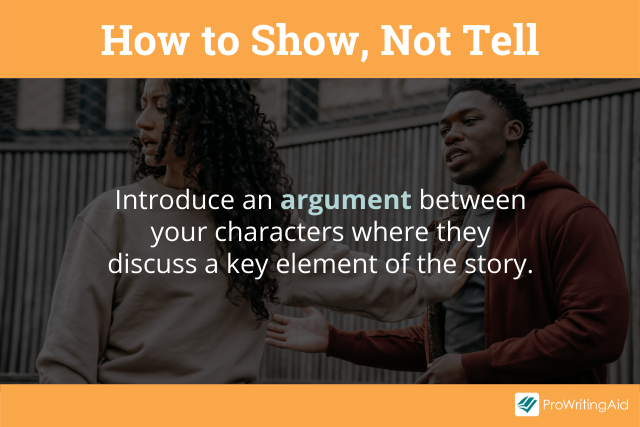
Dialogue Example #7: How to Keep Your Dialogue Concise
Here’s an example of concise dialogue from The Catcher in the Rye by J.D. Salinger.
“Do you blame me for flunking you, boy?” he said. “No, sir! I certainly don’t,” I said. I wished to hell he’d stop calling me “boy” all the time. He tried chucking my exam paper on the bed when he was through with it. Only, he missed again, naturally. I had to get up again and pick it up and put it on top of the Atlantic Monthly. It’s boring to do that every two minutes. “What would you have done in my place?” he said. “Tell the truth, boy.” Well, you could see he really felt pretty lousy about flunking me. So I shot the bull for a while. I told him I was a real moron, and all that stuff. I told him how I would’ve done exactly the same thing if I’d been in his place, and how most people didn’t appreciate how tough it is being a teacher. That kind of stuff. The old bull.
Here, the last paragraph diverges from the prior ones. After the teacher says “Tell the truth, boy,” the rest of the conversation is summarized, rather than shown.
The summary of what the narrator says in the last paragraph—“I told him I was a real moron, and all that stuff”—serves to hammer home that this is the type of “old bull” that the narrator has fed to his teachers over and over before.
It doesn’t need to be shown because it’s not important to the narrator—it’s just “all that stuff.”
Salinger could have written out the entire conversation in dialogue, but instead he kept the dialogue concise.
Final Words
Now you know how to write clear, effective dialogue! Start with the basic rules for dialogue and try implementing the more advanced tips as you go.
What are your favorite dialogue tips? Let us know in the comments below.
Do you know how to craft memorable, compelling characters? Download this free book now:

Creating Legends: How to Craft Characters Readers Adore… or Despise!
This guide is for all the writers out there who want to create compelling, engaging, relatable characters that readers will adore… or despise., learn how to invent characters based on actions, motives, and their past..

Be confident about grammar
Check every email, essay, or story for grammar mistakes. Fix them before you press send.
Hannah Yang is a speculative fiction writer who writes about all things strange and surreal. Her work has appeared in Analog Science Fiction, Apex Magazine, The Dark, and elsewhere, and two of her stories have been finalists for the Locus Award. Her favorite hobbies include watercolor painting, playing guitar, and rock climbing. You can follow her work on hannahyang.com, or subscribe to her newsletter for publication updates.
Get started with ProWritingAid
Drop us a line or let's stay in touch via :
Improve your writing in one of the largest and most successful writing groups online
Join our writing group!
How to Write Dialogue: Rules, Examples, and 8 Tips for Engaging Dialogue

by Fija Callaghan
You’ll often hear fiction writers talking about “character-driven stories”—stories where the strengths, weaknesses, and aspirations of the central cast of characters stay with us long after the book is closed. But what drives character, and how do we create characters that leave long-lasting impressions?
The answer lies in dialogue : the device used by our characters to communicate with each other. Powerful dialogue can elevate a story and subtly reveal important information, but poorly written dialogue can send your work straight to the slush bin. Let’s look at what dialogue is in writing, how to properly format dialogue, and how to make your characters’ dialogue the best it can be.
What is dialogue in a story?
Dialogue is the verbal exchange between two or more characters. In most fiction, the exchange is in the form of a spoken conversation. However, conversations in a story can also be things like letters, text messages, telepathy, or even sign language. Any moment where two characters speak or connect with each other through their choice of words, they’re engaging in dialogue.

Why does dialogue matter in a story?
We use dialogue in a story to reveal new information about the plot, characters, and story world. Great dialogue is essential to character development and helps move the plot forward in a story.
Writing good dialogue is a great way to sneak exposition into your story without stating it overtly to the reader; you can also use tools like dialect and diction in your dialogue to communicate more detail about your characters.

Through a character’s dialogue, we can learn about their motivations, relationships, and understanding of the world around them.
A character won’t always say what they mean (more on dialogue subtext below), but everything they say will serve some larger purpose in the story. If your dialogue is well-written, the reader will absorb this information without even realizing it. If your dialogue is clunky, however, it will stand out and pull your reader away from your story.

Rules for writing dialogue
Before we get into how to make your dialogue realistic and engaging, let’s make sure you’ve got the basics down: how to properly format dialogue in a story. We’ll look at how to punctuate dialogue, how to write dialogue correctly when using a question mark or exclamation point, and some helpful dialogue writing examples.
Here are the need-to-know rules for formatting dialogue in writing.
Enclose lines of dialogue in double quotation marks
This is the most essential rule in basic dialogue punctuation. When you write dialogue in North American English, a spoken line will have a set of double quotation marks around it. Here’s a simple dialogue example:
“Were you at the party last night?”
Any punctuation such as periods, question marks, and exclamation marks will also go inside the quotation marks. The quotation marks give a visual clue to the reader that this line is spoken out loud.

In European or British English, however, you’ll often see single quotation marks being used instead of double quotation marks. All the other rules stay the same.
Enclose nested dialogue in single quotation marks
Nested dialogue is when one line of dialogue happens inside another line of dialogue—when someone is verbally quoting someone else. In North American English, you’d use single quotation marks to identify where the new dialogue line starts and stops, like this:
“And then, do you know what he said to me? Right to my face, he said, ‘I stayed home all night.’ As if I didn’t even see him.”
The double and single quotation marks give the reader clues as to who’s speaking. In European or British English, the quotation marks would be reversed; you’d use single quotation marks on the outside, and double quotation marks on the inside.
Every speaker gets a new paragraph
Every time you switch to a new speaker, you end the line where it is and start a new line. Here are some dialogue examples to show you how it looks:
“Were you at the party last night?” “No, I stayed home all night.”
The same is true if the new “speaker” is only in focus because of their action. You can think of the paragraphs like camera angles, each one focusing on a different person:
“Were you at the party last night?” “No, I stayed home all night.” She raised a single, threatening eyebrow. “Yeah, I wasn’t feeling that well, so I just stayed in and watched Netflix instead.”
If you kept the action on the same line as the dialogue, it would get confusing and make it look like she was the one saying it. Giving each character a new paragraph keeps the speakers clear and distinct.
Use em-dashes when dialogue gets cut short
If your character begins to speak but is interrupted, you’ll break off their line of dialogue with an em-dash, like this:
“Yeah, I wasn’t feeling that well, so I just stayed in and—” “Is that really what happened?”
Be careful with this one, because many word processors will treat your em-dash like the beginning of a new sentence and attach your closing quotation marks backwards:
“Yeah, I wasn’t feeling that well, so I just stayed in and—“
You may need to keep an eye out and adjust as you go along.
In this dialogue example, the new speaker doesn’t lead with an em-dash; they just start speaking like normal. The only time you’ll ever open a line of dialogue with an em-dash is if the speaker who’s been cut off continues with what they were saying:
“Yeah, I wasn’t feeling that well, so I just stayed in and—” “Is that really what happened?” “—watched Netflix instead. Yes, that’s what happened.”
This shows the reader that there’s actually only one line of dialogue, but it’s been cut in the middle by another speaker.
Each line of dialogue is indented
Every time you give your speaker a new paragraph, it’s indented from the left-hand side. Many word processors will do this automatically. The only exception is if your dialogue is opening your story or a new section of your story, such as a chapter; these will always start at the far left margin of the page, whether they’re dialogue or narration.

Long speeches don’t use use closing quotation marks until the end
Most writers favor shorter lines of dialogue in their writing, but sometimes you might need to give your character a longer one—for instance, if the character speaking is giving a speech or telling a story. In these cases, you might choose to break up their speech into shorter paragraphs the way you would if you were writing regular narrative.
However, here the punctuation gets a bit weird. You’ll begin the character’s dialogue with a double quotation mark, like normal. But you won’t use a double quotation mark at the end of the paragraph, because they haven’t finished speaking yet. But! You’ll use another opening quotation mark at the beginning of the subsequent paragraph. This means that you may use several opening double quotation marks for your character’s speech, but only ever one closing quotation mark.
If your character is telling a story that involves people talking, remember to use single quotation marks for your dialogue-within-dialogue as we looked at above.
Sometimes these dialogue formatting rules are easier to catch later on, during the editing process. When you’re writing, worry less about using the exact dialogue punctuation and more about writing great dialogue that supports your character development and moves the story forward.
How to use dialogue tags
Dialogue tags help identify the speaker. They’re especially important if you have a group of people all talking together, and it can get pretty confusing for the reader trying to keep everybody straight. If you’re using a speech tag after your line of dialogue—he said, she said, and so forth—you’ll end your sentence with a comma, like this:
“No, I stayed home all night,” he said.
But if you’re using an action to identify the person speaking instead, you’ll punctuate the sentence like normal and start a new sentence to describe the action taking place:
“No, I stayed home all night.” He looked down at his feet.
The dialogue tags and action tags always follow in the same paragraph. When you move your story lens to a new person, you’ll switch to a new paragraph. Each line where a new person speaks propels the story forward.
When to use capitals in dialogue tags
You may have noticed in the two examples above that one dialogue tag begins with a lowercase letter, and one—which is technically called an action tag—begins with a capital letter. Confusing? The rules are simple once you get a little practice.
When you use a dialogue tag like “he said,” “she said,” “he whispered,” or “she shouted,” you’re using these as modifiers to your sentence—dressing it up with a little clarity. They’re an extension of the sentence the person was speaking. That’s why you separate them with a comma and keep going.
With an action tag , you’re ending one sentence and beginning a whole new one. Each sentence represents two distinct moments in the story. That’s why you end the first sentence with a period, and then open the next one with a capital letter.
If you’re not sure, try reading them out loud:
“No, I stayed home all night,” he said. “No, I stayed home all night.” He looked down at his feet.

Since you can’t hear quotation marks out loud, the way you say them will show you if they’re one sentence or two. In the first example, you can hear how the sentence keeps going after the dialogue ends. In the second example, you can hear how one sentence comes to a full stop and another one begins.
But what if your dialogue tag comes before the dialogue, instead of after? In this case, the dialogue is always capitalized because the speaker is beginning a new sentence:
He said, “No, I stayed home all night.” He looked down at his feet. “No, I stayed home all night.”
You’ll still use a comma after the dialogue tag and a period after the action tag, just like if you’d separate them if you were putting your tag at the end.
If you’re not sure, ask yourself if your leading tag sounds like a full sentence or a partial sentence. If it sounds like a partial sentence, it gets a comma. If it reads like a full sentence that stands on its own, it gets a period.
External vs. internal dialogue
All of the dialogue we’ve looked at so far is external dialogue, which is directed from one character to another. The other type of dialogue is internal dialogue, or inner dialogue, where a character is talking to themselves. You’ll use this when you want to show what a character is thinking, but other characters can’t hear.
Usually, internal dialogue will be written in italics to distinguish it from the rest of the text. That shows the reader that the line is happening inside the character’s head. For example:
It’s not a big deal, she thought. It’s just a new school. It’ll be fine. I’ll be fine.
Here you can see that the dialogue tag is used in the same way, just as if it was a line of external dialogue. However, “she thought” is written in regular text because it’s not a part of what the character is thinking. This helps keep everything clear for the reader.

In your story, you can play with using contrasting internal and external dialogue to show that what your characters say isn’t always what they mean. You may also choose to use this internal dialogue formatting if you’re writing dialogue between two or more characters that isn’t spoken out loud—for instance, telepathically or by sign language.
8 tips for creating engaging dialogue in a story
Now that you’ve mastered the mechanics of how to write dialogue, let’s look at how to create convincing, compelling dialogue that will elevate your story.
1. Listen to people talk
To write convincingly about people, you’ll first need to know something about them. The work of great writers is often characterized by their insight into humanity; you read them and think, “Yes, this is exactly what people are like.” You can begin accumulating your own insight by listening to what real people say to each other.
You can go to any public place where people are likely to gather and converse: cafés, art galleries, political events, dimly lit pubs, bookshops. Record snippets of conversation, pay attention to how people’s voices change as they move from speaking to one person to another, try to imagine what it is they’re not saying, the words simmering just under the surface.
By listening to stories unfold in real time, you’ll have a better idea of how to recreate them in your writing—and inspiration for some new stories, too.
2. Give each spoken line a purpose
Here is something that actors have drilled into their heads from their first day at drama school, and writers would do well to remember it too: every single line of dialogue has a hidden motivation. Every time your character speaks, they’re trying to achieve something, either overtly or covertly.
Small talk is rare in fiction, because it doesn’t advance the plot or reveal something about your characters. The exception is when your characters are using their small talk for a specific purpose, such as to put off talking about the real issue, to disarm someone, or to pretend they belong somewhere they don’t.
When writing your own dialogue, ask yourself what the line accomplishes in the story. If you come up blank, it probably doesn’t need to be there. Words need to earn their place on the page.

3. Embrace subtext
In real life, we rarely say exactly what we really mean. The reality of polite society is that we’ve evolved to speak in circles around our true intentions, afraid of the consequences of speaking our mind. Your characters will be no different. If your protagonist is trying to tell their best friend they’re in love with them, for instance, they’ll come up with about fifty different ways to say it before speaking the deceptively simple words themselves.
To write better dialogue, try exploring different ways of moving your characters around what’s really being said, layering text and subtext side by side. The reader will love picking apart the conversation between your characters and deducing what’s really happening underneath (incidentally, this is also the place where fan fiction is born).
4. Keep names to a minimum
You may notice that on television, in moments of great upheaval, the characters will communicate exactly how important the moment is by saying each other’s names in dramatic bursts of anger/passion/fear/heartbreak/shock. In real life, we say each other’s names very rarely; saying someone’s name out loud can actually be a surprisingly intimate experience.
Names may be a necessary evil right at the beginning of your story so your reader knows who’s who, but after you’ve established your cast, try to include names in dialogue only when it makes sense to do so. If you’re not sure, try reading the dialogue out loud to see if it sounds like something someone would actually say (we’ll talk more about reading out loud below).
5. Prune unnecessary words
This is one area where reality and story differ. In life, dialogue is full of filler words: “Um, uh, well, so yeah, then I was like, erm, huh?” You may have noticed this when you practiced listening to dialogue, above. We won’t say there’s never a place for these words in fiction, but like all words in storytelling, they need to earn their place. You might find filler words an effective tool for showing something about one particular character, or about one particular moment, but you’ll generally find that you use them a lot less than people really do in everyday speech.
When you’re reviewing your characters’ dialogue, remember the hint above: each line needs a purpose. It’s the same for each word. Keep only the ones that contribute something to the story.
6. Vary word choices and rhythms
The greatest dialogue examples in writing use distinctive character voices; each character sounds a little bit different, because they have their own personality.
This can be tricky to master, but an easy way to get started is to look at the word choice and rhythm for each character. You might have one character use longer words and run-on sentences, while another uses smaller words and simple, single-clause sentences. You might have one lean on colloquial regional dialect, where another sounds more cosmopolitan. Play around with different ways to develop characters and give each one their own voice.

7. Be consistent for each character
When you do find a solid, believable voice for your character, make sure that it stays consistent throughout your entire story. It’s easy to set a story aside for a while, then return to it and forget some of the work you did in distinguishing your characters’ dialogue. You might find it helpful to write down some notes about the way each character speaks so you can refer back to it later.
The exception, of course, is if your character’s speech pattern goes through a transformation over the course of the story, like Audrey Hepburn in My Fair Lady . In this case, you can use your character’s distinctive voice to communicate a major change. But as with all things in writing, make sure that it comes from intention and not from forgetfulness.
8. Read your dialogue out loud
After you’ve written a scene between two or more characters, you can take the dialogue for a trial run by speaking it out loud. Ask yourself, does the dialogue sound realistic? Are there any moments where it drags or feels forced? Does the voice feel natural for each character? You’ll often find there are snags you miss in your writing that only become apparent when read out loud. Bonus: this is great practice for when you become rich and famous and do live readings at bookshops.
3 mistakes to avoid when writing dialogue
Easy, right? But there are also a few pitfalls that new writers often encounter when writing dialogue that can drag down an otherwise compelling story. Here are the things to watch out for when crafting your story dialogue.
1. Too much exposition
Exposition is one of the more demanding literary devices , and one of the ones most likely to trip up new writers. Dialogue is a good place to sneak in some information about your story—but subtlety is essential. This is one place where the adage “show, don’t tell” really shines.
Consider these dialogue examples:
“How is she, Doctor?” “Well Mr. Stuffington, I don’t have to remind you that your daughter, the sole heiress to your estate and currently engaged to the Baron of Flippingshire, has suffered a grievous injury when she fell from her horse last Sunday. We don’t need to discuss right now whether or not you think her jealous maid was responsible; what matters is your daughter’s well being. As to your question, I’m afraid it’s very unlikely that she’ll ever walk again.” Can’t you just feel your arm aching to throw the poor book across the room? There’s a lot of important information here, but you can find subtler ways to work it into your story. Let’s try again: “How is she, Doctor?” “Well Mr. Stuffington, your daughter took quite a blow from that horse—worse than we initially thought. I’m afraid it’s very unlikely that she’ll ever walk again.” “And what am I supposed to say to Flippingshire?” “The Baron? I suppose you’ll have to tell him that his future wife has lost the use of her legs.”
And so forth. To create good dialogue exposition, look for little ways to work in the details of your story, instead of piling it up in one great clump.

2. Too much small talk
We looked at how each line of dialogue needs a specific purpose above. Very often small talk in a story happens because the writer doesn’t know what the scene is about. Small talk doesn’t move the scene along unless it’s there for a reason. If you’re not sure, ask yourself what each character wants in this moment.
For example, imagine you’re in an office, and two characters are talking by the water cooler. How was your weekend, what did you think of the game, how’s your wife doing, are those new shoes, etc etc. Can’t you just feel the reader’s will to live slipping away?
But what about this: your characters are talking by the water cooler—Character A and Character B. Character A knows that his friend is inside Character B’s office looking for evidence of corporate espionage, so A is doing everything he can to stop B from going in. How was your weekend, what did you think of the game, how’s your wife doing, are those new shoes, literally anything just to keep him talking. Suddenly these benign little phrases have a purpose.
If you find your characters slipping into small talk, double check that it’s there for a purpose, and not just a crutch to keep you from moving forward in your scene. When writing dialogue, Make each line of dialogue earn its place.
3. Too much repetition
Variation is the spice of a good story. To keep your readers engaged, avoid using the same sentence structure and the same dialogue tags over and over again. Using “he said” and “she said” is effective and clear cut, but only for about three beats. After that, try switching to an action tag instead or letting the line of dialogue stand on its own.

You can also experiment with varying the length of your sentences or groupings of sentences. By changing up the rhythm of your story regularly, you’ll keep it feeling fresh and present for the reader.
Effective dialogue examples from literature
With all of these tips and tricks in mind, let’s look at how other writers have used good dialogue to elevate their stories.
Eleanor Oliphant is Completely Fine , by Gail Honeyman
“I’m going to pick up a carryout and head round to my mate Andy’s. A few of us usually hang out there on Saturday nights, fire up the playstation, have a smoke and a few beers.” “Sounds utterly delightful,” I said. “What about you?” he asked. I was going home, of course, to watch a television program or read a book. What else would I be doing? “I shall return to my flat,” I said. “I think there might be a documentary about komodo dragons on BBC4 later this evening.”
In this dialogue example, the author gives her characters two very distinctive voices. From just a few words we can begin to see these people very clearly in our minds—and with this distinction comes the tension that drives the story. Dialogue is an excellent place to show your character dynamics using speech patterns and word choices.
Pride and Prejudice , by Jane Austen
“My dear Mr. Bennet,” said his lady to him one day, “have you heard that Netherfield Park is let at last?” Mr. Bennet replied that he had not. “But it is,” returned she; “for Mrs. Long has just been here, and she told me all about it.” Mr. Bennet made no answer. “Do you not want to know who has taken it?” cried his wife impatiently. “You want to tell me, and I have no objection to hearing it.” This was invitation enough. “Why, my dear, you must know, Mrs. Long says that Netherfield is taken by a young man of large fortune from the north of England; that he came down on Monday in a chaise and four to see the place, and was so much delighted with it, that he agreed with Mr. Morris immediately; that he is to take possession before Michaelmas, and some of his servants are to be in the house by the end of next week.”
In this famous dialogue example, the author illustrates the relationship between these two characters clearly and succinctly. Their dialogue shows Mr. B’s stalwart, tolerant love for his wife and Mrs. B’s excitement and propensity for gossip. The author shows us everything we need to know about these people in just a few lines.
Dinner in Donnybrook , by Maeve Binchy
“Look, I thought you ought to know, we’ve had a very odd letter from Carmel.” “A what… from Carmel?” “A letter. Yes, I know it’s sort of out of character, I thought maybe something might be wrong and you’d need to know…” “Yes, well, what did she say, what’s the matter with her?” “Nothing, that’s the problem, she’s inviting us to dinner.” “To dinner?” “Yes, it’s sort of funny, isn’t it? As if she wasn’t well or something. I thought you should know in case she got in touch with you.” “Did you really drag me all the way down here, third years are at the top of the house you know, I thought the house had burned down! God, wait till I come home to you. I’ll murder you.” “The dinner’s in a month’s time, and she says she’s invited Ruth O’Donnell.” “Oh, Jesus Christ.”
This dialogue example is a telephone conversation between two people. The lack of dialogue tags or action tags allows the words to come to the forefront and immerses us in their back-and-forth conversation. Even though there are no tags to indicate the speakers, the language is simple and straightforward enough that the reader always knows who’s talking. Through this conversation the author slowly builds the tension from the benign to the catastrophic within a domestic setting.
Compelling dialogue is the key to a good story
A writer has a lot riding on their characters’ dialogue, and learning how to write dialogue is a critical skill for any writer. When done well, it can leaves a lasting impact on the reader. But when dialogue is clumsy and awkward, it can drag your story down and make your reader feel like they’re wasting their time.
But if you keep these tips in mind, listen to dialogue in your everyday life, and practice , you’ll be sure to create realistic dialogue that brings your story to life.
Get feedback on your writing today!
Scribophile is a community of hundreds of thousands of writers from all over the world. Meet beta readers, get feedback on your writing, and become a better writer!
Join now for free

Related articles

Dialogue Tag Format: What are Speech Tags? With Examples

What is Alliteration? Definition, examples and tips

Nonfiction Writing Checklist for Your Book

What is Dialect in Literature? Definition and Examples

Writing Effective Dialogue: Advanced Techniques

What is a Writer’s Voice & Tips for Finding Your Writing Voice
TRY OUR FREE APP
Write your book in Reedsy Studio. Try the beloved writing app for free today.
Craft your masterpiece in Reedsy Studio
Plan, write, edit, and format your book in our free app made for authors.

Guides • Perfecting your Craft
Last updated on Jul 24, 2023
6 Unbreakable Dialogue Punctuation Rules All Writers Must Know
Dialogue punctuation is a critical part of written speech that allows readers to understand when characters start and stop speaking. By following the proper punctuation rules — for example, that punctuation marks almost always fall within the quotation marks — a writer can ensure that their characters’ voices flow off the page with minimal distraction.
This post’ll show you how to format your dialogue to publishing standards.
6 essential dialogue punctuation rules:
1. Always put commas and periods inside the quote
2. use double quote marks for dialogue (if you’re in america), 3. start a new paragraph every time the speaker changes , 4. use dashes and ellipses to cut sentences off, 5. deploy single quote marks used for quotes within dialogue, 6. don’t use end quotes between paragraphs of speech .
The misplacement of periods and commas is the most common mistake writers make when punctuating dialogue. But it’s pretty simple, once you get the hang of it. You should always have the period inside the quote when completing a spoken sentence.
Example: “It’s time to pay the piper.”
As you’ll know, the most common way to indicate speech is to write dialogue in quotation marks and attribute it to a speaker with dialogue tags, such as he said , she said, or Margaret replied, or chirped Hiroko . This is what we call “attribution” when you're punctuating dialogue.
Insert a comma inside the quotation marks when the speaker is attributed after the dialogue.
Example: “Come closer so I can see you,” said the old man.
If the speaker is attributed before the dialogue, there is a comma outside the quotation marks.
Example: Aleela whimpered, “I don’t want to. I’m scared.”
If the utterance (to use a fancy linguistics term for dialogue 🤓) ends in a question mark or exclamation point, they would also be placed inside the quotation marks.

Exception: When it’s not direct dialogue.
You might see editors occasionally place a period outside the quotation marks. In those cases, the period is not used for spoken dialogue but for quoting sentence fragments, or perhaps when styling the title of a short story.
Mark’s favorite short story was “The Gift of the Magi”.
My father forced us to go camping, insisting that it would “build character”.

Now that we’ve covered the #1 rule of dialogue punctuation, let’s dig into some of the more nuanced points.
In American English, direct speech is normally represented with double quotation marks.
Example : “Hey, Billy! I’m driving to the drug store for a soda and Charleston Chew. Wanna come?” said Chad
In British and Commonwealth English, single quotation marks are the standard.
Example: ‘I say, old bean,’ the wicketkeeper said, ‘Thomas really hit us for six. Let’s pull up stumps and retire to the pavilion for tea.’
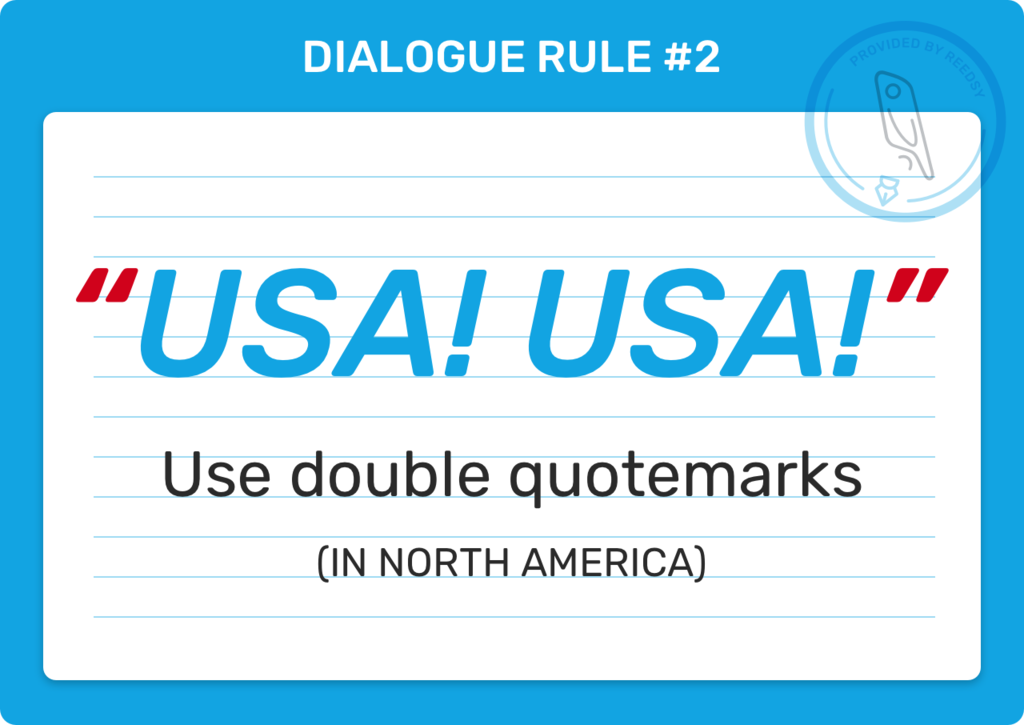
This is one of the most fundamental rules of organizing dialogue. To make it easier for readers to follow what’s happening, start a new paragraph every time the speaker changes, even if you use dialogue tags.
“What do you think you’re doing?” asked the policeman. “Oh, nothing, officer. Just looking for my hat,” I replied.
The new paragraph doesn’t always have to start with direct quotes. Whenever the focus moves from one speaker to the other, that’s when you start a new paragraph. Here’s an alternative to the example above:
“What do you think you’re doing?” asked the policeman. I scrambled for an answer. “Oh, nothing, officer. Just looking for my hat.”

FREE COURSE
How to Write Believable Dialogue
Master the art of dialogue in 10 five-minute lessons.
So far, all of the examples we’ve shown you are of characters speaking in full, complete sentences. But as we all know, people don’t always get to the end of their thoughts before their either trail off or are interrupted by others. Here’s how you can show that on the page.
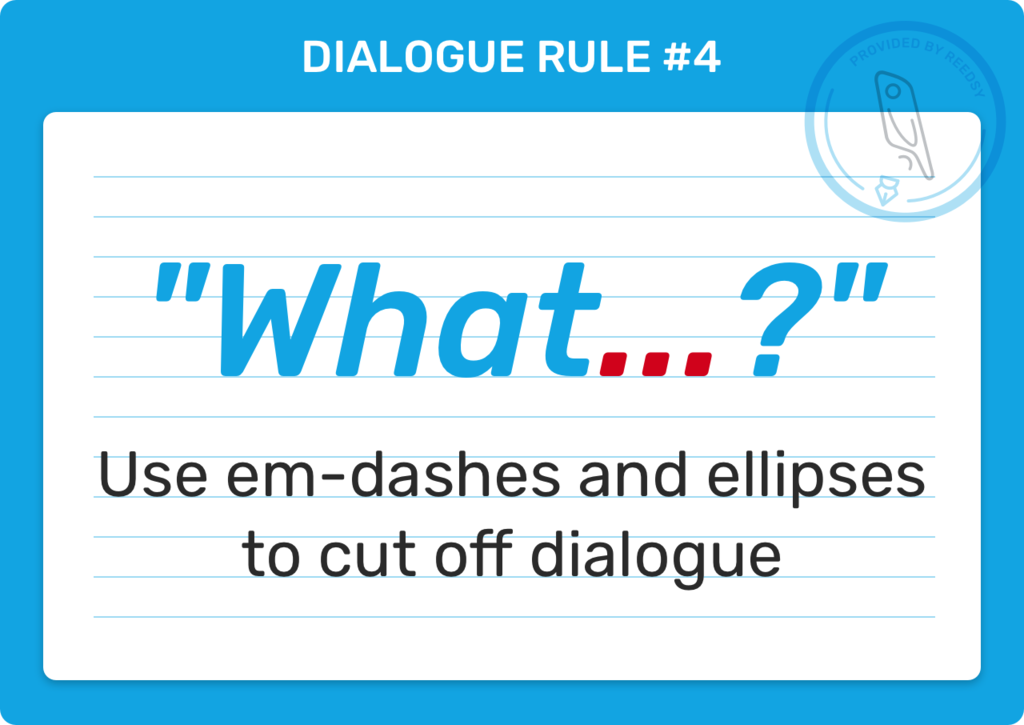
Em-dashes to interrupt
When a speaking character is cut off, either by another person or a sudden event, use an em-dash inside the quotation marks. These are the longest dashes and can be typed by hitting alt-shift-dash on your keyboard (or option-shift-dash for Mac users).
“Captain, we only have twenty seconds before—” A deafening explosion ripped through the ship’s hull. It was already too late.
“Ali, please tell me what’s going—” “There’s no use talking!” he barked.
You can also overlap dialogue to show one character speaking over another.
Mathieu put his feet up as the lecturer continued. "Current estimates indicate that a human mission will land on Mars within the next decade—" "Fat chance." "—with colonization efforts following soon thereafter."
Sometime people won’t finish their sentences, and it’s not because they’ve been interrupted. If this is the case, you’ll want to…
Trail off with ellipses
You can indicate the speaker trailing off with ellipses (. . .) inside the quotation marks.
Velasquez patted each of her pockets. “I swear I had my keys . . .”
Ellipses can also suggest a small pause between two people speaking.
Dawei was in shock. “I can’t believe it . . .” “Yeah, me neither,” Lan Lan whispered.
💡Pro tip: The Chicago Manual of Style requires a space between each period of the ellipses. Most word processors will automatically detect the dot-dot-dot and re-style them for you — but if you want to be exact, manually enter the spaces in between the three periods.
In the course of natural speech, people will often directly quote what other people have said. If this is the case, use single quotation marks within the doubles and follow the usual rules of punctuating dialogue.
“What did Randy say to you?” Beattie asked. “He told me, ‘I got a surprise for you,’ and then he life. Strange, huh?”
But what if a character is quoting another person, who is also quoting another person? In complex cases like this (which thankfully aren’t that common), you will alternate double quotation marks with single quotes.
“I asked Gennadi if he thinks I’m getting the promotion and he said, ‘The boss pulled me aside and asked, “Is Sergei going planning to stay on next year?”’”
The punctuation at the end is a double quote mark, followed by a single quote mark, followed by another double quote. It closes off:
- What the boss said,
- What Gennadi said, and
- What Sergei, the speaker, said.
Quoting quotes within quotes can get messy, so consider focusing on indirect speech. Simply relate the gist of what someone said:
“I pressed Gennadi on my promotion. He said the boss pulled him aside and asked him if I was leaving next year.”

In all the examples above, each character has said fewer than 10 or 20 words at a time. But if a character speaks more than a few sentences at a time, to deliver a speech for example, you can split their speech into multiple paragraphs. To do this:
- Start each subsequent paragraph with an opening quotation mark; and
- ONLY use a closing quotation mark on the final paragraph.
"Would you like to hear my plan?" the professor said, lighting his oak pipe with a match. "The first stage involves undermining the dean's credibility: a small student protesst here, a little harassment rumor there. It all starts to add up. "Stage two involves the board of trustees, with whom I've been ingratiating myself for the past two semesters."
Notice how the first paragraph doesn't end with an end quote? This indicates that the same person is speaking in the next paragraph. You can always break up any extended speech with action beats to avoid pages and pages of uninterrupted monologue.
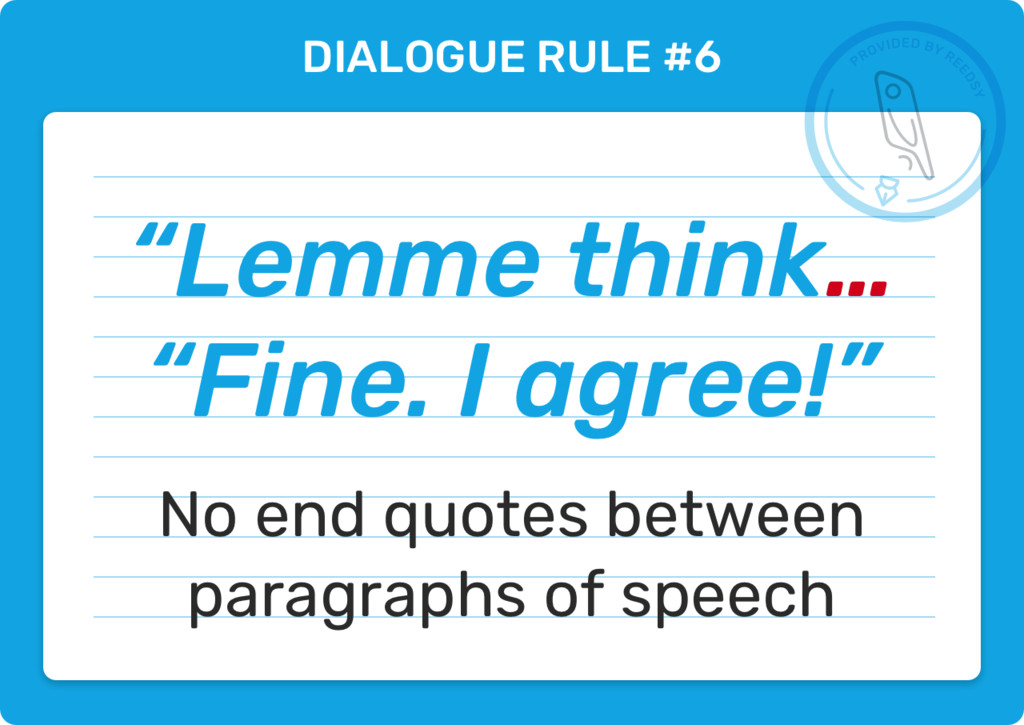
Want to see a great example of action beats breaking up a monologue? Check out this example from Sherlock Holmes.
Hopefully, these guidelines have clarified a few things about punctuating dialogue. In the next parts of this guide, you’ll see these rules in action as we dive into dialogue tags and look at some more dialogue examples here .
Join a community of over 1 million authors
Reedsy is more than just a blog. Become a member today to discover how we can help you publish a beautiful book.
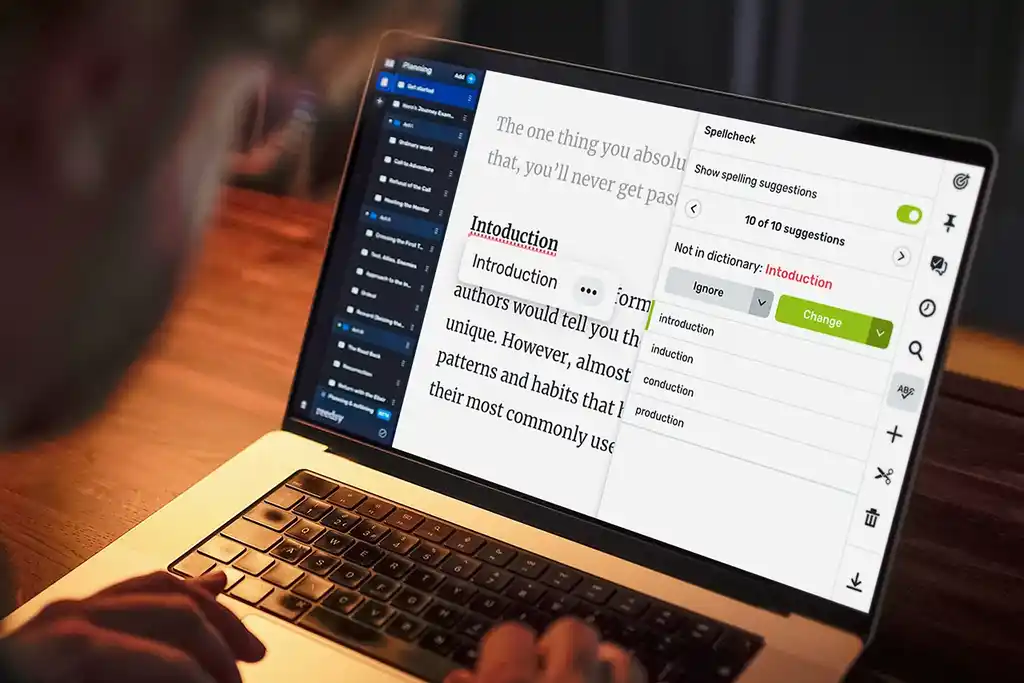
Catch your errors
Polish your writing in the *free* Reedsy Book Editor.

1 million authors trust the professionals on Reedsy. Come meet them.
Enter your email or get started with a social account:
- English Grammar
- English Vocabulary
- English Words
- Introduction To Poetry
- Introduction to Prose: Fiction and Non-Fiction
- Writing Skills
- Writing Part
- Class Six English Full Book Solution
- Class Seven English Full Book Solution
- National Flag
- Load Shedding
- Winter Morning
- 21st February
- Traffic Jam
- Tree Plantation
- Early Rising
- School Library
- Reading Room
- Deforestation
- Climate Change
- Global Warming
- Drug Addiction
- Human Rights
- Learning Computer
- Class Six Math Solution(New)
- Class Seven Math Solution(New)
- Class Eight Math Solution(New)
- Class Nine Math Solution(New)
- Dictionary Of Phrasal Verbs
- Spoken English Course
- Cybersecurity Course
- Job Related Books
- Exploration

Dialogue Writing – Tips, Style, Format and Example
“Are you good at talking or listening well? If so, you’ve probably had moments where something someone said, or you said, really stood out to you. This happens because those words touched your heart or made you think. That’s the power of a good conversation. Even a simple chat with family, friends, or strangers can give you ideas and thoughts to think about Dialogue Writing.
This article will teach you about the skill of writing dialogues and provide you with all the information you need to know. Additionally, you can read some examples of Dialogue Writing and see how they create an impact.”
What is the purpose of writing a dialogue?
Types of dialogues, some common examples of ‘direct dialogue’, some common examples of ‘indirect dialogue’, fundamental rules of writing a dialogue with example, faqs about dialogue writing.
Table of Contents
What is dialogue writing?
Dialogue writing is the art of creating conversations between characters in a written work, such as a story, play, or script. It involves capturing the way people speak, expressing their thoughts, emotions, and interactions through written words. Effective dialogue should sound natural and authentic, reflecting the unique voices and personalities of the characters.
In dialogue writing, punctuation, formatting, and the choice of words are crucial to convey the tone, rhythm, and dynamics of a conversation. It plays a significant role in advancing the plot, revealing character traits, and engaging the readers or audience. Good dialogue enhances the overall flow of a narrative and contributes to a deeper understanding of the characters and the story.
Writing a dialogue serves several important purposes. Firstly, it brings characters to life by allowing them to communicate, sharing their thoughts, feelings, and personalities with the reader. Through dialogue, characters become real and relatable, forming a connection with the audience.
Secondly, dialogue moves the story forward. It’s a powerful tool for advancing the plot, revealing key information, and creating tension or resolution. When characters engage in conversation, it propels the narrative, keeping readers interested and invested in the unfolding events.
Moreover, dialogue adds authenticity to a story. By mimicking the way people speak, it makes characters and their interactions more genuine. This authenticity makes the fictional world more immersive, allowing readers to fully engage with the narrative.
In essence, the purpose of writing a dialogue is to breathe life into characters, propel the storyline, and create a vivid and authentic reading experience for the audience.
The two main types of dialogues are direct dialogue and indirect dialogue .
- Direct Dialogue: Direct dialogue involves the characters speaking for themselves. It is presented within quotation marks and includes the exact words spoken by the characters. This type of dialogue provides a direct and immediate connection between the characters and the reader, allowing the audience to hear the characters’ voices directly. Example:Sarah exclaimed, “I can’t believe we won the game!”
- Indirect Dialogue: Indirect dialogue, on the other hand, conveys the substance of the conversation without quoting the exact words. It is often presented in a narrative form, summarizing what was said rather than providing a verbatim account. This type is useful for conveying information efficiently without focusing on the specific wording. Example:Tom told Mary that he was excited about the upcoming trip.
Understanding when to use direct or indirect dialogue depends on the desired effect, pacing, and the information the writer intends to convey to the audience.
- Expressing Surprise: Sarah gasped, “Oh, I didn’t see that coming!”
- Sharing Excitement: Jake shouted, “I got an A+ on my test!”
- Asking a Question: Emily wondered, “What time is the party?”
- Expressing Disappointment: Alex sighed, “I didn’t win the competition.”
- Showing Happiness: Lisa smiled, “This is the best day ever!”
- Giving a Greeting: Tom waved and said, “Hi, how are you?”
- Expressing Confusion: Mark scratched his head, “I don’t understand this at all.”
Direct dialogue helps bring characters to life by allowing them to speak directly to the reader, making the conversation more engaging and relatable.
- She said, “I love chocolate ice cream.”
- She said that she loves chocolate ice cream.
- Tom said, “I will go to the park tomorrow.”
- Tom said that he would go to the park tomorrow.
- Mary exclaimed, “What a beautiful sunset!”
- Mary exclaimed that it was a beautiful sunset.
- He asked, “Can you help me with my homework?”
- He asked if I could help him with his homework.
- They shouted, “Happy Birthday!”
- They shouted that it was a happy birthday.
In indirect dialogue, we use reporting verbs like “said,” “asked,” “exclaimed,” and adjust the tense and pronouns accordingly.
Writing a dialogue involves a few fundamental rules to make it effective and engaging. Here’s a step-by-step guide with examples:
- Identify the Characters:
- Clearly establish who the characters are in the dialogue.
- Example: Sarah and James are sitting in a café.
- Set the Tone:
- Determine the mood or atmosphere of the conversation.
- Example: The air was filled with tension as Sarah hesitated to speak.
- Use Proper Punctuation:
- Include quotation marks to indicate speech.
- Example: Sarah said, “I have something important to tell you.”
- Keep Sentences Short and Simple:
- Avoid long, complicated sentences. People speak in a more straightforward manner.
- Example: “I need your help,” James stated.
- Show, Don’t Tell:
- Use descriptive language to convey emotions and actions.
- Example: Sarah sighed, “I’ve been feeling lost lately.”
- Add Action Beats:
- Intersperse dialogue with actions to make it dynamic.
- Example: James raised an eyebrow, “Lost? What’s going on?”
- Be Consistent with Character Voices:
- Each character should have a distinct way of speaking.
- Example: Sarah spoke softly, “I didn’t expect things to get so complicated.”
- Include Interruptions and Pauses:
- Mimic natural speech patterns with interruptions and pauses.
- Example: James interrupted, “Complicated? How so?”
- Avoid Information Dumps:
- Provide information gradually, avoiding long monologues.
- Example: Sarah hesitated, “Well, you see, it’s about the job offer I got…”
- If appropriate, use dialects or slang to make dialogue authentic.
- Example: James grinned, “You’re gonna rock that job, no doubt!”
- Conclude the dialogue with a purpose or a question, encouraging continuation.
- Example: Sarah smiled, “I hope so. What do you think I should do?”
- Read through the dialogue, ensuring clarity and relevance.
- Example: James pondered, “Maybe take the job and see where it leads?”
Remember, the key to writing engaging dialogue is to make it sound natural and true to the characters. Experiment with different styles until you find what works best for your story or scene.
Examples of Dialogue Writing
To help you learn how to write dialogue, here are some examples from well-known novels, plays, films and television shows.
- Elizabeth Bennet: “You are too generous to trifle with me. If your feelings are still what they were last April, tell me so at once. My affections and wishes are unchanged, but one word from you will silence me on this subject forever.”
- Hamlet: “To be, or not to be: that is the question: Whether ’tis nobler in the mind to suffer The slings and arrows of outrageous fortune, Or to take arms against a sea of troubles And by opposing end them.”
- Rick Blaine: “Here’s looking at you, kid.”
- Don Vito Corleone: “I’m gonna make him an offer he can’t refuse.”
- Chandler Bing: “Could there be more pressure on this jam?”
- Walter White: “I did it for me. I liked it. I was good at it. And I was really… I was alive.”
- Andy Dufresne: “Hope is a good thing, maybe the best of things, and no good thing ever dies.”
- President Josiah Bartlet: “What’s next?”
- Rhett Butler: “Frankly, my dear, I don’t give a damn.”
- Tony Soprano: “It’s good to be in something from the ground floor. I came too late for that and I know. But lately, I’m getting the feeling that I came in at the end. The best is over.”
These examples showcase the diversity of dialogue in different genres and mediums. Each line is memorable and contributes to the overall impact of the story or character. Studying such examples can offer insights into effective dialogue writing and characterization.
1. From “The Shawshank Redemption” (1994): Scene: Andy Dufresne and Red are talking in the prison yard.
Andy: You know, Red, hope is a good thing, maybe the best of things, and no good thing ever dies.
Red: Hope? Let me tell you something, my friend. Hope is a dangerous thing. Hope can drive a man insane.
Andy: Well, I guess I’m gonna have to be insane then, because I have hope. Hope that one day you’ll see those bars, and you’ll say, “I was in Shawshank.”
2. From “Friends” (TV Series): Scene: Chandler and Joey are in their apartment, having a conversation about relationships.
Chandler: You know, it’s always better to be the one who loves less than to be the one who’s loved.
Joey: Says who?
Chandler: Says everyone. It’s like relationship law.
Joey: Well, maybe I’m not a love expert, but the more you love someone, the crazier you’re willing to act for them.
Chandler: Oh, so you’re saying love makes you crazy?
Joey: No, man, love makes you want to do crazy, stupid, ridiculous stuff. There’s a difference.
3. From “The Dark Knight” (2008): Scene: Batman and the Joker are having a conversation in an interrogation room.
Joker: You have nothing, nothing to threaten me with. Nothing to do with all your strength.
Batman: Don’t worry. I’m gonna tell them the whole thing was your idea.
Joker: Do I really look like a guy with a plan? You know what I am? I’m a dog chasing cars. I wouldn’t know what to do with one if I caught it. You know, I just… do things.
Batman: You’re garbage who kills for money.
Joker: Don’t talk like you’re one of them! You’re not, even if you’d like to be. To them, you’re just a freak, like me. They need you right now, but when they don’t, they’ll cast you out, like a leper!
These dialogues are memorable moments from iconic movies and TV shows.
Dialogue writing is the creation of conversation between characters in a narrative, such as a story, script, or play. It serves to advance the plot, reveal character traits, and engage the audience.
In English, use double quotation marks to enclose spoken words. Punctuation like commas and periods go inside the quotation marks, and each new speaker gets a new paragraph.
To make dialogue sound natural, listen to real conversations, pay attention to speech patterns, and avoid overly formal language. Use contractions, pauses, and interruptions to mimic real-life speech.
Dialogue serves several purposes, including advancing the plot, developing characters, providing information, creating tension, and engaging readers or viewers on an emotional level.
Use unique speech patterns, vocabulary, and tone for each character. Consider their background, experiences, and motivations to shape how they express themselves in conversation.
Instead of repeatedly using “he said” or “she said,” incorporate action beats and context to indicate the speaker. This makes dialogue flow more naturally and reduces redundancy.
Avoid unrealistic dialogue, excessive exposition, overly formal language, and lack of conflict. Also, be mindful of each character having a distinct voice and purpose in the conversation.
Dialogue length varies, but it should be concise and purposeful. Break it up with action and description to maintain a balance and prevent it from becoming monotonous.
While dialects or accents can add authenticity, use them sparingly to avoid making the dialogue difficult to understand. Clearly convey the character’s speech without sacrificing clarity.
Focus on subtext, create tension, and let characters speak with intention. Show, don’t tell, and use dialogue to reveal emotions and conflicts, making it a dynamic and integral part of your narrative.
- Privacy Policy
- Terms And Condition
What is Dialogue? (How to Write, Examples, Grammar, Tips)

What is dialogue in writing? What are examples of dialogue in writing? What are examples of dialogue conversations? Often, writers use dialogue to show how characters relate to one another. The idea of dialogue is mostly how it sounds, conversation (or small talk). Though, most often, characters in a story will have dialogue with each other. And it’s important to learn how they should get written and what the best forms of dialogue are to make your readers comprehend the subject .

What Is Dialogue?
A dialogue is nothing more than an exchange of words between two or more people.
To be precise, the word “dialogue” comes from the Greek word “dialogos.” “Dia” means “through,” and “logos” means “word” or “reason.”
Plato likened dialogue to a stream of meaning flowing between and through people, which would emerge new meanings or understandings. He introduced philosophy to the masses through his dialogues, which you can read more about here .
Renowned painter Erik Pevernagie once said, “A world without dialogue is a universe of darkness.”
He strongly believed that sharing your views and ideas through dialogue allows you to understand the world and appreciate its beauty.
Dialogue is the most fundamental way that human beings communicate.
In literature, dialogue is what allows us to see characters fight, debate, love, and reconcile with one another.
Famous Examples of Dialogue From Literature
The maltese falcon – dashiell hammett (dialogue example).
Spade grinned sidewise at her and said, “You’re good. You’re very good.”
Her face did not change.
She asked quietly, “What did he say?”
“About what?”
She hesitated.
“About me .”
“Nothing.”
Spade turned to hold his lighter under the end of her cigarette. His eyes were shiny in a wooden Satan’s face.
To Kill A Mockingbird – Harper Lee (Dialogue Example)
“What are you all playing?” he asked.
“Nothing,” said Jem.
Jem’s evasion told me our game was a secret, so I kept quiet.
“What are you doing with those scissors, then ? Why are you tearing up that newspaper? If it’s today’s, I’ll tan you.”
“Nothing, what?” said Atticus.
“Nothing, sir.”
“Give me those scissors,” Atticus said. “They’re no things to play with.
There are too many passages in books filled with dialogues worth quoting. You can read more here .

How to Write Dialogue (in a story or otherwise)
Different authors have different opinions on what makes a piece of dialogue click . But there are general rules you must keep in mind to ensure your dialogue is easily understood and leaves an emotional impact on readers.
1. Use quotation marks to end and begin your dialogue.
“Like this?”
“Exactly so.”
Quotation marks are where your character’s voice begins. This simple bit of punctuation brings life to a dull block of prose that would otherwise be soulless and characterless.
“That was easy enough. So what’s next?”
Closing quotation marks should end the single dialogue in the lines of dialogue that make up the conversation between two characters.
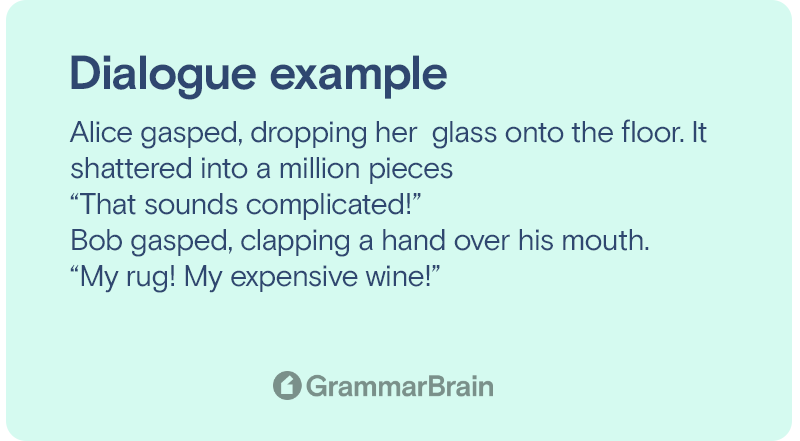
2. Keep your dialogue tags outside the quotation marks.
A dialogue tag is what tells your readers that a line of dialogue belongs to a specific speaker.
“Is this what you mean?” asked Alice.
“That is exactly what I mean,” said Bob, nodding.
“What about this asked Alice?”
“Now I have no idea how to read what you said,” said Bob.
3. Keep your punctuation inside the quotation marks.
As a rule of thumb, if you write the dialogue tag first, you want to bring the comma before the quotation mark .
But what if you use an exclamation mark or a question mark?
“Like this one?” asked Bob.
“Yes, exactly like that,“ said Alice.
In this situation, you write the following dialogue tag in lowercase instead of uppercase.
“Oh, God , punctuation! My mortal enemy!” said Alice, shaking her fist at the skies.
Very good, Alice.
Tip: If your line of dialogue ends in an exclamation point or question mark, the tags that follow should be in lowercase.
3. Use a separate sentence for actions that happen before and after your dialogues.
Any action or movement should be given its own sentence next to your dialogue.
Alice gasped, dropping her glass onto the floor. It shattered into a million pieces.
“That sounds complicated!”
Bob gasped, clapping a hand over his mouth.
“My rug! My expensive wine!”
4. Never use double quotes inside dialogue. Use single quotes instead.
If your character is quoting someone else, make sure you use single quotes, or your text will quickly get confusing.
“I remember a nice Englishman that once said, ‘To be or not to be,’” said Bob, “But I don’t remember the question.”
5. Indicate new speakers with new paragraphs.
Every time you change a speaker, you must start a new paragraph. If you are writing a manuscript, you must also indent the paragraph.
If your character performs an action, keep the action in the same paragraph. Only then should you move to the following line in the next paragraph when you bring in your new speaker.
“We’re all out of wine!” said Alice. She pointed at the empty bottle in her hands.
“Can you please not break any more glasses?” said Bob as he gingerly picked up pieces of shattered glass with gloved hands.
6. Every time an action interrupts your dialogue, begin with lowercase again.
“At the end of the day,” Alice whispered to herself, placing the bottle tenderly on the table, “why does all the wine disappear?”
7. Indicate an interruption with an em dash.
Em dashes are not the same as hyphens. They are used to show readers that a line of dialogue has been cut off mid-sentence.
You should always place your dash inside the quotation marks, just as you would with all other punctuation marks . If you’d like a refresher on the difference between an em dash and a hyphen , read this .
Bob returned with a new wine bottle in hand.
“This is a 1787 Chateau Lafite Rothschild,” said Bob, unable to keep the pride out of his voice, “it belonged to my—“
“Gimme!” said Alice, grabbing the bottle from his hands.
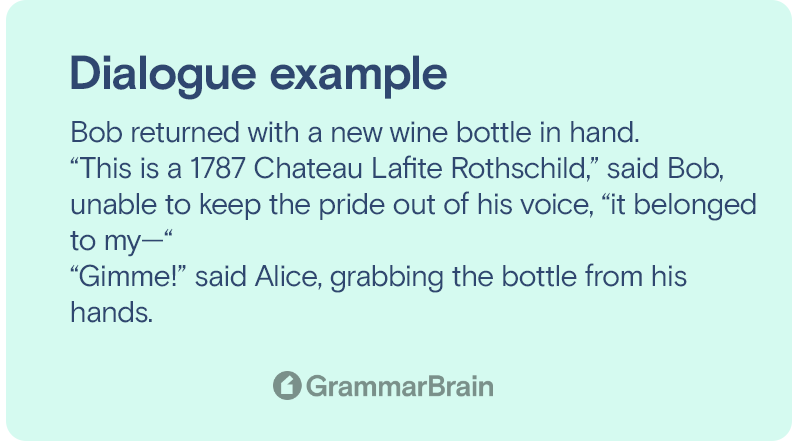
Writing Dialogue: Identifying a Speaker
Not all dialogue needs dialogue question.
“Yes. Really.”
But when you use a dialogue question, you must use a comma. You must place a comma, quotation, and dialogue tag, in that order.
Any punctuation in the sentence must come inside the quotes.
“You know,” said Alice, “I think I’m starting to get the hang of this.”
What if you don’t want to put the dialogue tag in the middle of the sentence? You must identify the speaker in advance by bringing attention to an action or gesture before writing their dialogue.
Bob sighed, settling into this chair.
“I’m happy to hear that, Alice.”
Sometimes, you will identify the speaker explicitly.
“And by explicit, you mean telling the reader outright who is speaking, right?” said Alice.
Sometimes, you will identify the speaker implicitly.
“That is exactly what that means, Alice, dear, yes.”
The above dialogue does not have the speaker referenced by name. But with the help of context and preceding dialogue, we can tell exactly who is speaking.
At other times, we will identify the speaker through anaphora.
“What does anaphora mean?” asked the clumsy yet enthusiastic lady.
“It means indirectly identifying the speaker without using their name, dear,” came the unhappy man’s response.
Other times, you can identify the speaker even when a dialogue tag is not used. This happens when the dialogue directly refers to the person being spoken to, making the speaker obvious.
“I’m referring to you now, Alice.”
“I know, Bob, you don’t have to tell me.”
Readers get tired of the whole “he said,” “she said,” business if it’s overdone. You want to juggle different methods of identifying the speaker as you write, making sure to sprinkle in clues about who the speaker is.
This prevents stale and overdone writing. It adds spice to an otherwise repetitive piece of prose and breathes life into the text.
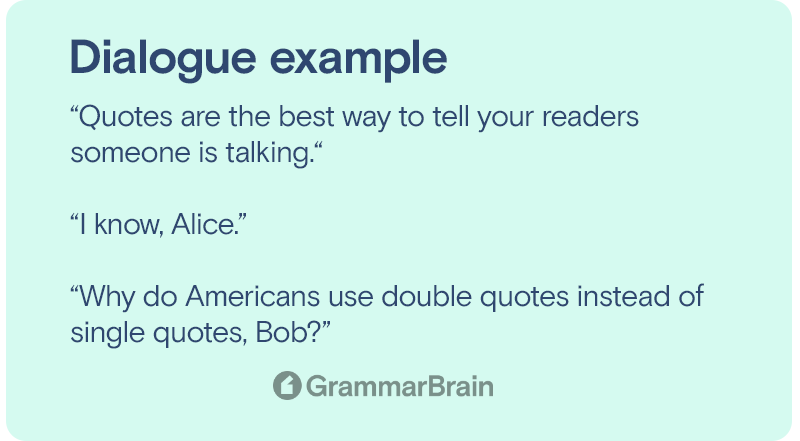
How To Format Dialogue (Formatting Dialogue Examples)
When writing a manuscript, begin the first line of each paragraph indented.
If using British English, use single quotation marks.
If using American English, use double quotation marks.
But whatever the region, enclose the spoken words inside the quotation marks.
“Quotes are the best way to tell your readers someone is talking.“
“I know, Alice.”
“Why do Americans use double quotes instead of single quotes, Bob?”
Bob shrugged.
“That’s just the way it is. The same reason the English add the letter ‘u’ in many of their words while Americans don’t.”
(If you’d like to read an expert’s opinion on why different regions use single and double quotes, read this )
Always keep dialogue tag/questions out of your quotes
“But enough about grammar , Alice,” said Bob, sinking into his chair.
“Look at the nice weather we’re having.”
“I can see the sun for once, yes,” said Alice.
“What a sight to behold,” said Bob, smiling.
Don’t forget to use lowercase when following up a dialogue tag that has a quotation or exclamation mark.
“On the whole, this has been a surprisingly good day, don’t you think?” said Alice.
“Except for the part where you spilled my expensive wine all over the carpet!” shouted Bob.
There was a pause as Alice sank into her chair.
Make sure that all actions before and after the dialogue go into a separate sentence.
Alice placed the glass to her lips.
“Hey, this isn’t half bad !”
Bob smiled, pointing to the bottle he’d set on the table.
“It was my grandfather’s. I’m glad you like it.”
Make sure to place all punctuation inside the quotes
“I’m sorry ,” said Alice, setting her glass down, “I was just excited.”
“No, no,” said Bob, waving a dismissive hand, “don’t worry about it.”
The ellipsis deserves a special mention here. If you end any dialogue with an ellipsis, make sure not to add further punctuation, such as a comma after it. (For some extra tips on formatting your dialogue, read this .)
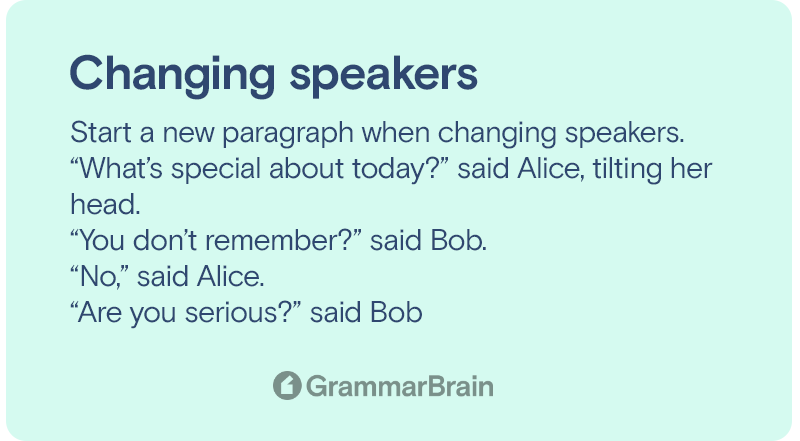

For instance, you would never write:
“I miss granddad…,” said Bob, his eyes misting over.
You would instead write:
“I miss granddad…” said Bob, his eyes misting over.
Always place single quotes within double quotes when referencing something from an outside source. This includes famous proverbs, cliches, and dialogues that other characters in your story have used in the past .
“’Save it for a special one, boyo,’” said Bob, smiling, “that’s what my granddad said when he gave me that.”
Start a new paragraph when changing speakers.
“What’s special about today?” said Alice, tilting her head.
“You don’t remember?” said Bob.
“No,” said Alice.
“Are you serious?” said Bob.
Alice frowned, trying to remember. She looked up at him and shrugged.
Writing Compelling Dialogue
1. subtext is king..
People in real life often have wide gaps between what they say and think. There are also gaps between what a character understands and what they refuse to hear.
Two characters that know each other often have more unspoken dialogue than spoken dialogue. These are vital and valuable territories that writers can take advantage of to create drama and tension.
2. Good dialogue advances the plot and reveals character.
Characters speak for a reason. Desire forces characters to interact; through this interaction, we witness the unraveling of events and scenarios.
These events either push them away or toward achieving the story’s primary goal. Dialogue is also best to show how your characters feel instead of just telling your readers how they feel. You introduce context through dialogue and use it to reveal how a character thinks about someone.
3. Dialogue reflects your character’s background.
Each person has their way of speaking. A brute and a scientist have noticeably different syntaxes of speech where readers can peer into their thought processes by examining the words they use and how they say them.
Social class, upbringing, personality, and coping mechanisms also factor into how a character speaks.
4. Keep your dialogue tags simple.
The most straightforward dialogue tags are often the best. While many critics believe that writers should never use words other than “said,” others believe it’s okay to have a little variety.
A few dialogue tags like “called” or “muttered” can be illustrative and draw attention to critical moments and emotions.
Others believe mentioning a single adverb is an outright sin, but they have their place in descriptive prose. You can read more about writing engaging dialogue here .
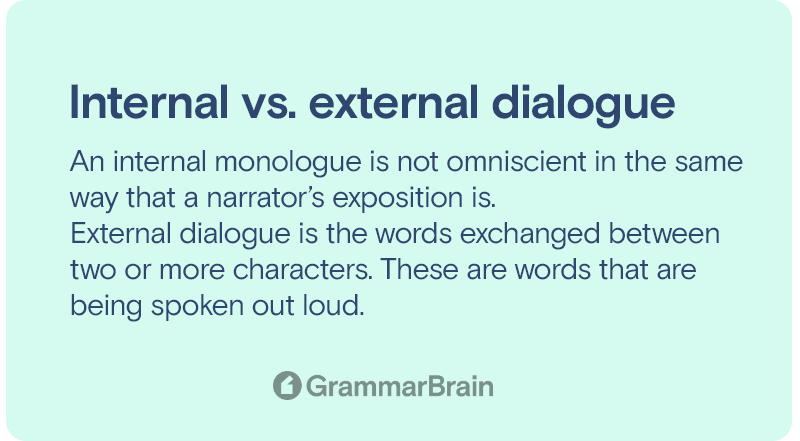
Internal Monologue Versus External Dialogue
An internal monologue is nothing more than the character’s innermost thoughts that the writer is exposing to the audience. This monologue contains the character’s voice and serves as a way for readers to understand the character’s thought processes better.
This monologue does not reveal every thought the character has but is used to display selective emotions and thought processes in response to meaningful story events.
An internal monologue is not omniscient in the same way that a narrator’s exposition is.
External dialogue is the words exchanged between two or more characters. These are words that are being spoken out loud.
This dialogue is often accompanied by dialogue tags, action tags, and descriptions.
If you’d like to learn more about how to create a compelling internal monologue, read this .

How to Punctuate Dialogue Correctly
Literary dialogue has its own rules for punctuation. In most instances, commas, periods, question marks, and exclamation marks go inside the quotations.
“It’s a beautiful and happy day today,” he said.
“What a beautiful day!” he said.
“Isn’t this a beautiful day?” he asked.
The one exception to this rule regards question marks.
When a character is referencing a proverb/statement/cliche that contains a question, we place the question mark outside the quotation mark to denote that it is a reference to something.
Did the professor say, “The equation goes here”?
For a more comprehensive list of rules on punctuation, read this .
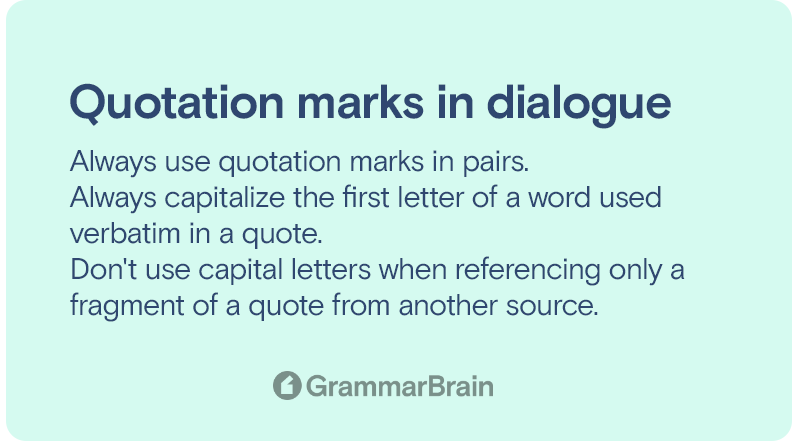
When and How to Use Quotation Marks in Dialogue
The primary purpose of a quotation mark is to indicate words being spoken by a character or referenced from an outside source.
Using them in literature or formal documentation comes with specific rules.
- Always use quotation marks in pairs.
- Always capitalize the first letter of a word used verbatim in a quote.
- Don’t use capital letters when referencing only a fragment of a quote from another source.
- The period or comma always comes before the final quotation mark. The only exception to this is content written explicitly by the Modern Language Association (MLA) style guidelines.
The quotation mark has a long and fascinating history which you can learn more about here .
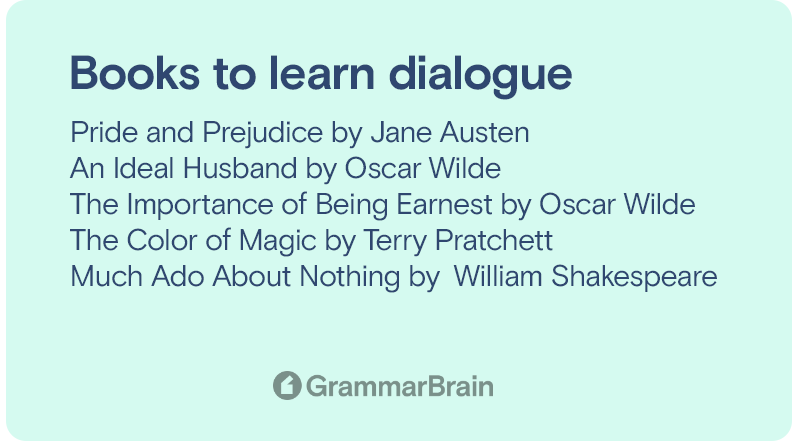
The Best Books to Learn Dialogue
Emulating the masters is the perfect way for beginners to learn. I’ve compiled this short list of books widely regarded as having some of the best dialogue in fiction.
Once you read these, mimic the style of the masters and add your unique flair to create your style of dialogue.
- Pride and Prejudice by Jane Austen
- An Ideal Husband by Oscar Wilde
- The Importance of Being Earnest by Oscar Wilde
- The Color of Magic by Terry Pratchett
- Much Ado About Nothing by William Shakespeare
- Wuthering Heights by Emily Brontë
- Kiss an Angel by Susan Elizabeth Phillips
- The Secret History by Donna Tartt
While literary fiction contains some of the best dialogue, screenplays are another source of good dialogue.
Screenplays focus exclusively on dialogue, ignoring literary devices such as descriptions and dialogue tags. You can read more about writing dialogue in screenplays here .
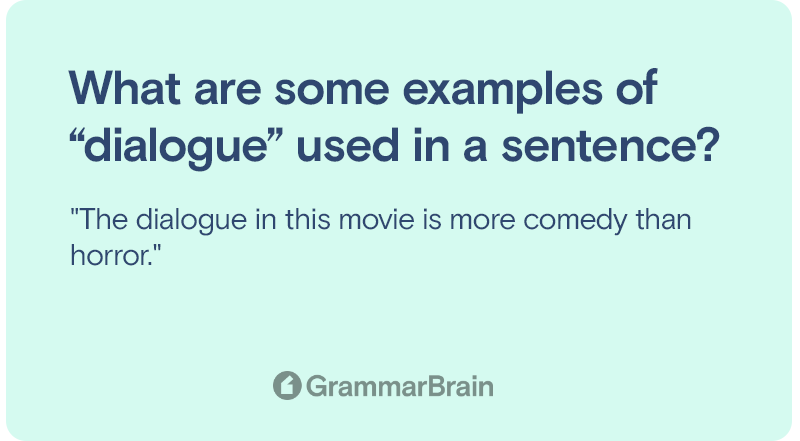
Speak Your Story
Dialogue is an indispensable part of every story. It helps to move a story forward. One character can present new ideas to another. Helping to advance a short story or written novel. Written well helps you create memorable characters and explore fun and dramatic situations.
But poor, overly formal, stilted, or illogical dialogue can quickly drive readers away. The best way to improve your dialogue writing is to talk to more people and read more books.
Read genres out of your comfort zone to see how different stories make characters tick and transform.
”Good morning, Little Red Riding Hood.”
“Good morning, Mr. Wolf.”
“Where are you off so early in the morning?”
“I’m going to my grandma’s with some bread and honey!”
“The dialogue in this movie is more comedy than horror.”
“Socratic dialogue is a conversation between people where questions are constantly asked to make people think critically.”
Inside this article
Fact checked: Content is rigorously reviewed by a team of qualified and experienced fact checkers. Fact checkers review articles for factual accuracy, relevance, and timeliness. Learn more.

About the author
Dalia Y.: Dalia is an English Major and linguistics expert with an additional degree in Psychology. Dalia has featured articles on Forbes, Inc, Fast Company, Grammarly, and many more. She covers English, ESL, and all things grammar on GrammarBrain.
Core lessons
- Abstract Noun
- Accusative Case
- Active Sentence
- Alliteration
- Adjective Clause
- Adjective Phrase
- Adverbial Clause
- Appositive Phrase
- Body Paragraph
- Compound Adjective
- Complex Sentence
- Compound Words
- Compound Predicate
- Common Noun
- Comparative Adjective
- Comparative and Superlative
- Compound Noun
- Compound Subject
- Compound Sentence
- Copular Verb
- Collective Noun
- Colloquialism
- Conciseness
- Conditional
- Concrete Noun
- Conjunction
- Conjugation
- Conditional Sentence
- Comma Splice
- Correlative Conjunction
- Coordinating Conjunction
- Coordinate Adjective
- Cumulative Adjective
- Dative Case
- Declarative Statement
- Direct Object Pronoun
- Direct Object
- Dangling Modifier
- Demonstrative Pronoun
- Demonstrative Adjective
- Direct Characterization
- Definite Article
- Doublespeak
- Equivocation Fallacy
- Future Perfect Progressive
- Future Simple
- Future Perfect Continuous
- Future Perfect
- First Conditional
- Gerund Phrase
- Genitive Case
- Helping Verb
- Irregular Adjective
- Irregular Verb
- Imperative Sentence
- Indefinite Article
- Intransitive Verb
- Introductory Phrase
- Indefinite Pronoun
- Indirect Characterization
- Interrogative Sentence
- Intensive Pronoun
- Inanimate Object
- Indefinite Tense
- Infinitive Phrase
- Interjection
- Intensifier
- Indicative Mood
- Juxtaposition
- Linking Verb
- Misplaced Modifier
- Nominative Case
- Noun Adjective
- Object Pronoun
- Object Complement
- Order of Adjectives
- Parallelism
- Prepositional Phrase
- Past Simple Tense
- Past Continuous Tense
- Past Perfect Tense
- Past Progressive Tense
- Present Simple Tense
- Present Perfect Tense
- Personal Pronoun
- Personification
- Persuasive Writing
- Parallel Structure
- Phrasal Verb
- Predicate Adjective
- Predicate Nominative
- Phonetic Language
- Plural Noun
- Punctuation
- Punctuation Marks
- Preposition
- Preposition of Place
- Parts of Speech
- Possessive Adjective
- Possessive Determiner
- Possessive Case
- Possessive Noun
- Proper Adjective
- Proper Noun
- Present Participle
- Quotation Marks
- Relative Pronoun
- Reflexive Pronoun
- Reciprocal Pronoun
- Subordinating Conjunction
- Simple Future Tense
- Stative Verb
- Subjunctive
- Subject Complement
- Subject of a Sentence
- Sentence Variety
- Second Conditional
- Superlative Adjective
- Slash Symbol
- Topic Sentence
- Types of Nouns
- Types of Sentences
- Uncountable Noun
- Vowels and Consonants
Popular lessons

Stay awhile. Your weekly dose of grammar and English fun.

The world's best online resource for learning English. Understand words, phrases, slang terms, and all other variations of the English language.
- Abbreviations
- Editorial Policy
Talk to our experts
1800-120-456-456
- Dialogue Writing

What is Dialogue Writing?
If you want to write a story, dialogues are a very important part of the story. Writing a good dialogue requires a set of rules to follow because a bad dialogue can change the story and the dialogue’s meaning as well. Dialogue writing is a very important part of English writing.
Dialogue is basically a conversation between two or more people. In fiction, it is a verbal conversation between two or more conversations. Sometimes it is a self-talking dialogue, they are known as a Monolog.
If the dialogue is bad the reader will put the book down. Without effective dialogues, the whole plot of the story will collapse on its own structure. Therefore, writing dialogue in a way that attracts the reader to be more involved in the story is not a daunting task. We will guide you to write impactful dialogue with correct rules.
Points to be Remember
1. The students need to read the preceding and the following dialogues.
2. They must understand the topic well and make points.
3. The tenses should be accurate according to the dialogue.
4. It should seem like a natural conversation.
5. The words used should not be vague and should convey the message.
Tips to Write Dialogue
Speak out the Dialogue loudly as it will help you resonate on your own dialogue and make you understand how it will sound to the reader.
Keep your dialogue brief and impactful as adding extra details will only deviate the reader’s mind from the main point.
Give each character a unique way of talking or voice. It will add an extra character trait and readers can identify the character just by reading his dialogue.
While writing the dialogue always remember whom the dialogue is being addressed to.
Dialogues should not be lengthy and confusing for the readers as through the dialogue only the story moves.
Format of Dialogue Writing
New Paragraph for Every Speaker
Every speaker gets a new paragraph. Each time a speaker says something, you have to put in a fresh paragraph, even if it is just one word.
Punctuations Come under Quotation Marks
All the punctuations used with dialogue must be put under the quotes.
Remove End Quote if the Paragraph is Long
If the paragraph of dialogue is too long and you need to change the paragraph, then there is no need to put end quotes.
Dialogue Tags
Dialogue tags i.e. He says/she says are always written outside the dialogue and is separated by a comma. When dialogue ends in a question or exclamation mark, tags that follow start in lower case.
For eg- He says, “We should start our own business.”
Use Single Quotation Mark to Quote Something with a Dialogue
If you have to quote something within a dialogue we should put single quotes as double quotes are already enclosing the main dialogue.
For eg- Bill shouted, “ ‘boo!’ you lost the game.
The Dialogue Ends with an Ellipsis
If the Dialogue ends with an ellipsis, we should not add a comma or any other punctuation. For eg- She stared at the sunset. “I guess you’ll go back to doing what you do and I will…” her voice drifted off.
Solved Example
1. Write a Dialogue between You and Your Teacher about which Course to Study at Vacations.
Child- Good Morning Sir, how are you?
Teacher- I am completely fine. What about you?
Student- I was wondering which course to learn in my vacation.
Teacher- It can be confusing with so many options online. You should make a list and narrow it down as per your interest.
Student- I have tried that but still I am left with three options- Artificial Intelligence, Machine learning or Data science.
Teacher- Well! All of them are very interesting courses, but as far as I remember you have always been interested in Artificial Intelligence.
Student- Yes! I do because I feel it is our future.
Teacher- Well then its no harm in pursuing it and later if you find it less interesting you can always switch.
Student- Yes it sounds like a great idea. Thanks!
2. Complete the following Dialogues-
Megha calls up Rajat to make a plan for New years. Complete the dialogue between Megha and Rajat by filling in the gaps.
Megha : (i) ………………….. this New year?
Rajat: I don’t have any plans.
Megha: How do you like the idea (ii) …………………. the Sapna’s party?
Rajat: That sounds fantastic, But I (iii) ………………….my parent’s permission.
Megha: I’ll come to your house this evening and request your parents to allow you to join me to go to a party.
Rajat: Ok.
Megha : (iv) …………………….. in the evening?
Rajat: Yes. They will be at home.
Rohit: Then I’ll surely come.
Basic Rules for Discussion All Writers Should Follow
Here are some basic rules for writing a conversation:
Each speaker receives a new category - Every time someone speaks, he shows this by creating a new category. Yes, even if your characters say only one word, they get new categories.
Each category has an indent - The only exception to this is at the beginning of the chapter or after the break, where the first line has not been postponed, including the discussion.
The punctuation marks are inserted into the quotes - Whenever punctuation is part of the spoken word, it enters the quotation marks so that the reader can know how the dialogue is spoken.
Long sentences with few paragraphs do not have end quotations - You’ll see a lot of this below, but overall, when one character speaks for a long time with different categories, the quotation marks are eventually removed, but you start the next paragraph with them.
Use singular quotes when a speaker quotes another - If a character is present who says, “Rohan, do you like it when girls say,‘ I’m fine ’?”, One quote shows what someone else said.
Skip the small talk and focus on the important information only - Unless that little talk is accompanied by character development, skip and get to the point, this is not real life and you will feel very liable if you have too much.

FAQs on Dialogue Writing
1. Can we write dialogues without Quotes?
No, a quotation mark is very important as it distinguishes between the rest of the text and dialogues. The characters who speak the dialogues are an important source of the quotes because of which we are required to put quotes in the dialogues. Quotations add life to the dialogues by making them more realistic and genuine. It ensures that the interpersonal skills of the people using dialogues is improved. It is an interpersonal discourse with members of your society or your house.
2. What are Dialog Tags?
Dialogue tags are the phrases like, “he said”, “She said'', they attribute the speaker to the dialogue so that the reader always knows who is speaking the dialogue. Dialogue tags are the short lines in a sentence that are used to identify the speaker. The main function of a Dialogue tag in dialogue writing is for identifying who is speaking. The Vedantu website provides all the guidelines as to how the dialogue writing must be planned. Until you use a proper noun, the dialogue tag will not be capitalized. You have to end the dialogue with punctuation marks inside quotes.
3. What is Ellipsis in a dialogue?
Three dots are used at the end of the sentence to show that something has been omitted. Using ellipses in dialogues is done to indicate a disruption at the end of a line of dialogue. The general rule of adding ellipses at the end of dialogue or line is to indicate that a speaker faltered before completing his or her statement. Ellipses are the most passive-aggressive of all the punctuation marks as when they are used in casual conversation, ellipses connote hesitation, confusion, and apathy.
4. What is the Purpose of Dialogue writing?
Dialogues are referred to as the conversations between two or more characters and it’s called a monolog if there is only one character speaking which is sometimes used in plays. There are several factors on which the character speaking depends.
Where they live
The period in which they live
The dialogue should move the story forward. It may increase suspense, show readers a trait(s) of the character(s), and/or change the situation or conflict the characters are in.
5. Why choose Vedantu to refer to the rules of dialogue writing?
Till now the students must have reviewed the entire website of Vedantu and also must have found the answers to whatever they must search for. Vedantu without any doubt is the best website as it provides comprehensive solutions to all the doubts of the students. The experts at Vedantu are not only providing concepts related to the base building of the students but also are giving the students the ability and urge to read and write more. Hence, the students are highly recommended to use Vedantu.
How to Punctuate Dialogue – Rules & Examples (Worksheet)
| Danielle McLeod
| Punctuation
Danielle McLeod
Danielle McLeod is a highly qualified secondary English Language Arts Instructor who brings a diverse educational background to her classroom. With degrees in science, English, and literacy, she has worked to create cross-curricular materials to bridge learning gaps and help students focus on effective writing and speech techniques. Currently working as a dual credit technical writing instructor at a Career and Technical Education Center, her curriculum development surrounds student focus on effective communication for future career choices.
I’m an avid reader, and I never think twice about the punctuation that makes dialog so easy to read, allowing you to flow from one conversation to the next. With so much exposure to the technique, you’d think it would be easy to reproduce – but nothing could be further from the truth.
Punctuating dialogue properly eludes even the most voracious reader. And, it’s truly no surprise since you must remember more than one rule concerning quotations, terminal marks, and comma use when all mashed together.
Knowing how to punctuate dialogue correctly is important to help develop your characters and make them more interesting to your reader. Take a look at our dialog writing tips to help you develop your storyline for a more exciting read.
The Importance of Well-Written Dialog
Writers depend upon dialog to help bring their characters to life and allow readers to form relationships with the story they are immersed in. Good dialog punctuation helps create flow and clarity, lends tone to the sentences being spoken, and creates connections between characters and the overall storyline.
Poorly constructed sentences that feel wooden and stiff are common mistakes writers make when new to the technique. But, with practice and knowledge of strong dialog sentence structure, it doesn’t take long for them to become more confident writers.
The Rules of Dialog Writing

To avoid errors in dialogue punctuation, you must keep some precise rules in mind.
A good story uses direct and indirect dialogue between characters and dialogue with narration to enhance the storyline. This creates lines of text that can quickly become confusing when punctuation or grammar is ignored or, worse yet – used incorrectly.
Review these ten rules for punctuating dialogue to help create captivating dialogue that draws your reader into an original storyline.
Rule #1: Direct Speech Requires Double Quotation Marks
If you are in the US, you use the double closing quotation marks to indicate spoken, direct dialogue. This is the first step in punctuating dialogue correctly.
For example:
- “Mom, Sanna and I only went to the store, and we came right back!” exclaimed Sarah.
- Maxine wasn’t so sure, asking, “If I spoke to Mr. Hooper, would he tell me he saw you there?”
British or Commonwealth English uses a single quotation mark, but both styles indicate the same thing.
This article focuses on the American English standard widely accepted by the Chicago Style Manual to avoid confusion.
Rule #2: Periods (and Other End Marks) Belong Inside Quotation Mark
Misplaced periods and other end marks are common mistakes when writing dialogue. Complete spoken sentences should always end with the end mark inside the quotation marks.
- She reviewed the essay, stating, “You’ll need to proofread for corrections.”
- She watched the light turn green and, glancing sideways, said, “What if we kept driving and just didn’t stop?”
Rule #3: Comma Placement is Dictated by Speaker Attribution
The majority of written dialogue is attributed to a speaker using dialogue tags. This helps a reader keep track of who is speaking, especially when back-and-forth dialog is used between two or more characters.
An attribute is a simple way to give credit to a speaker. These can be as simple as she said or he replied . They can also be more detailed, providing tone or behavioral hints, such as she rolled her eyes, leaned forward, and whispered .
When the attribute comes before the dialogue, place the comma outside the quotation marks.
- She exclaimed, “There is no way I will be involved with that plan.”
- He wasn’t impressed, looked her in the eyes, and stated, “You promised to take part in this all.”
When the attribute comes after dialogue, you place the comma inside the quotation marks.
- “I’m heading to the store,” Sarah told her mother.
- “Go straight there and back,” was the reply.
Rule #4: Always Begin New Sentences with a Capitalization
Dialogue dictates that new sentences always begin with capitalization, even when following an attribute. This may be slightly different than other rules of quotation use, but it is important to help highlight the speech of your characters.
- She turned to him smiling and spoke her thoughts aloud, “If I were to leave, what would you do?”
Do not capitalize dialog that follows an interrupting attribute.
- He smiled back, “I’d follow you,” he replied, “anywhere you go.”
Rule #5: Start a New Paragraph Each Time the Speaker Changes
One of the most important rules of organizing dialogue is to begin a new paragraph each time the speaker changes. This provides a visual of who is speaking and is especially important to avoid the overuse of attributes during back-and-forth dialogue.
To indicate a new paragraph, leave a space between each line.
“Why are you here so early?” asked the teacher, looking down on the little blond head riddled with cowlicks.
The student looked up at her, blinking, “I need to study for my test today, and our power was out at the house.”
“Oh no! Of course, you can study here. I was just going to make some coffee. Would you like some cocoa to help get focused?”
“Yes. Thank you!”
“No problem. You can study early anytime you need to. I’m almost always here by this time.” She walked into the lounge, shaking her head, knowing he wasn’t the only student that needed a warm, lighted place to start the day in.
Rule #6: Use Action Beats to Replace Dialogue Tags
Dialogue tags can become very monotonous in their use and take away from the tone of what is being said when overused. Consider using action beats that describe what the character is doing while they are speaking to help add detail and action to your dialogue.
Dialogue punctuation rules stay the same with action beats.
“Hmmmmm.” He rubbed his chin and glanced at the clock. “I’m just as confused as you are, but at the moment, I don’t have time to think about it.” He stood up, ushering the children towards the door. “Come back tomorrow when we can discuss this further.”
“But, tomorrow will be too late!” The children turned away from the door. “By then, she could be gone altogether!”
Rule #7: Avoid Closing Quotations Between Paragraphs of Speech
When a character speaks more than a few sentences in a row, you can split their extended speech up into multiple individual paragraphs. When you do this, you indicate to the reader the speech is not over by omitting the closing punctuation marks.
Still provide open quotation marks at the start of the new paragraph.
“It wasn’t difficult for me to find out what you all had been up to last night.” His mother looked them over, “I had the porch camera on, and it triggered the garage light. When I saw that come on, I knew somebody had to be coming in through the back to avoid waking me up. What you didn’t know was I was already awake.
“Although I didn’t say anything at the time, I checked with Mark’s mother this morning, and she let me know he had told her he was staying over here.” She wasn’t happy, and he knew he was in for it.
She continued on, “You told me you were staying at Mark’s house. So, of course, I wanted to know what you both were hiding from us.
“When I saw that you had the cellar door cracked open, I knew where you had to be keeping her.” She paused, “James, I told you we couldn’t afford to feed another dog, and now she’s down there with her puppies. What did you do that night? Go out to the tracks and carry them all back here thinking I would never notice?”
He nodded, “But, mom…” and looked up at her, “they would have died if we left them out there.”
Rule #8: Use Em-Dashes and Ellipses to Interrupt Speech
If you need to indicate an interruption in dialogue due to being cut off or a pause in speech, then you will use an em-dash or ellipses within the quotation marks.
“I know you care a lot about him, but — “
She interrupted, “You don’t understand that he’s just a friend!”
“— you aren’t going to camp with him this summer.” Her father finished.
“Listen, I just need to know what is going on…” she looked at her beseechingly.
Jen sighed, “I’ll explain it all one day. I just can’t right now.”
Rule #9: Use Single Quotes When Your Character is Quoting Someone or Something
If you are wondering how to use quotation marks within the dialogue to indicate a character directly quoting another, you need to use single quotation marks. A dialogue with quotes within it specifically highlights the thoughts or words of another person.
“Tell me what the professor said was going to be on the test again.”
“He said the test would last 2 hours and to ‘read through the first two chapters, review all the vocabulary, and be able to explain the photosynthesis process.’”
Rule #10: Use Italics for Thoughts and Internal Monologues
Avoid using quotations for internal dialogue and monologues. Although, as an author, you can take artistic license and choose to use quotations, it is generally accepted to use italics in this manner if your text also includes spoken dialogue to avoid confusing the two. Just be sure to be consistent with their use.
The kitten sat at the window, eyes big and begging to be let inside.
Kimberly knew her mother would be mad, but, What she doesn’t find out won’t kill her , she thought as she opened the window.
Let’s Review
Writing dialog punctuation isn’t as tricky as it may seem at first as long as you follow these dialogue example rules. End marks, commas, and quotation marks in a dialog should be kept consistent in their use to provide clarity and flow to written conversation.
Always enclose dialog in double quotation marks, using single quotation marks to indicate a quote spoken by a character. End parks belong inside the quotations, while comma placement is determined by speaker attribution.
Grammarist is a participant in the Amazon Services LLC Associates Program, an affiliate advertising program designed to provide a means for sites to earn advertising fees by advertising and linking to Amazon.com. When you buy via the links on our site, we may earn an affiliate commission at no cost to you.
2024 © Grammarist, a Found First Marketing company. All rights reserved.
English that goes straight to the heart
Dialogue Writing Examples
A dialogue literally means a talk between two people. It is an exchange of thoughts and opinions on any kind of topic or issue.
A dialogue may either aim to form a concurrence of thought or differentiate one’s point of view from the others.
Daily Test - Attempt Now
The writing of dialogues in English is a useful form of composition for students trying to gain a command of spoken English. In this post, you will find the Top 10 Dialogue Writing Examples.

Dialogue Writing Examples #1
Reporter: Hello, my name is Mr. Thomson. I am a reporter for IBN and would like to meet Mr. Jack.
Secretary: Do you have an appointment?
Reporter: I do not have a formal one, but I spoke to him on the phone and he said that I could come today.
Secretary: You will have to wait for some time since Mr. Jack is in a meeting right now.
Reporter: How long will the meeting last?
Secretary: It should be over in about 15 minutes.
Reporter: That’s fine with me.
Secretary: Would you like some tea or coffee?
Reporter: No, thanks for asking.
Secretary: You’re welcome. Please have a seat. I will let you know as soon as he is free.
Reporter: I appreciate your cooperation.
Also, Read Dialogue Writing Topics
Dialogue Writing Examples #2
Anjuna: Hi Sweta, what a pleasant surprise! It’s a pleasure seeing a school friend after so many years.
Sweta: Indeed it is. How are you and what have you been up to?
Anjuna: I am great. Do you remember the paintings I made for pleasure in school?
Sweta: Yes I do, and I always told you what a great artist you would be one day.
Anjuna: Well, I guess you were right there.
Sweta: What do you mean?
Anjuna: After college, I studied painting at J. K. School of Art and today I am a professional painter.
Sweta: Oh really? That’s great news. I never doubted your potential.
Anjuna: I know, and I believe that the confidence you showed in me was one of the factors which encouraged me to conquer my dreams.
Sweta: Don’t flatter me. This is all the fruit of your hard work.
Anjuna: I am not. Believe me. I never considered my drawings of any consequence. It was you who saw the talent in me and gave me the boost I needed.
Sweta: Well then, I guess I deserve a treat.
Anjuna: You deserve more than that, but a treat is surely in order.
Sweta: Let’s have coffee.
Also, Read Conversation Dialogue Examples for Students
Dialogue Writing Examples #3
Omkar: Hey what are you doing? Would you like to come out to play?
Arvind: No. I’m a little busy right now. I’m writing a story for tomorrow’s storytelling competition.
Omkar: You have been working on that since the last week. How much more will you edit it?
Arvind: It’s a suspense story, Omkar. It has to be perfect or else it will lose its charm.
Omkar: That is true, but I have full faith in your skills. After all, you have been winning this competition for so many years now.
Arvind: That’s true. But that does not give me a reason to be careless with my work, does it?
Omkar: Yes you are right, but overdoing it is also dangerous, don’t you think?
Arvind: What do you mean?
Omkar: I mean you are so focused on this competition that you are neglecting every other thing like food, play, and your studies.
Arvind: I guess you have a point, Omkar. Come on, let’s go out.
Omkar: Finally! Let’s go.
Also, Read Short Dialogue Examples
Dialogue Writing Examples #4
Teacher: Ranita, are you ready for the interschool history quiz?
Ranita: No Miss, I am not. I had jaundice last month, and therefore, I couldn’t prepare for it.
Teacher: You are our best student, Ranita. You have to participate. How long will it take to prepare?
Ranita: Miss, please give me an extension. I am working on it, but I need some more time.
Teacher: Ranita, I would love to give you time. But I’m sorry I cannot; the date for the quiz is finalized by the principals of all the schools participating.
Ranita: I would really love to participate, but I am not prepared and it will be wrong on my part to spoil the school’s name this way.
Teacher: I appreciate your dedication. Also, I am confident that you will be able to do well. You just need to work a little harder. Besides, we are here to help you. Feel free to approach any one of us whenever you need.
Ranita: Thank you for your support, Miss.
Teacher: You are most welcome. Work hard and make us all proud.
Ranita: I’ll try my best, Miss. Thank you once again.
Also, Read How to Write a Dialogue?
Dialogue Writing Examples #5
Priya: Hello! My name is Priya. Can I speak to you for a moment?
Police Officer: Yes, how may I help you?
Priya: I have a robbery to complain about.
Police Officer: What exactly happened?
Priya: My handbag was stolen in the local market this afternoon.
Police Officer: Describe your handbag and give me a list of any important belongings that it contained.
Priya: My handbag is blue. It had my cell phone and about three thousand rupees.
Police Officer: Is that it? Did it have any other things?
Priya: Nothing of much importance. But I need my cell phone; the data in it is extremely important to me.
Police Officer: I will look into the matter and see what I can do. Did you see the thief?
Priya: Yes, I noticed that he was of average height, middle-aged, and wore a dirty grey t-shirt. He had medium-tangled hair and a small bruise over his right eyebrow.
Police Officer: Will you be able to recognize him if we find them?
Priya: I think so.
Police Officer: Okay then. We will call you when we get a lead on him.
Priya: Thank you!
Police Officer: You’re welcome!
You Asked, We Listened – Get Free Access to All Writing Lists 😍😍
Dialogue Writing Examples #6
Bank Manager: Good morning! Please come in. How may I help you?
Raj Singh: Good Morning! I would like to open a savings account with your bank, but I find the process very confusing.
Bank Manager: Please take a seat. The process is very simple actually. All you have to do is fill out a savings account opening form and submit it with photocopies of your ID proofs and two passport-sized photographs.
Raj Singh: Which ID proofs should I get along with?
Bank Manager: We will need one photocopy of each of your ration cards, pan card, and Aadhar card.
Raj Singh: Ok, that sounds easy. Where will I get the account opening form?
Bank Manager: The clerk sitting at the desk opposite the cash counter will give it to you.
Raj Singh: What is the minimum deposit amount for opening an account?
Bank Manager: For a savings account, it is only 500 rupees. However, this amount cannot be withdrawn unless you wish to close your account permanently.
Raj Singh: What are the other facilities that I would be provided if I open an account?
Bank Manager: Apart from your chequebook, SBI will provide you with an ATM/debit card, internet banking, and phone banking facility.
Raj Singh: Thanks a lot! You have really simplified the procedure for me.
Bank Manager: The pleasure is entirely mine.
Dialogue Writing Examples #7
Dr. Sunil: This is the third time in two months you have come to me complaining of stomach ache, Rakesh. Have you been eating frequently from outside?
Rakesh: I have my lunch from the school canteen, doctor.
Dr. Sunil: How is the food in taste and appearance?
Rakesh: The food tastes good, except that it is spicy sometimes. Often, it is soaked in excess oil.
Dr. Sunil: No wonder you are falling sick so often, Rakesh! Eating spicy food regularly upsets your digestive system. Does the oil in the food smell abnormal?
Rakesh: I don’t know really. But yes, my throat often aches after eating a meal that had excess oil.
Dr. Sunil: That is due to the poor quality of oil being used to make the food. Rakesh, you should stop eating from the canteen at once. If possible, eat home-cooked food and for a few weeks only eat light meals.
Rakesh: Okay, doctor. What can I include in my diet for the next few days?
Dr. Sunil: Have home-cooked food with minimum spices. Avoid over-intake of fibrous foods as they are heavy to digest. Have plenty of water and fruit. In a couple of weeks, your system will be back to normal.
Rakesh: Thank you, Doctor. I will avoid eating outside henceforth.
Dr. Sunil: Yes, you should. Here are your medicines. In addition, please also engage in light exercise once a day so that you remain fit.
Rakesh: I will do that, doctor. Thank you for your time and consultation.
Dr. Sunil: Take care and get well soon Rakesh!
Dialogue Writing Examples #8
Mother: Looks like you had a lot of fun at school today. How was the Christmas party?
Riya: It was a truly spectacular mother. The children from the primary section enacted the Christmas story at the assembly.
Mother: Oh! That must have been really beautiful.
Riya: It was! Not only that; after a short speech by our school leader on the significance of Christmas, the school band played carols on their instruments. Mumma, you should have heard them, for a moment I felt like heaven had come down to Earth.
Mother: That does sound exceptional. I understand what you mean. Your school has the reputation for excelling in whatever it does.
Riya: Yes Mumma, it was! After that, we went to our class. There we played games with our teacher. It was great fun. We also had crib-making and classroom decoration competitions.
Mother: So, they kept y’all busy the whole day. Did they give y’all any snacks to eat?
Riya: Yes, they gave us Fruity, samosas, wafers, cake, and chocolates. I got many gifts from Santa Claus as well. He kept throwing them in all directions.
Mother: Well Riya, I’m glad that you had so much fun.
Riya: That I did, wait for Mumma there is more. I forgot to show you the gift I got. Every standard received a different toy. We received Brainvita. Playing this game is so much fun.
Mother: So, I see you opened it in the school itself.
Riya: Yes! Everyone did. We were so engrossed in it that we did not even realize when the bell rang at the end of the day.
Mother: That’s very nice. Be sure to thank your teachers when you go to school next for all the effort they put in.
Dialogue Writing Examples #9
Rajesh: Excuse me, what is your name, sir?
Beggar: My name is Dinesh Kumar. Why do you ask? You don’t need my name to curse me.
Rajesh: I do not wish to curse you, Mr. Kumar. I never saw you here before. You intrigue me; therefore, I want to know more about you. Who are you and why are you begging here?
Beggar: I cannot recollect the last time somebody called me by that name.
Rajesh: Tell me something about yourself.
Beggar: You know my name. Many years ago, I used to be a successful businessman dealing with scrap metals. The business was booming and I was surrounded by friends. I got married to a woman I loved and she bore me two children. I was a very good father fulfilling every desire my children had.
Rajesh: What changed that?
Beggar: I had a daughter and a son. When they got married, things started changing. Both of them vied for my business and property which I bequeathed to them. Once my son had control of my business, he ousted me. My daughter too, whom I gave my palatial house, threw me and my wife out.
Rajesh: Where did you go from there?
Beggar: My friends deserted me since I had no money. So, I begged for a living making enough to buy us two meals a day. My wife eventually succumbed to illnesses leaving me all alone in this world. At this age, I cannot beg. Sometimes I wait for death to catch up with me.
Also, Read How to Write Dialogue Between Two Characters
Dialogue Writing Examples #10
Sushant: Hello! May I speak to Mr. S. Kaushik?
S. Kaushik: Yes, who is this?
Sushant: Hello Sir. My name is Sushant. I saw the advertisement for your activity club in today’s newspaper and would like to enquire more about it.
Mr. Shah: Oh yes! We have recently opened an activity club for children of all age groups. I will be able to explain it to you further if you can tell me what exactly you are looking for.
Sushant: My son has a lot of free time, and since both my wife and I are working we would like to enrol him in a creative club.
S. Kaushik: We would be happy to oblige. What would you like to know?
Sushant: First, where exactly are you located?
Mr. Shah: Our club is located on the ground floor of Pravin Apartments which is about a 2–3 minute walk from the Santa Cruz railway station.
Sushant: Okay, could you give me some more details about the place?
Mr. Shah: We have converted a 1BHK flat into our club area furnished with colourful toys and other amenities . We also have a large garden at the back which can be accessed only through our flat.
Sushant: The place sounds safe enough. What activities do y’all teach?
Mr. Shah: We teach all forms of dance, singing, and craft. It’s an extensive list. I suggest you visit us once since it is impossible for me to list everything we do on a call.
Sushant: Okay, I will do that. Thank you for the information. I will call you back once I make up my mind.
Finished reading our post Dialogue Writing Examples? We have more content for you…

Dialogue Writing – Format, Tips & Samples
Read More »

Dialogue Writing Topics

How to Write Dialogue Between Two Characters
Daily reading comprehension test - attempt now, 1 thought on “dialogue writing examples”.
What’s up, constantly i used to check web site posts here early in the daylight, as i love to learn more and more.
Comments are closed.
Discover more from English Luv
Subscribe now to keep reading and get access to the full archive.
Type your email…
Continue reading
Question and Answer forum for K12 Students

Dialogue Writing for Class 10 CBSE Format, Examples, Topics, Exercises
Basic English Grammar rules can be tricky. In this article, we’ll get you started with the basics of sentence structure, punctuation, parts of speech, and more.
We also providing Extra Questions for Class 10 English Chapter wise.
Dialogue Writing for Class 10 Format, Examples, Topics, Exercises PDF
Writing a dialogue must follow certain basic rules.
- The language should be simple depending upon the relationship between the speakers.
- Though a dialogue should read like real speech, the dull parts should be taken out. A real conversation would be completely boring to read. Edit out the filler words and unessential dialogue – that is, the dialogue that does not contribute to a given situation.
Sample Dialogue
David has met with an accident. His friends Rahul and Varun are talking about him. Read the dialogue between them. Rahul: Do you know that David was hit by a two-wheeler? Varun: Oh no! When did it happen? Rahul: He was hit by a motorcycle on his way back from school yesterday. Varun: How did it happen? Rahul: He was crossing the road at a zebra crossing when a speeding motorcyclist jumped the traffic light and knocked him down. Varun: Is he badly injured? Rahul: He has fractured his arm. Varun: Oh that’s sad! I suppose he will not be able to participated the Inter-school swimming competition next week. He was sure to have won the trophy this year, too. Rahul: Yes. He was quite upset about it.
Dialogue Writing Solved Example for Class 10 CBSE
Diagnostic Test – 14
Ram and Shyam are discussing their plans for the weekend. Complete the dialogue below in a suitable way in around 100 words. Ram: (a) …………………………. . Shyam: I don’t have any special plan. Ram: How do you like the idea (b) …………………………. . Shyam: That sounds lovely, but (c) …………………………. . Ram: I’ll come to your house this evening and request your parents to allow you to join the picnic. Shyam: Hey, that’s a good idea. Ram: (d) …………………………. . Shyam: Yes, I don’t think they are going out tonight. Ram: Then I’ll definitely come and meet them. By the way, (e) …………………………. . Shyam: No, I haven’t, but I’ve heard it’s a lovely picnic spot. Answer: (a) What are you doing this weekend, Shyam? (b) of going for a picnic to the Dal Lake? (c) I will have to seek my parents’ permission. (d) Should I come over in the evening? (e) have you ever visited Dal Lake
Choose the right options from the ones given below:
- I will have to seek my parents’ permission.
- have you ever visited Dal Lake?
- Should I come over in the evening?
- of going for a picnic to the Dal Lake?
- What are you doing this weekend, Shyam?
Dialogue Writing Practice Example for Class 10 CBSE
1. You go to borrow a book from the library, but the librarian says a book has been issued to you three weeks ago and is overdue. Talk to your librarian explaining why you need this book you are asking for now. Also explain why the other book is overdue. Write the conversation in 100 words.
2. You are undecided as to the stream you will choose in Class XI. Ask an elder for advice. Write the conversation in 100 words.
3. You have to go for a wedding but are not familiar with the venue. Ask a passer-by for directions. Write the conversation between yourself and the passer-by in 100 words.
4. Rajat/Rajini has gone to the railway station to make reservations. Write the conversation between him/her and the person at the ticket counter as he/she makes enquiries about the train route and/or accommodation in the train. Write the conversation in 100 words.
Dialogue writing in English
Jump ahead to:
Definition: Dialogue writing provides proficiency to the students to enhance their communicative skills. It usually is an interpersonal discourse with some of the society members.

How to write dialogue writing
- Read the entire questions thoroughly.
- Understand the gist of the entire conversation.
- Using the grammatical skill of the direct voice, complete the unsolved dialogues.

For example:
“Can we talk alone?”
No, one can never do that. We always need someone to talk to.
The words, sentences or phrases we use while talking are called dialogues. Dialogue is a conversation between two or more speakers.
We come across several people daily in our school, college, workplace, etc. The conversation takes place every minute.
- Notice writing
- Message writing
- Report Writing
Some common conversation for dialogue writing are:
Some common conversation like greeting conversation, seeing off people, At what, Regarding goal, and Miscellaneous.
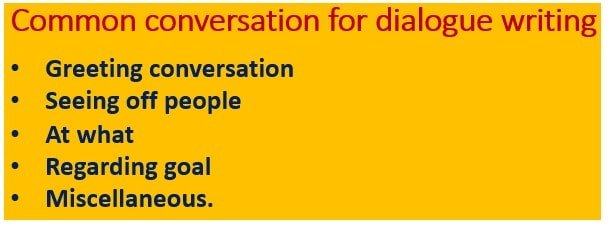
Greeting conversation starters are:
- Hello!/ Hi!
- Good Morning / afternoon / evening
- How are you? / How are you doing?
- Fine / Fine, thanks / Okay
- What’s new? / What’s new with you?
- Not much / Not too much
Seeing off people
- Good bye! / Bye!
- Good night!
- See you later / soon / tomorrow
- What class are you studying in?
- What is the name of your school?
- Which is your favorite subject? Why?
- How often do you participate in school activities?
Regarding Good
- What did you have for lunch?
- Which is your favorite cuisine?
- Which is your favorite ice-cream flavor?
- What do you like as your pizza topping?
Miscellaneous
- Do you have any plans for the weekend?
- What is your aim in life?
- If you had three wishes, what would they be?
- What do you do after school?
Dialogue writing Examples for class 6, 7, 8, 9, 10, 11, 12
Conversation examples for all classes 6 to 12, will help you to understand the topic more clearly. Conversation between teacher and student, father and son, passenger and booking clerk, these are some examples you will read below.
Dialogue writing between teacher and student
Read the given dialogues to understand more.
Conversation in a grammar class 6, 7, 8, 9, 10, 11, 12.
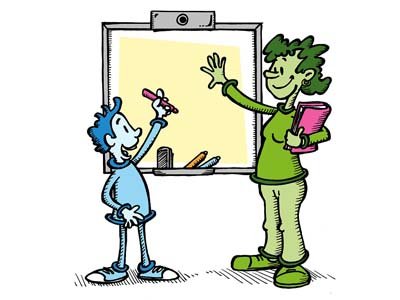
Teacher: Mona, sand up. What am I teaching?
Student: Sir, you are teaching grammar.
Teacher: Mona, look at the board. See the word – Adjective! Is the spelling correct?
Student: Yes, Sir. The spelling is correct.
Teacher: Can anyone tell me what a noun is?
Student: A noun is the name of a person, a place or a thing.
Teacher: Delhi is the capital city of India. Name any two nouns used in this sentence.
Student: Delhi and the city are the two nouns.
Teacher: What kind of nouns are they?
Student: Delhi is a proper noun and the city is a common noun.
Teacher: Period is over now. I’ll explain to you this topic tomorrow.
Dialogue writing between father and Son

Write a dialogue between a father and a son on ‘Career’.
Father: Now that you have appeared for the Class XII exams, what are your plans for the future?
Son: I have yet to decide. I think I’ll join some college.
Father: Don’t you feel that by now you should have decided your goal in life?
Son: My ultimate goal is to become a cricket player.
Father: It’s too late now. Have you ever played for your school team?
Son: I have played thrice.
Father: Well! If you were not a member of your school team you should forget about cricket.
Son: But father, I love cricket, I cannot stop playing it.
Father: You are a grown-up boy. Be serious and decide a suitable career for yourself.
Son: I will think again but I cannot promise.
Dialogue writing between passenger and booking clerk

Clerk: Good morning! How may I help you?
Passenger: I want a reservation of two tickets to Delhi.
Clerk: Have you filled the reservation form?
Passenger: Here it is!
Clerk: But there is no seat available on 25th January.
Passanger: Is there any seat available in Jan Shatabdi Express.
Clerk: Yes. There are two seats are available in Jan Shatabdi Express.
Passenger: What is the time of departure?
Clerk: The time of departure is 07:38 am.
Passenger: Please book two tickets. Thank you, Sir.
Dialogue writing solved examples
Dialogue writing between father and son

Complete the following dialogue.
Father: How dare you to confront me with this kind of failing grades?
Son: Well dad, do I have a choice? I had previously told you that this new school is not going to work for me!
Father: (a) _____________________________________________________
Son: (b) ______________________________________________________
Answer: (a) Don’t tell me such things. It was only after we’ve had those lengthy family discussions about the need for a change of your school that I took steps towards it. And you did approve of it.
(b) I did, but I don’t know why it doesn’t seem to be working as we had planned. I feel the teachers and students of this school are too advanced for me. Though my grades were falling in the previous school, I was able to mix more openly with everyone over there.
Dialogue writing question, worksheet
Under this, you have different types of dialogue writing questions, for example, Dialogue writing between mother and daughter, Mother and Son, Guide and Tourist, Between two Friends, Examiner and student.
Dialogue writing between mother and daughter

Complete the following dialogue between a girl and her mother.
Mother: I want you to learn to prepare a few dishes during these vacations.
Daughter: Is it really necessary?
Mother: (a) ______________________________________________
Daughter: (b) _____________________________________________
Mother: (c) _____________________________________________
Daughter: (d) _____________________________________________
Mother: (e) _____________________________________________
Dialogue writing between Mother and Son

Mother: I’ve been noticing that you are not paying heed to my advice these days. Is there something bothering you?
Son: Nothing in particular! Just that my exams are approaching and not much has been prepared by me till date.
Mother: Well, I can provide you some good advice for that as well. You pay attention to it.
Son: (a) ___________________________________________________
Mother: (b) _________________________________________________
Son: (c) ___________________________________________________
Mother: (d) _________________________________________________
Dialogue writing between Guide and Tourist

Read the following conversation between a guide and a tourist. Complete the blanks in a suitable way.
Guide: Sir, this way leads (a) ________ and this leads to the lakeside.
Tourist: (b) _________________ peak some other day. (c) _________________
Guide: (d) _________________ would you like to take a bath?
Tourist: A bath! In the frozen lake? No way. By the way, (e) _________________
Guide: Yes, Sir, They’ve (f) _________________
Tourist: (g) _________________ ! I’d love to go for ice-skating.
Dialogue writing between two friends
Friend 1 – Priyanka , 2 – Hemant
Priyanka: (a) _____________________________________________ !
Hemant: Actually, I am going for an interview.
Hemant: Well, It begins in half an hour.
Hemant: Oh! Come on. Who sticks to the watch?
Hemant: Yeah, I’ve called them up and secured an appointment for myself.
Hemant: Thank you so much.
Dialogue writing between Examiner and Student
Write the conversation between the examiner and the student. The student asks the examiner whether they will get an extra answer sheet or not.
Dialogue writing topics
There are so many topics search on google, Most search topics are given below if you want to read these topics comment below or contact us, we will reply as soon as possible:
dialogue writing between
- Two friends
- Teacher and student
- Doctor and patient
- Dialogue writing in English between two friends
- Teacher and student about exams
- Shopkeeper and customer
- Mother and son about vacations
- Teacher and student about studies
- Mother and daughter
- Bank manager and student for education loan
- Father and son
- Mother and daughter about vacations
- Principal and student
- Dialogue conversation between 6 friends
- Conductor and passenger
- Doctor and patient in hindi
- Father and son about studies
- Grandfather and grandson
- Grandmother and granddaughter
- Mother and daughter about junk food
- Mother and son
- Principal and parent
- Salesman and customer
- Shopkeeper and customer in hindi
- Student and teacher
- Teacher and student in hindi
- Cat and dog
- Coach and player
- Customer and shopkeeper
- Railway reservation clerk and passenger
- Two friends in the Marathi language
- Two students on the importance of sports
- Dialogue writing in English between doctor and patient
- Four friends
- A doctor and a patient
- The bank manager and customer
- Father and daughter
- Parent and teacher
- Patient and doctor
Dialogue writing PDF
Thanks for coming. If this article helpful, Please share!
Have any queries or questions ask in comment our team reply to you as soon as possible.
13 thoughts on “Dialogue writing in English, Examples, between, Topics, Question”
This is easy way to lean without feeling stress.
Thanks, Potluri Eswara Rao I will try to provide all types of writing skills.
Today, I went to the beach with my children. I found a sea shell and gave it to my 4 year old daughter and said “You can hear the ocean if you put this to your ear.” She put the shell to her ear and screamed. There was a hermit crab inside and it pinched her ear.
She never wants to go back! LoL I know this is completely off topic but I had to tell someone!
This was very helpful……but I wish u could provide us with the answers of the unsolved questions.
Happy to help! While I can’t provide direct answers, I’m here to guide you towards solutions.
Appreciate your perspective. Looking forward to more posts!
Thank you for your appreciation and will be uploading more very soon.
Thank you! Stay tuned for more engaging posts and updates.
Great to hear your positive feedback! We appreciate your support and encourage you to stay tuned for more exciting content.
Thank you for your kind words! We truly appreciate your support, and more content is coming soon. Stay tuned!
I want the solutions of the above topics of dialogue writing..
Waiting for your precious response
Hello! Here are some solutions of the same https://performdigi.com/dialogue-writing-for-class5/
Leave a Comment Cancel Reply
Your email address will not be published. Required fields are marked *
Save my name, email, and website in this browser for the next time I comment.
Notify me of follow-up comments by email.
Notify me of new posts by email.
Purdue Online Writing Lab Purdue OWL® College of Liberal Arts
Welcome to the Purdue Online Writing Lab

Welcome to the Purdue OWL
This page is brought to you by the OWL at Purdue University. When printing this page, you must include the entire legal notice.
Copyright ©1995-2018 by The Writing Lab & The OWL at Purdue and Purdue University. All rights reserved. This material may not be published, reproduced, broadcast, rewritten, or redistributed without permission. Use of this site constitutes acceptance of our terms and conditions of fair use.
The Online Writing Lab at Purdue University houses writing resources and instructional material, and we provide these as a free service of the Writing Lab at Purdue. Students, members of the community, and users worldwide will find information to assist with many writing projects. Teachers and trainers may use this material for in-class and out-of-class instruction.
The Purdue On-Campus Writing Lab and Purdue Online Writing Lab assist clients in their development as writers—no matter what their skill level—with on-campus consultations, online participation, and community engagement. The Purdue Writing Lab serves the Purdue, West Lafayette, campus and coordinates with local literacy initiatives. The Purdue OWL offers global support through online reference materials and services.
A Message From the Assistant Director of Content Development
The Purdue OWL® is committed to supporting students, instructors, and writers by offering a wide range of resources that are developed and revised with them in mind. To do this, the OWL team is always exploring possibilties for a better design, allowing accessibility and user experience to guide our process. As the OWL undergoes some changes, we welcome your feedback and suggestions by email at any time.
Please don't hesitate to contact us via our contact page if you have any questions or comments.
All the best,
Social Media
Facebook twitter.

AI Generator

Writing documents is already a part of the lives of people. May it be students who need to pass academic requirements or employees who are tasked to submit a written report, there will always be a reason why people will write within the scope of their functions and responsibilities.
Writing skills are essential to assure that the written output will be highly-usable and relevant to the reason why the document has been created. No matter if it is freelance writing or business writing, it is very important to always be aware of the format and content of a document. This post can help you create different kinds of articles and other written works through our curation of free writing examples and templates.
Summary Writing Example
Article writing.
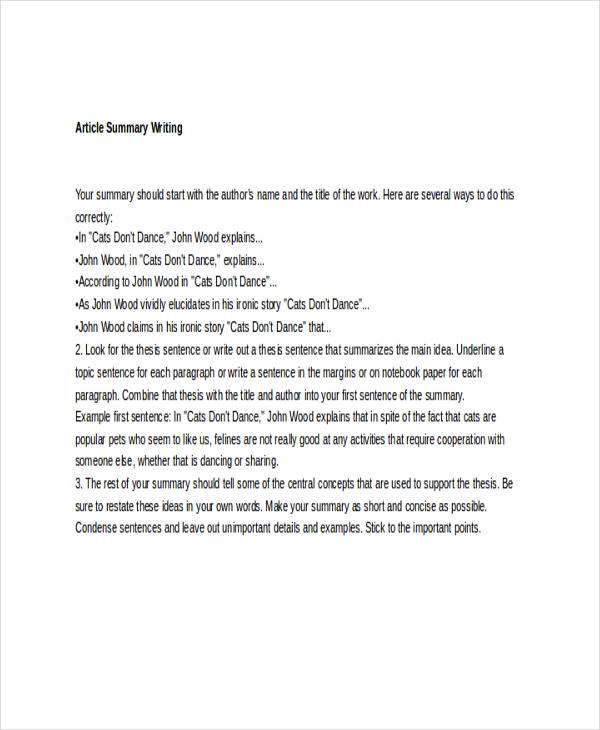
Report Summary

Abstract Writing
Scientific abstract.
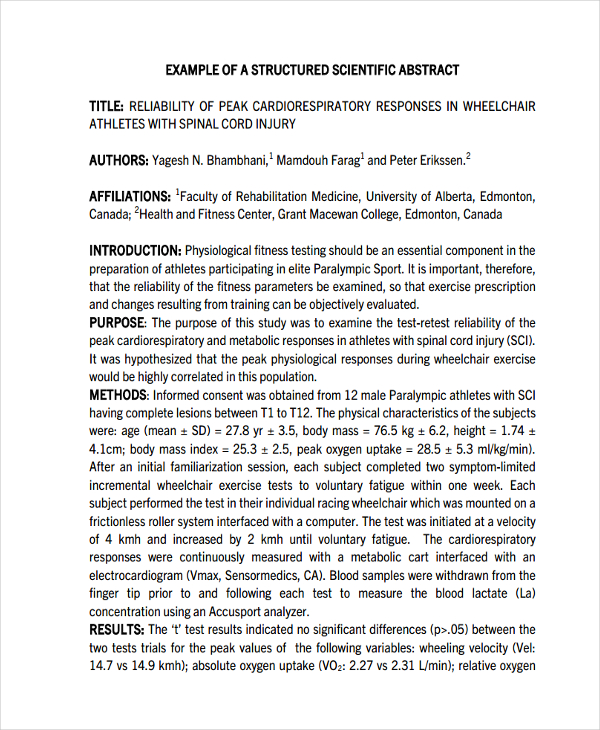
Size: 19 KB
Project Writing
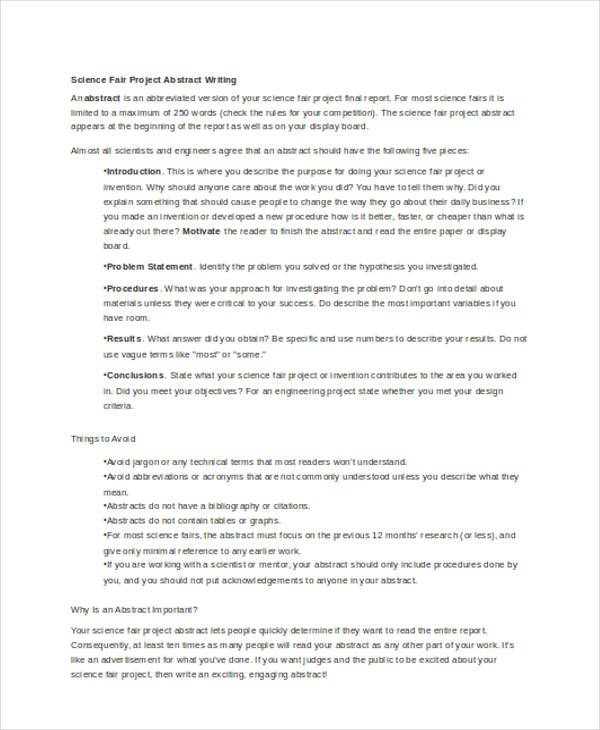
Research Abstract
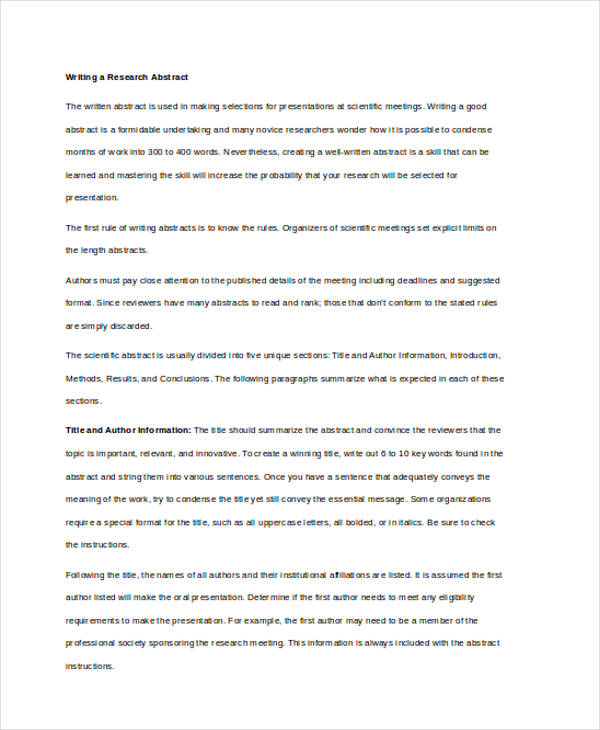
Technical Writing Example
Technical content.

Business Writing
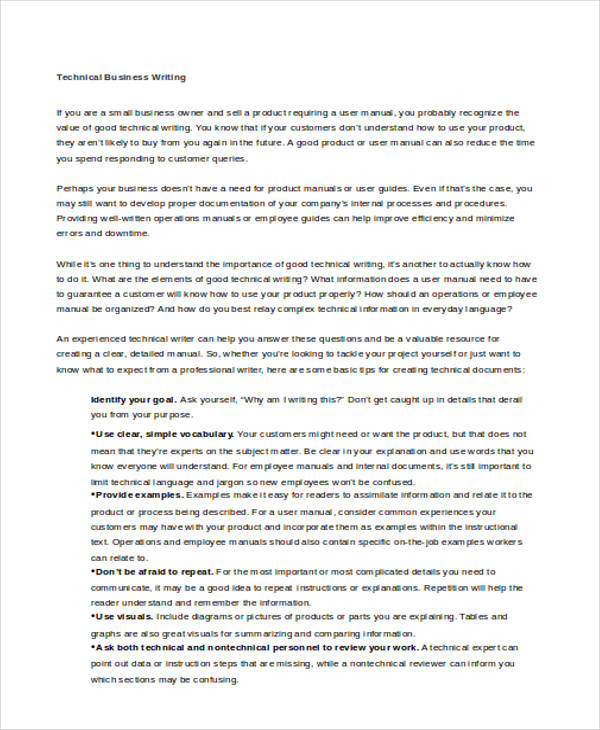
Technical Essay

What Are These Free Writing Examples?
writing examples in Doc are samples and templates of different kinds of documents that are written for specific purpose. There are different variations of writing examples and a few of them are as follows:
- Reports are considered to be performance-based and / or factual most of the time. Writing a report can be due to educational presentations, public announcements, organizational showcase and the likes.
- Letters can either be personal or professional. There are letters for appointments, business transactions, interviews and proposal templates . More so, letters can also be created to write an apology, an invitation and congratulatory messages.
- Print includes writing activities that are related to a variety of media and print platforms or mediums. It can be for magazines, newspapers, and any other physical copies of written information intended for public consumption.
How to Write a Report
One of the examples of documents that are needed to be keenly written is a report. Just like script writing examples , reports should be structured , organized based on plot discussion and should provide necessary information to the expected audience.
To write a comprehensive report, here are some of the steps that you may follow:
- Identify the purpose of the report and know the items that are important to be discussed, analyzed and / or presented.
- Know your audience so you can supply them with information that are related and aligned with their wants and needs.
- Research on the items of discussion that you will present so your report will be based on facts.
- Be precise with the things that you will place in the document especially if the report will be used for business transactions. More so, it is important for you to arrange the content of your report based on the formal report format applicable to be used in the process where the report is made for.
- Review the entire document and identify errors that should be corrected and areas that are needed to be improved.
Report Writing Example
Business report.
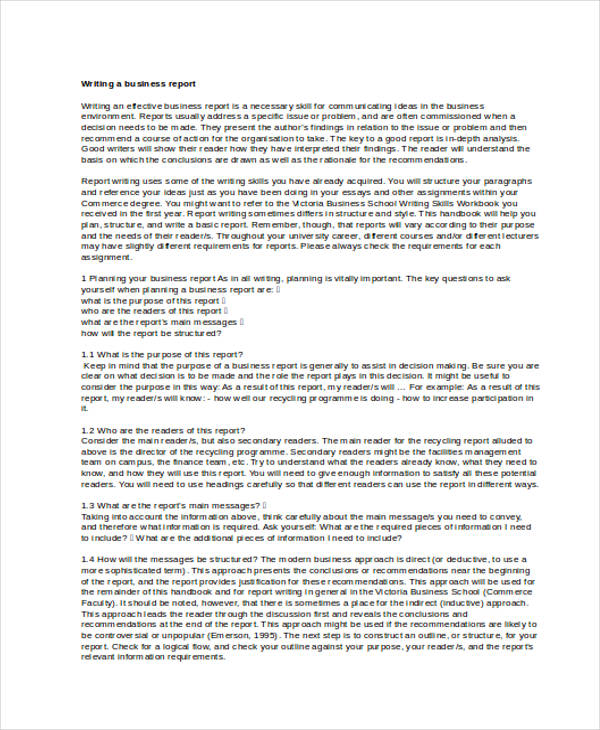
Newspaper Writing
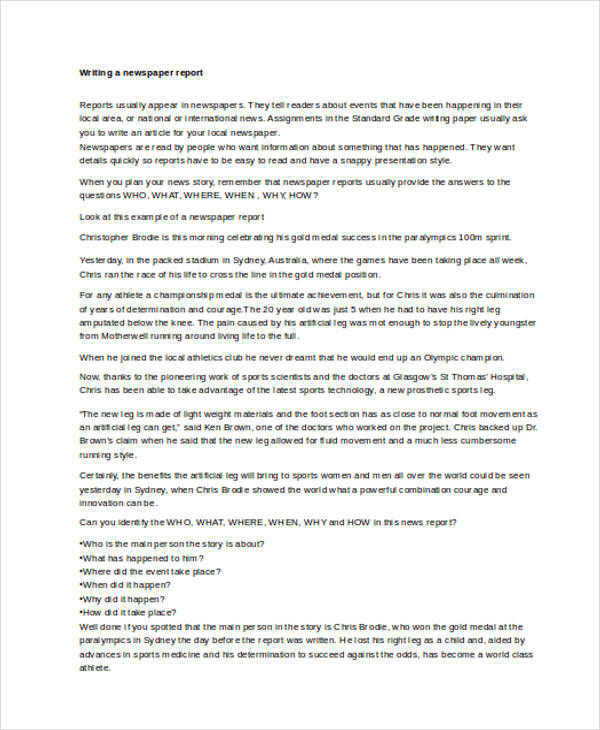
Student Report
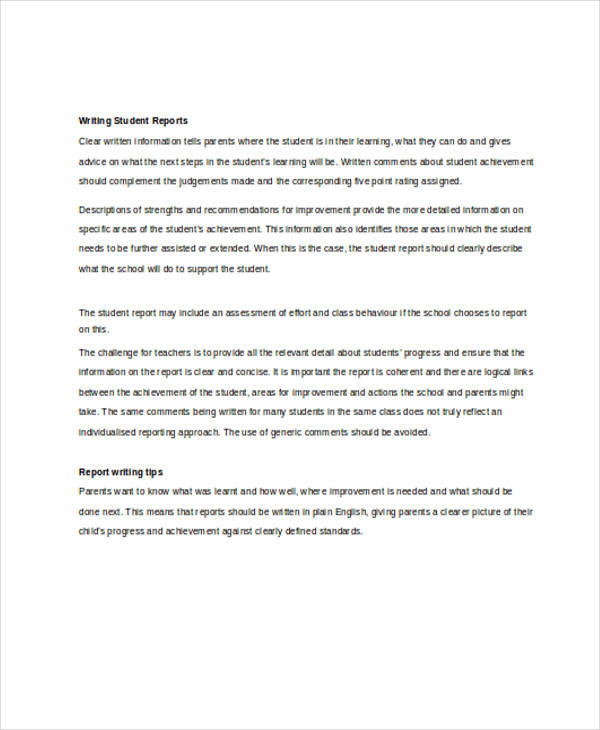
Formal Writing Example
Formal dialogue.
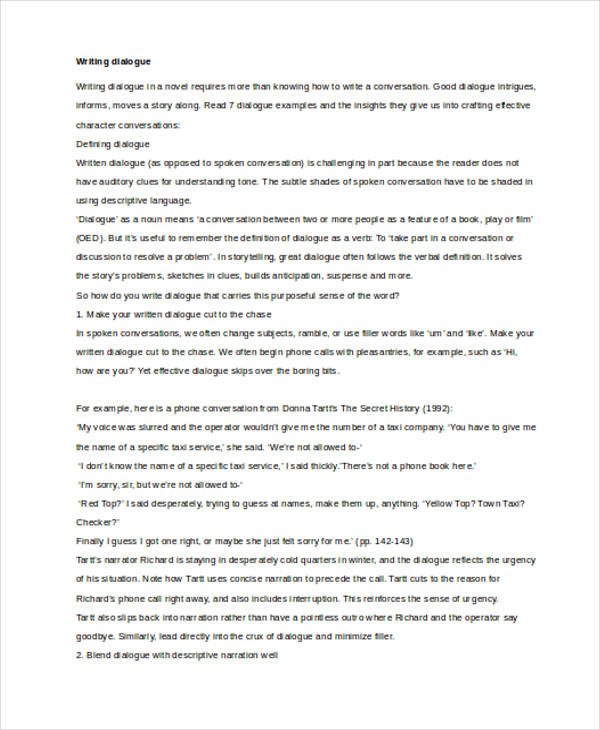
Essay Writing

Academic Formal
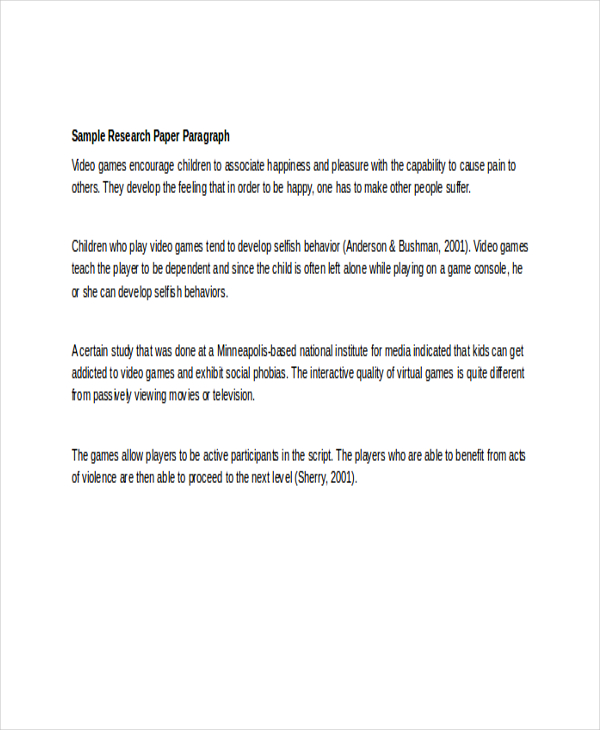
Article Writing Example
Magazine article.
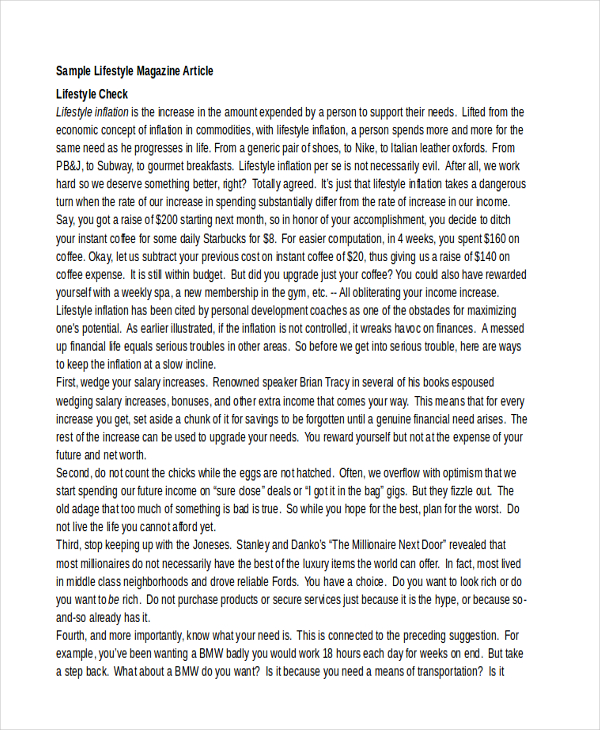
Research Article
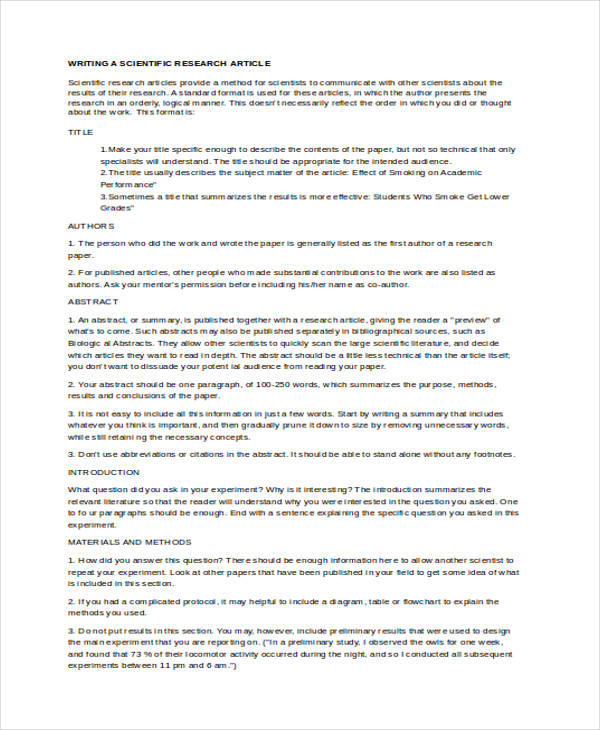
Guidelines from Writing Examples
Writing templates and examples serve as guides which can help people to format the content and layout of the documents that they need. Some of the tips and guides that you may incorporate in writing examples include the following:
- Know the software that is the most appropriate to be used for the written document. There are writing examples in PDF , DOC and Excel. Selecting the software where you will create the document will allow you to assure that formatting will be easier and that it can fully showcase the details that are necessary to be presented.
- Research on the specific formatting needs of documents. As stated above, use of writing examples have different natures of usages. There are some that are general in terms of content creation and there are also some that specifically addresses a function or an issue. Knowing the basic format of the sample document that you need to write will allow more people to use them as references.
- Be specific with the scopes and limitations of the usages of the example documents that you will make. Since the nature of written documents vary, there are also various entities who can benefit from their usages. If you will create any kind of written examples, you need to assure that people are well aware on where to use them, how to use them, and why it is necessary for them to refer to the example that you have made.
Descriptive Writing Example
Short descriptive.
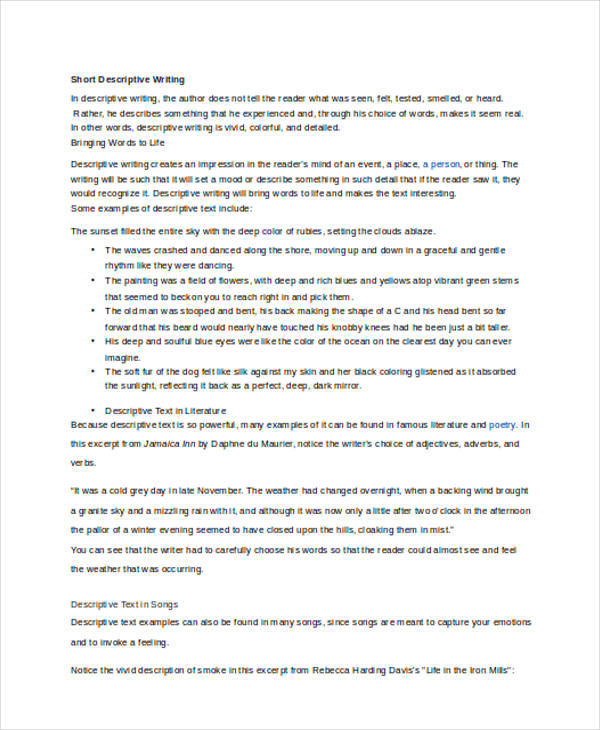
Teaching Writing

Book Writing Example
Comic book writing.
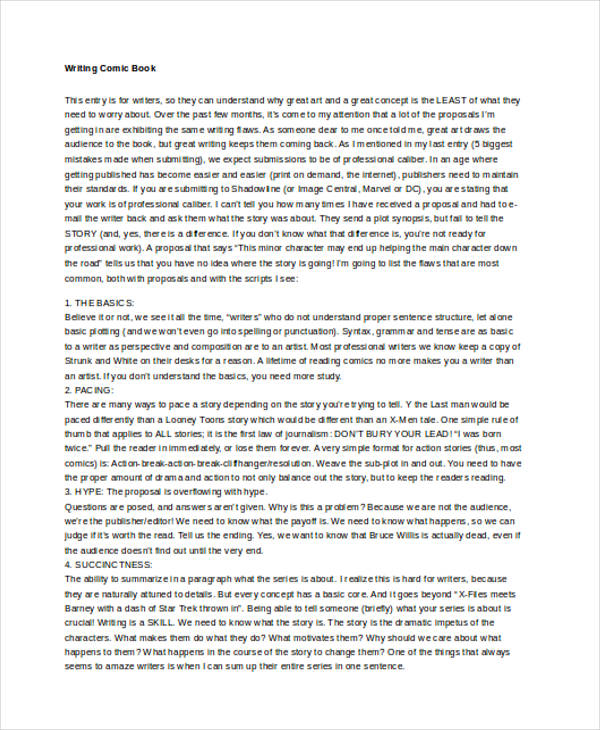
Application Writing
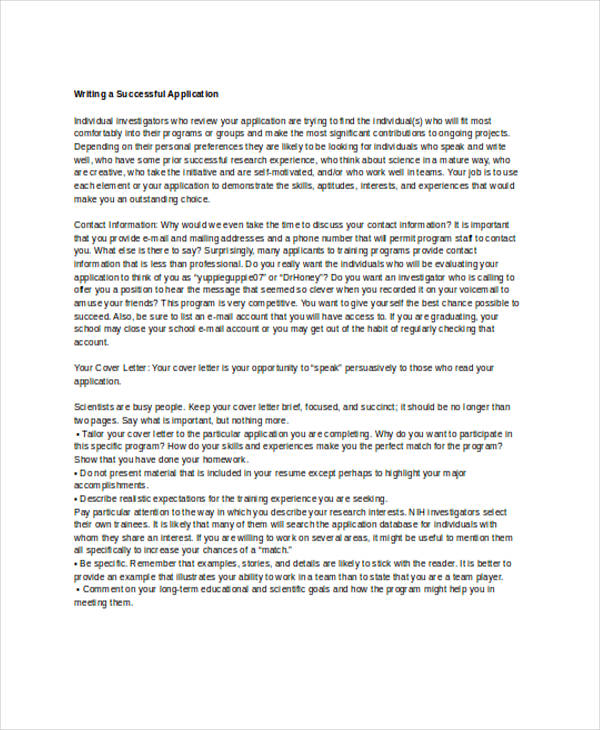
Expository Writing Example

Business Writing Example
Formal business.
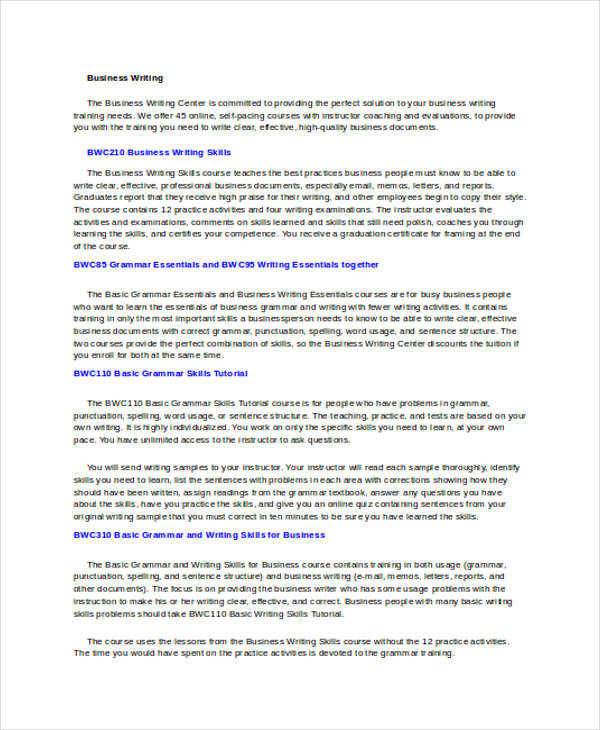
Professional Writing
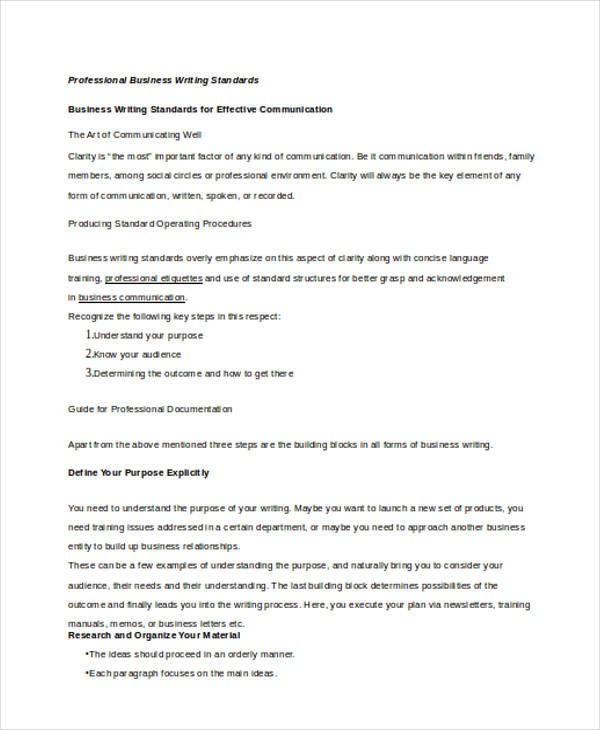
Effective Business
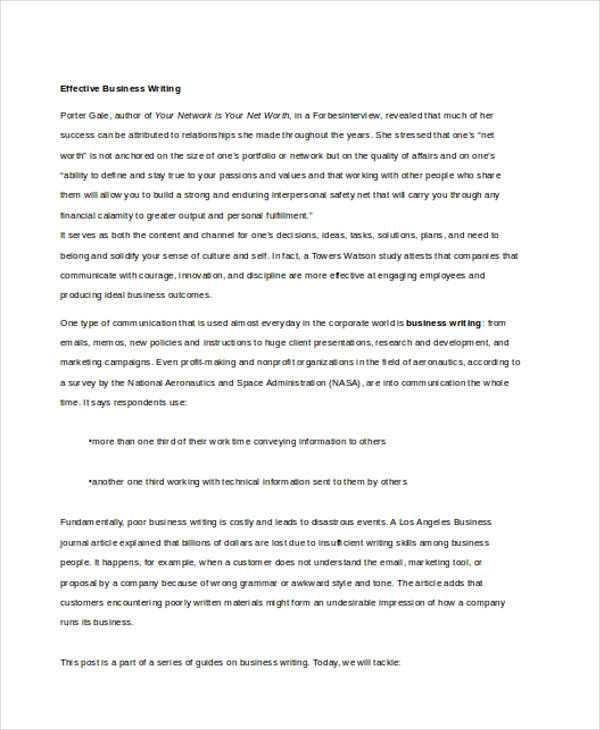
How to Improve Free Writing
Writing skills that is thought to an individual. However, it is only the technical aspect of the specified activity For you to be able to write a document, you need to be guided by both creativity and writing principles. You can improve on free writing by following these tips:
- It will be helpful if you will browse through different kinds of both informal and formal writing examples . This will help you to have an idea on how specific documents should be written and presented. Doing research is a way for you to widen your knowledge and perspective on different kinds of writing styles, techniques, and formats.
- Make sure that you already have an outline of the things that you would like to present in the document that you will make. Having an idea on how to discuss information will allow your written document to be organized, well-curated and informative.
- Be particular with what the document is for. There are abstract writing examples , business writing samples and other kinds of writings that are beneficial to different workflows and environments.
Helpfulness of Writing Examples
There are a lot of ways on how writing examples are beneficial to the processes of business writing and functions of individuals. Some of the purposes of writing examples are as follows:
- To help students with regards to the report writing , projects and assignments that they need to create
- To provide references to employees who need business document samples usable for corporate presentations and meetings
- To guide freelance writers with the formats that they can use for their work functions and other writing commitments
- To be used as examples by researchers and other professionals who need to properly curate documents necessary for the situation or instance where they are currently involved in
Narrative Writing
Teaching narrative.
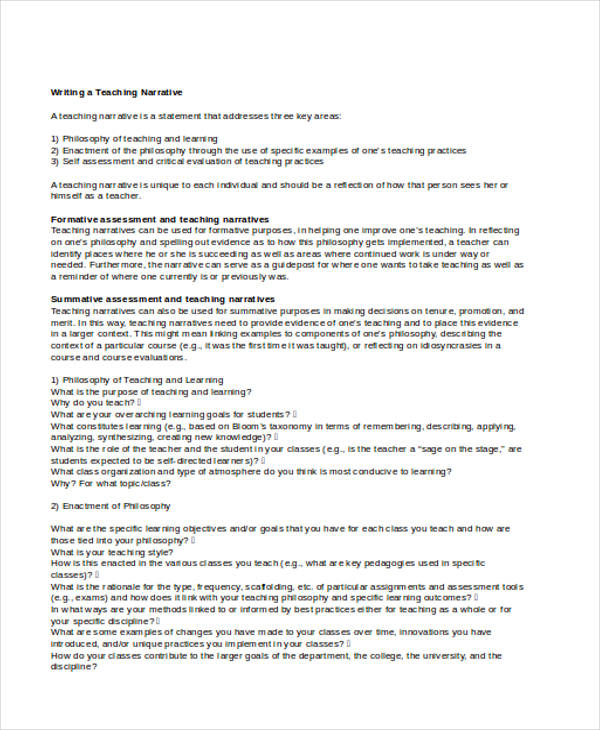
Medical Writing
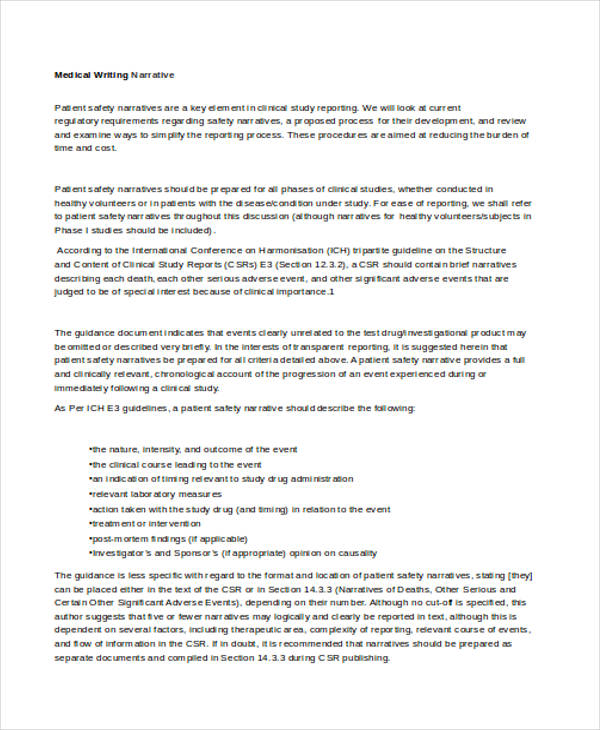
Personal Narrative
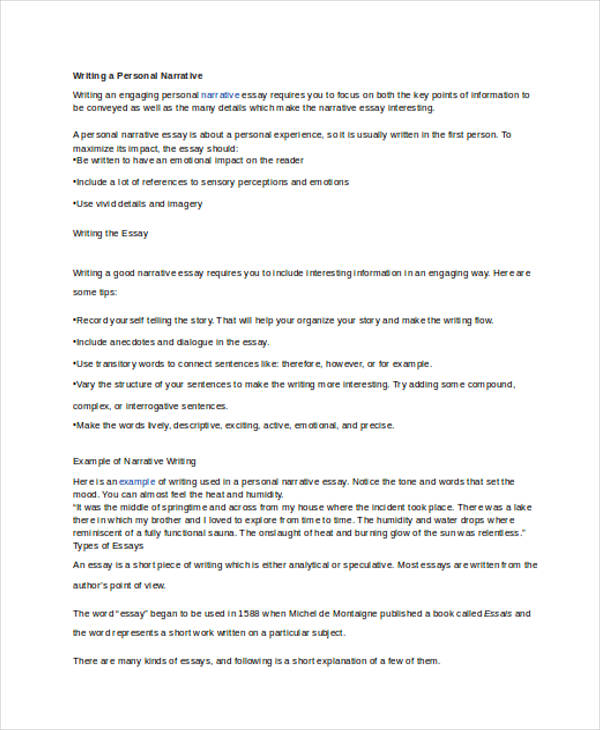
Act Writing Example

Essay Writing
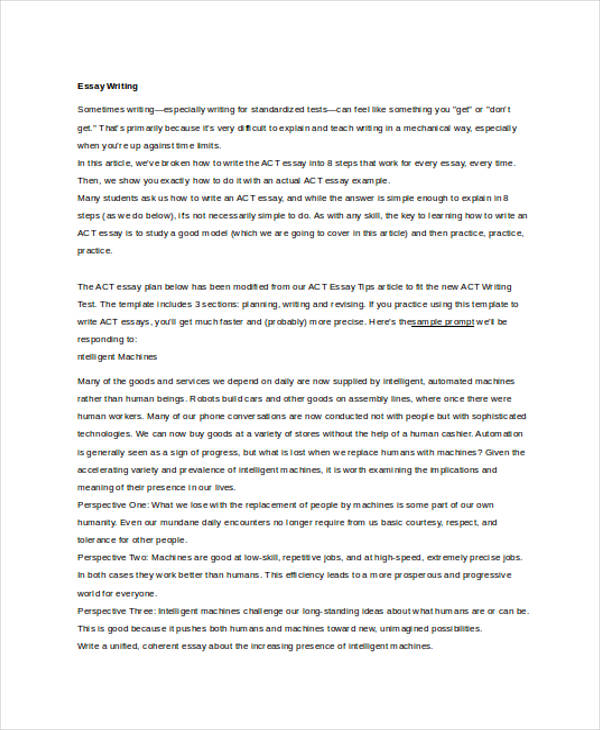
Script Writing
Documentary writing.
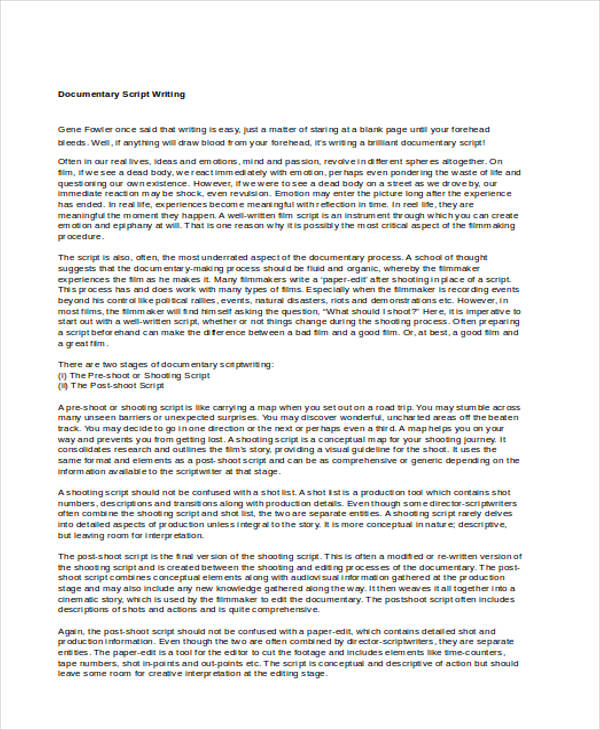
Reflective Writing Example
Personal writing.
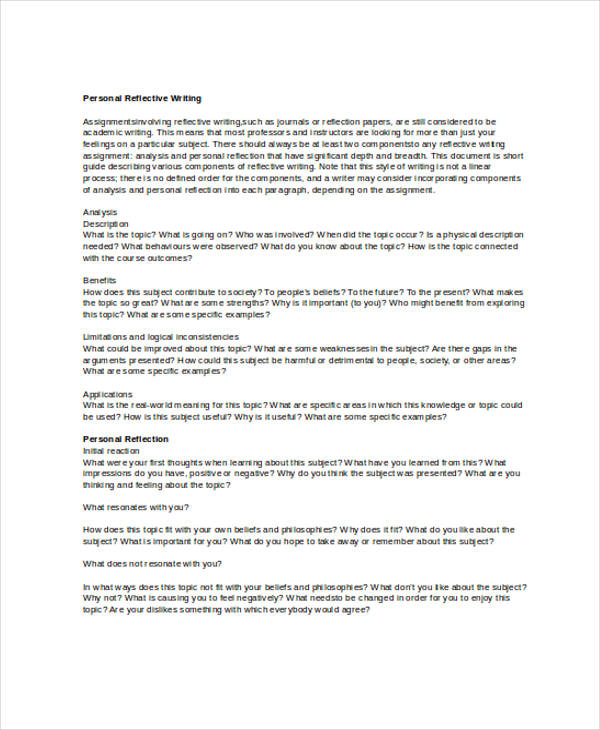
Benefits of Writing Samples
The usages of writing samples can be very helpful to different entities. Some of the benefits of writing samples include the following:
- Business writing examples can help professionals a lot in terms of creating corporate documents may it be used by the management, the entire operational team, or specific corporate departments. Business write-ups are commonly found on corporate magazines, brochure examples , online pages of establishments and the likes. These written documents are made to provide information to the people within an industry with regards to field updates and other changes necessary for the development of businesses and other enterprise.
- Academic essays samples can be written to allow students refer to documents that can help them achieve a part of their curriculum requirements. Most essays written within a school are related to language, science, and history. Starting an essay is given as an activity to students as it can provide information on how students are able to grasp the topic that is being discussed.
- Having writing samples can make a writing activity easier and faster.
- Using writing examples will make the process of writing more structured, complete, and beneficial to the entities to whom the written documents are for.
Having writing samples can provide a lot of advantages. It is all up to you on how you will use them appropriately especially in relation to the functions that you would like them to serve.
Text prompt
- Instructive
- Professional
10 Examples of Public speaking
20 Examples of Gas lighting

IMAGES
VIDEO
COMMENTS
Here are a few tips: Strong Dialogue Tags: Sometimes, you need to be more specific than just "he said" or "she said". Example: "Don't be ridiculous," scoffed Sarah. Action Beats: Break up chunks of dialogue with actions that show who's speaking. Example: Tom slammed his fist on the table. "I won't stand for this!".
Enroll now. 4. Kazuo Ishiguro, Never Let Me Go. Here, friends Tommy and Kathy have a conversation after Tommy has had a meltdown. After being bullied by a group of boys, he has been stomping around in the mud, the precise reaction they were hoping to evoke from him. "Tommy," I said, quite sternly.
Format & Punctuation. Examples. Tips for Dialogue. Say the dialogue out loud. Cut small talk when writing dialogue. Keep your dialogue brief and impactful. Give each character a unique voice. Add world-appropriate slang. Be consistent with the characters' voices.
Place a comma after the dialogue tag followed by open quotation marks, the dialogue starting with a capital letter followed by the punctuation mark of the quote and close quotation marks. For example: Josh mumbled, "Nobody understands the main problem here.". A dialogue can also appear at the end of the sentence.
These beats are a commonly used technique so you can find plenty of examples — here's one from Never Let Me Go by Kazuo Ishiguro . 4. Use 'said' as a dialogue tag. If there's one golden rule in writing dialogue, it's this: 'said' is your friend. Yes, 'said' is nothing new.
Dialogues from Literature. Example 1: Here are a few dialogue examples from the fable 'The Tortoise and the Hare'. Pay attention to how the dialogues are crafted. The hare, boasting of his speed, said to the tortoise, "I bet I could beat you in a race any day!" The tortoise, unfazed, replied, "I accept your challenge.
Tip #2: Write Realistic Dialogue. Good dialogue should sound natural. Listen to how people talk in real life and try to replicate it on the page when you write dialogue. Don't be afraid to break the rules of grammar, or to use an occasional exclamation point to punctuate dialogue.
Here are the need-to-know rules for formatting dialogue in writing. Enclose lines of dialogue in double quotation marks. This is the most essential rule in basic dialogue punctuation. When you write dialogue in North American English, a spoken line will have a set of double quotation marks around it. Here's a simple dialogue example:
Dialogue Writing Tips. The most common way to indicate a new speaker's dialogue is to start a new paragraph. Here is an example from my novel Touched: Rashan slouched into a nearby folding chair, not bothering to get one for Georgia. He moved a few braids from his forehead, but they fell back over his eyes.
4. Use dashes and ellipses to cut sentences off. 5. Deploy single quote marks used for quotes within dialogue. 6. Don't use end quotes between paragraphs of speech. 1. Always put commas and periods inside the quote. The misplacement of periods and commas is the most common mistake writers make when punctuating dialogue.
Example: Sarah hesitated, "Well, you see, it's about the job offer I got…". Consider Dialect and Slang: If appropriate, use dialects or slang to make dialogue authentic. Example: James grinned, "You're gonna rock that job, no doubt!". End with Purpose: Conclude the dialogue with a purpose or a question, encouraging continuation.
Put quotation marks around the words that actually come out of a person's mouth. Punctuation goes inside the quotation marks. Use commas or periods after dialogue tags depending on where they are in the sentence. Capitalize the first word of what the person says. Start a new paragraph each time a person speaks.
RULES FOR WRITING DIALOGUE The following rules should help you learn to write dialogue properly. Notice the punctuation in the following examples, especially. In addition to these hints on form, please remember that dialogue should be natural for the characters speaking (be sure to keep in mind your characters' personality traits). 1.
How To Format Dialogue (Formatting Dialogue Examples) When writing a manuscript, begin the first line of each paragraph indented. If using British English, use single quotation marks. If using American English, use double quotation marks. But whatever the region, enclose the spoken words inside the quotation marks.
Points to be Remember. 1. The students need to read the preceding and the following dialogues. 2. They must understand the topic well and make points. 3. The tenses should be accurate according to the dialogue. 4. It should seem like a natural conversation.
DIALOGS FOR EVERYDAY USE. Short Situational Dialogs for Students of English as a Foreign Language. Julia M. Dobson Dean Curry, Editor Language Notes by Anne Covell Newton. First published in 1980 Second printing 1994 by the English Language Programs Division of the United States Information Agency, Washington, DC.
0:00 - Introduction to Dialogue3:45 - Dialogue Writing5:06 - Characters in Dialogue Writing5:33 - Important points for Dialogue Writing9:58 - Summary#Dialogu...
Rule #3: Comma Placement is Dictated by Speaker Attribution. The majority of written dialogue is attributed to a speaker using dialogue tags. This helps a reader keep track of who is speaking, especially when back-and-forth dialog is used between two or more characters. An attribute is a simple way to give credit to a speaker.
Dialogue Writing Examples #7. Dr. Sunil: This is the third time in two months you have come to me complaining of stomach ache, Rakesh. Have you been eating frequently from outside? Rakesh: I have my lunch from the school canteen, doctor.
Dialogue Writing Practice Example for Class 10 CBSE. 1. You go to borrow a book from the library, but the librarian says a book has been issued to you three weeks ago and is overdue. Talk to your librarian explaining why you need this book you are asking for now. Also explain why the other book is overdue. Write the conversation in 100 words. 2.
Under this, you have different types of dialogue writing questions, for example, Dialogue writing between mother and daughter, Mother and Son, Guide and Tourist, Between two Friends, Examiner and student. Dialogue writing between mother and daughter. Complete the following dialogue between a girl and her mother.
The Purdue On-Campus Writing Lab and Purdue Online Writing Lab assist clients in their development as writers—no matter what their skill level—with on-campus consultations, online participation, and community engagement. The Purdue Writing Lab serves the Purdue, West Lafayette, campus and coordinates with local literacy initiatives.
Guidelines from Writing Examples. Writing templates and examples serve as guides which can help people to format the content and layout of the documents that they need. Some of the tips and guides that you may incorporate in writing examples include the following: Know the software that is the most appropriate to be used for the written document.
If you learn prompting better in combination with code and applied examples of interesting use cases, visit the Anthropic cookbook instead. There you'll find copy-able code that demonstrate how to use Claude in neat and effective ways in more advanced scenarios, such as uploading PDFs, tool use and function calling, embeddings, and more.